victoria to sitka logbook
transcript
On the passage from Victoria to Sitka we traveled 1,800 NM, the journey lasting from May 1st to August 11th 2024. Rek kept a logbook of our travels, to help us remember the conditions we encountered, our thoughts at the time, etc. Sailing near shore, we think, is more difficult than sailing offshore, there are more obstacles to deal with, like traffic, reefs, currents, and land effects on wind.
Our aim was to get near 58°N, the highest we sailed on this trip was 57°N. We wanted to explore Southeast Alaska and the north coast of British Columbia, to experience anchoring in deeper waters, and to see if we could enjoy sailing in colder, rainier weather.
| Week 1 | |
|---|---|
| May 1st | Victoria to Sidney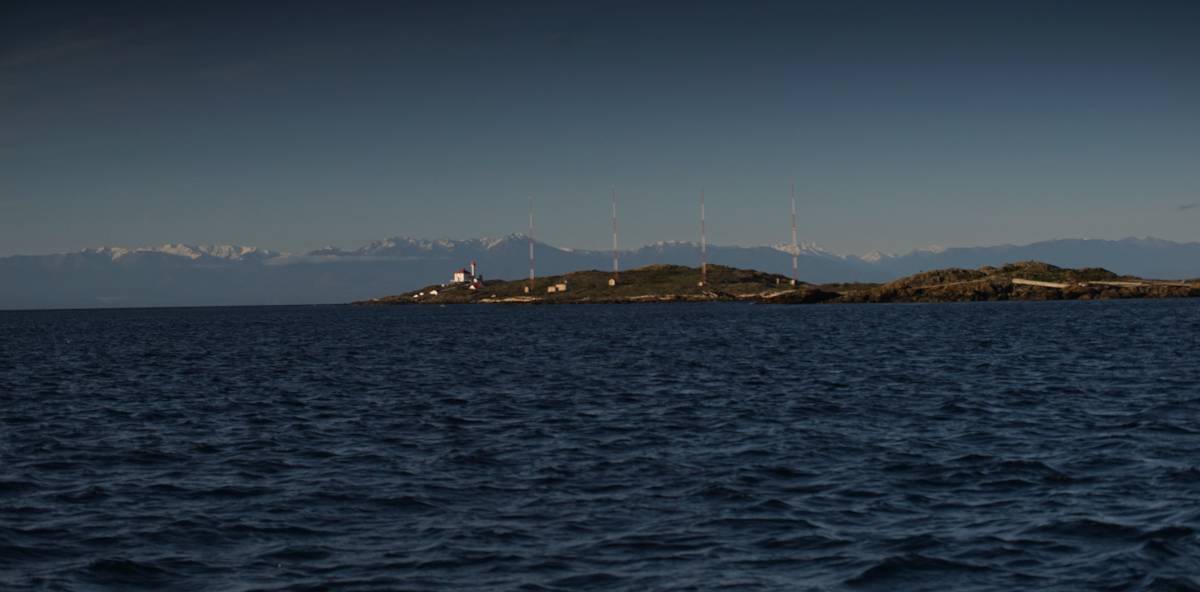 I awoke to an awful sound, an alarm ringing at 0540. Devine had been waking up at 0600 every second day all year to go to the gym, and so was used to this, but I could not find my feet. The morning was rude, I couldn't persuade my body to leave the bed to face it — it had taken us so long to build up this much warmth! I knew that current waits for no one, and so with eyes still closed, my legs crawled out of the blankets, my body inevitably followed, ragdolling out of bed and into the cold. I awoke to an awful sound, an alarm ringing at 0540. Devine had been waking up at 0600 every second day all year to go to the gym, and so was used to this, but I could not find my feet. The morning was rude, I couldn't persuade my body to leave the bed to face it — it had taken us so long to build up this much warmth! I knew that current waits for no one, and so with eyes still closed, my legs crawled out of the blankets, my body inevitably followed, ragdolling out of bed and into the cold.We got dressed, to preserve what little warmth we had left, then made sure that everything aboard was secured for our sail to Sidney. We're always forgetful when we haven't sailed in a while. In the winter, the boat is still, so still that it becomes part of the land. Pino sways at the dock in heavy winds, but nothing threatens to fall over, the motion is never violent. Now, each item must go back to its assigned spot, lashed down. There is light outside at this hour, it helps, but waking before the birds is not right. As soon as we moved outside, Peter, our dock neighbor and good friend, was there to greet us. Peter, like myself, doesn't share Devine's early hour waking habit, but he knew we were leaving, and made an effort to be there to say goodbye. Even at this early morning hour, Peter looked as dapper as ever, Peter, who goes to the gym in corduroy pants and button down shirts. We hug, he helps us push off. |
| Pino glided away from the dock on calm waters, propelled by Calcifer II. Our departure awoke another neighbor, Gunther, he was outside, and he too waved us off, "where are you going again?" he asked. "Alaska!" we whisper-shouted back as we drifted past — it was early, we didn't want to make more noise than necessary. The little ephemeral floating community we'd found was precious, like birds returning to land to nest every year, we all gather in the fall, and come spring, everyone flies away. Some birds return to the nest, others don't, drawn by the allure of distant lands. A light breeze greeted us at the mouth of the outer Victoria Harbour, we hoisted Pino's wings inside the calm of the breakwater. When out in the Juan de Fuca Strait, the body of water that we must cross to get to Sidney, the wind was not strong enough to push us by itself. Calcifer II continued to provide help. |
|
| Last winter, we built our own gimballed stove, we tried it for the first time underway. I toasted bread in our heavy cast iron pan, then coated one side of the crunched-up exterior with peanut butter. While we ate our breakfast, I boiled water to thin the moka pot coffee — doing this fools us into thinking there is more coffee to drink. I passed the grinder to Devine outside who was steering and holding the tiller with one leg. We had modified our tiller head for this trip, it was now low enough that we could steer like this, freeing our hands for other tasks. We bought this wooden tiller at a scrapyard in Sonoma(California) in 2016, when sailing down the west coast of the United States. The head, which binds the tiller to the rudder stock, forced it at an angle that was abnormally high for steering, but the tiller itself was perfect. We rectified the design this year, but only because a crack had formed in the head which forced us to put together a makeshift replacement, consisting of an aluminum pipe, several heavy bolts and bungees. When the water in the kettle was hot, I switched it for the moka pot and completed our breakfast routine. The boat wasn't heeling enough for this to be a good first test for our stove, but the unit performed well. | |
| Victoria is on the south end of a peninsula to the southeast of Vancouver Island, Sidney is on the northeastern end of this same peninsula, 25 NM away. When we turned around the south end of the peninsula, the wind left us, as it tends to do in this area. The wind only ever bends around the corner when Juan de Fuca is in a bad mood. The calm lured out several small fishing boats. We laughed, seeing the number of gulls at their heels. Each boat had its own little gull fan club. Some gulls were resting on the cabin tops, the rest were in the water, paddling around, waiting for scraps or for space to free up on the boat. We wondered if the people on those boats liked the gulls. Were they friends? Did they give them names? Or were they a terrible nuisance? | |
| The wind returned south of James Island, we rode it into Sidney, arriving at 1100. | |
| May 2nd | Sidney to Montague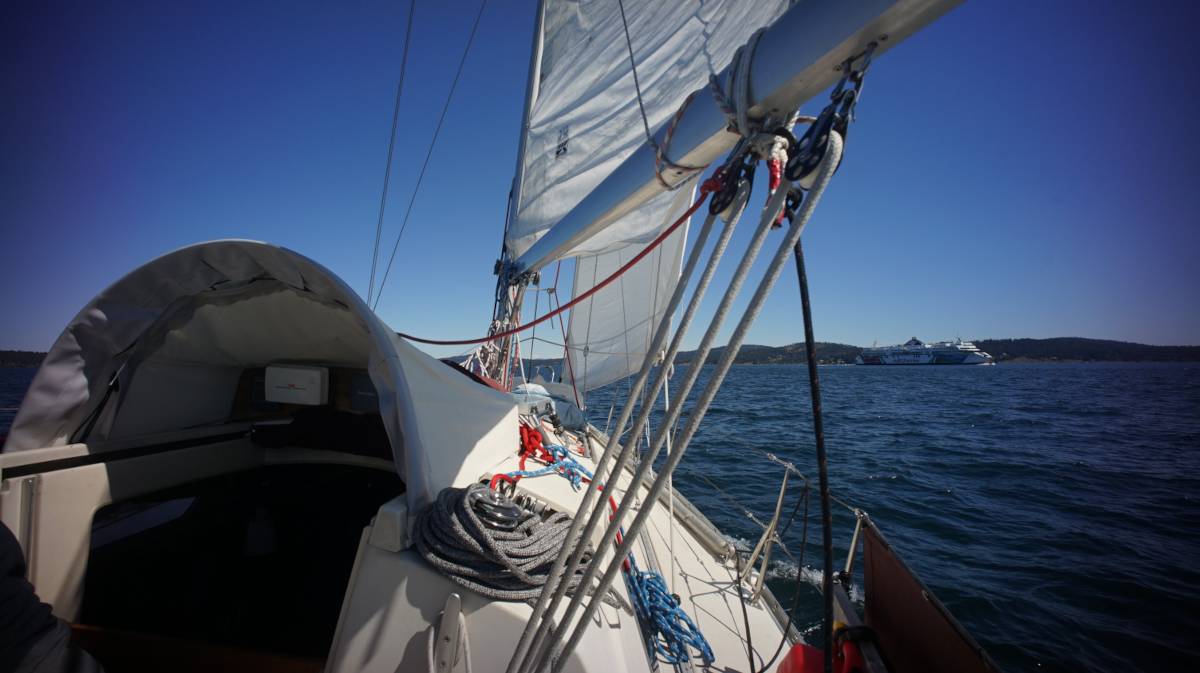 The alarm rang at 0600, we snoozed until 0640, then left at 0800 to catch the current north to our next anchorage. Bing, bang, boom. After pushing off the dock, we pulled onto another to fill 4x20 L bins with diesel — our main fuel tank only holds 62 L, keeping annexes aboard is necessary for long coastal trips. We hoped the wind would be a frequent companion on our trek north. The alarm rang at 0600, we snoozed until 0640, then left at 0800 to catch the current north to our next anchorage. Bing, bang, boom. After pushing off the dock, we pulled onto another to fill 4x20 L bins with diesel — our main fuel tank only holds 62 L, keeping annexes aboard is necessary for long coastal trips. We hoped the wind would be a frequent companion on our trek north. |
The wind was blowing out of the northeast, but we only felt it once past Portland Island. It was coming out of where we needed to go, but as strange as it sounds to those unacquainted with the physics of sailing, a sailboat can work with this. We tightened the sheets and sailed into the wind, tacking as required. Devine read through a thick book documenting Southeast Alaska anchorages, while I, at the tiller, counted cormorants in the water. We saw a group of 30 near Portland Island, with a few gulls amongst them. The gulls were outnumbered, out of place, surrounded by cormorant heads — both were easy to distinguish from afar, because cormorants sink, while gulls float.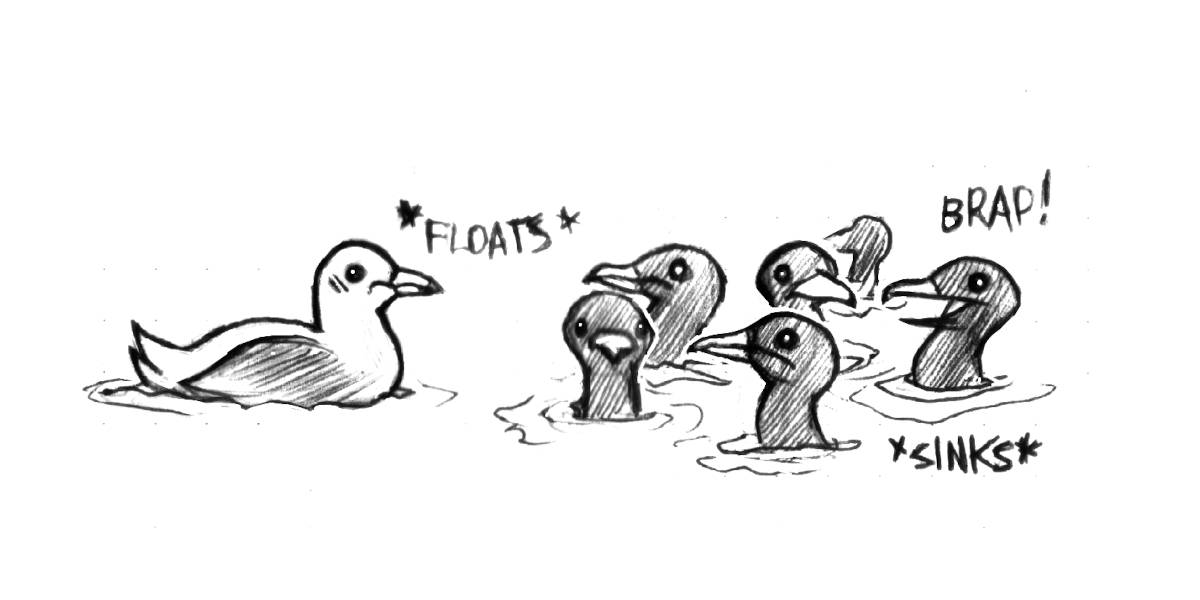 We played dodge-the-ferries, while tacking northward, until the breeze became too weak to sail with. Calcifer II carried us the rest of the way to Montague Harbour. We arrived at 1300. Tacking had added 3 extra nautical miles to our trip. Sailing into the wind is not the quickest way forward, we can't be in a hurry, but timing matters when sailing in waters governed by strong currents. The current reverses many times per day, when it turns against us, progress is slow, and depending on the strength of the current it can stop our vessel outright. If the wind isn't with us, with a current running, progress is a beautiful dream. Our motor can carry us through some current, but it feels like throwing money into the ocean. In these waters, seeing sailboats motor into the wind, constrained by a short tidal exchange, is common. We played dodge-the-ferries, while tacking northward, until the breeze became too weak to sail with. Calcifer II carried us the rest of the way to Montague Harbour. We arrived at 1300. Tacking had added 3 extra nautical miles to our trip. Sailing into the wind is not the quickest way forward, we can't be in a hurry, but timing matters when sailing in waters governed by strong currents. The current reverses many times per day, when it turns against us, progress is slow, and depending on the strength of the current it can stop our vessel outright. If the wind isn't with us, with a current running, progress is a beautiful dream. Our motor can carry us through some current, but it feels like throwing money into the ocean. In these waters, seeing sailboats motor into the wind, constrained by a short tidal exchange, is common. |
|
We arrived in Montague Harbour, a large anchorage on Galiano Island that can host hundreds of boats, dropping our anchor in 11 m(35 ft). The bay hosts several local boats on moorings, but was otherwise empty. Despite there being large areas free of anchored boats, a large motor boat came into the anchorage, 20 minutes after we had arrived, and dropped their anchor very near ours. Pino is a shiny lure, drawing the attention of bigger fish.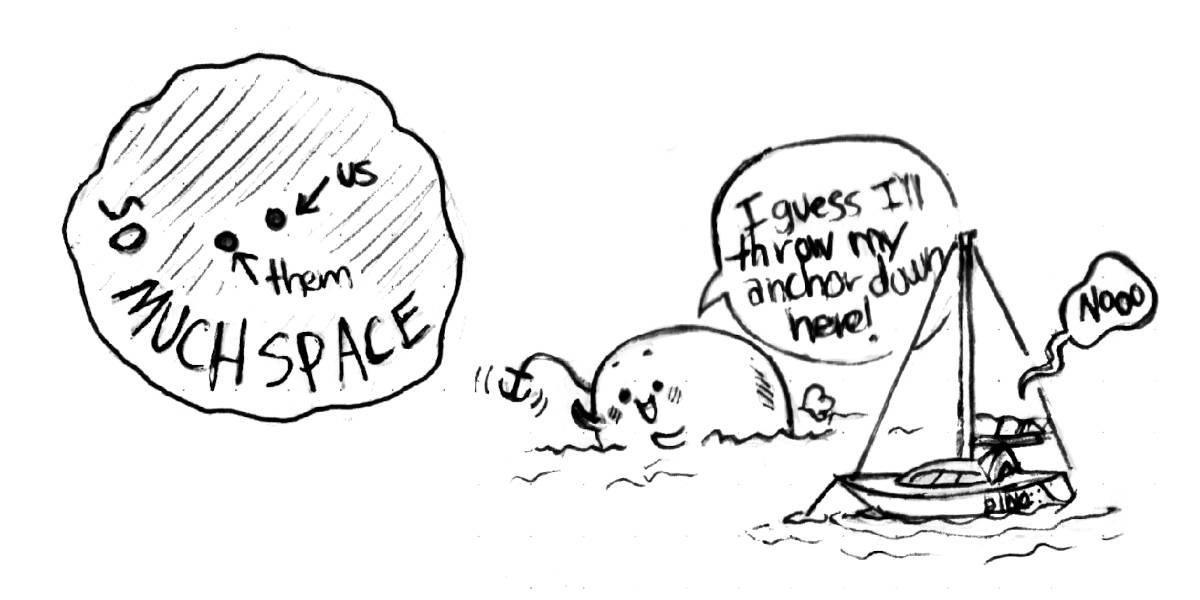 Inside the cabin, we picked up a few disobedient items that had rolled out of their berths. Some items had found the floor, "this isn't your room," I said, remembering the classic line said by Tom Hanks to a dog in Turner and Hooch — sometimes I fear that too many of my words are borrowed from films. Inside the cabin, we picked up a few disobedient items that had rolled out of their berths. Some items had found the floor, "this isn't your room," I said, remembering the classic line said by Tom Hanks to a dog in Turner and Hooch — sometimes I fear that too many of my words are borrowed from films.We prepared basmati rice with sauteed sweet potatoes, tofu, and greens, seasoned with soy sauce and mirin, with a side of miso soup. |
|
| That night, we continued reading The Martian by Andy Weir. In the book, Mark Whatney must be self-sufficient, he must ration his food to survive. With our upcoming trip, we don't have to ration, our time away from others won't span 4 years, but we do need to be cautious with both food and water. At sea, Pino must be an island. | |
| May 3rd | Montague The wind was too light to sail, so we waited in Montague for an extra day. Avi sent us a message, asking if we'd like to go see the Recycling Center's new plastic crusher and press. We rowed Teapot to shore and met Avi at the dinghy dock, he gave us a ride to the Recycling Center. |
| The new machines transformed plastic waste into new materials, which locals could use to produce art, for construction, or to make replacement parts at home. Same type plastics were gathered — polypropylene, polystyrene, etc. The shredder reduced the plastic into smaller pieces, and a separate machine, a heated hydraulic press, softened and merged the bits into a solid sheet. The size of the sheet depended on the amount of shredded plastic, and the sheet thickness(adjustable with the press). Mixing different colored plastics resulted in a gorgeous mandala daubed with bright and glaring patterns. Ading a single shredded bottle of yellow mustard created amazing contrast. The sheet of plastic ressembled a painting, born of plastic waste. Previously, Galiano Island was exporting all of its plastic waste to the Vancouver mainland, a lot of it now stays on the island, given a second, and hopefully lasting purpose. The recycling center was across from a building that accepts second hand goods, all from residents of Galiano. The center separates all recyclables so they are better processed — just like in Japan. The rest of British Columbia doesn't discern between different kinds of plastics, it also doesn't recycle glass... which is... insane. |
|
| May 4th | Montague to Secretary Islands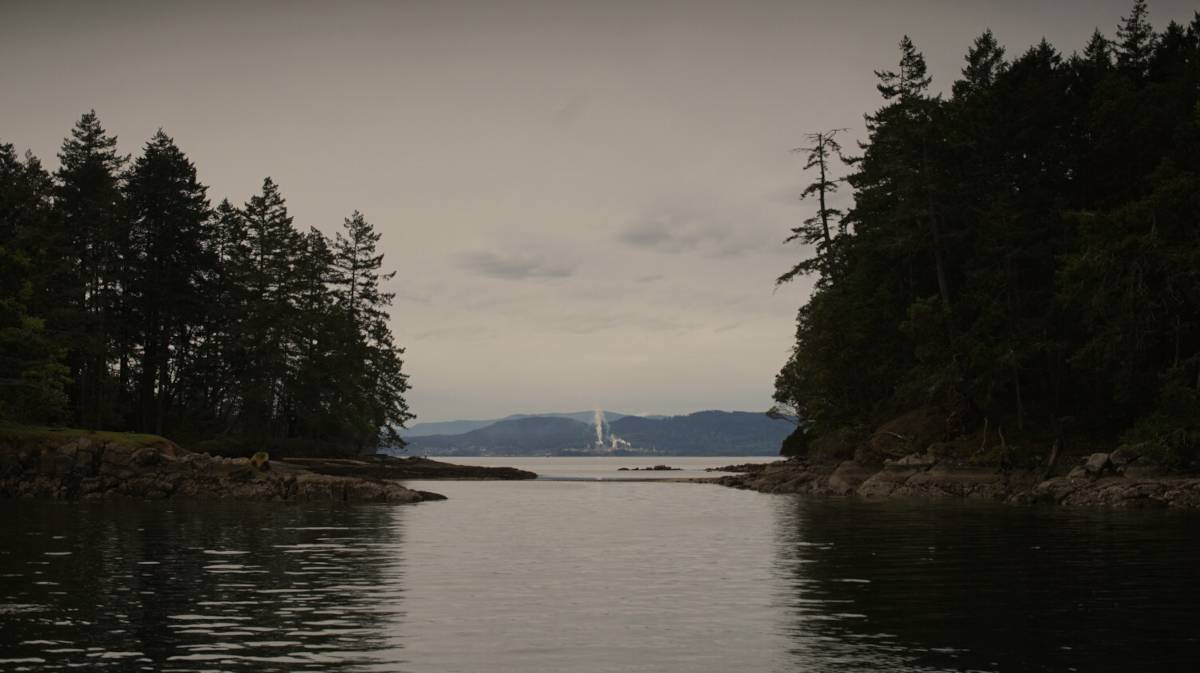 0830 departure from Galiano Island, with the goal of stopping either at a bight between the Secretary Islands, or at Clam Bay, a short 10 NM sail away. We needed an anchorage that offered protection from both the SE and NW — a difficult find in these waters, given the fact that most bays have either a SE or NW orientation. Montague fits that description, but it was too far south, we wanted to be near Porlier Pass to exit at slack current come morning. The Gulf Islands are surrounded by natural barriers, rapids that prudent sailors ought to take at slack tide, during the calm between the reversal of the current. All of the rapids open onto Georgia Strait, a large body of water that separates Vancouver Island from the mainland coast. 0830 departure from Galiano Island, with the goal of stopping either at a bight between the Secretary Islands, or at Clam Bay, a short 10 NM sail away. We needed an anchorage that offered protection from both the SE and NW — a difficult find in these waters, given the fact that most bays have either a SE or NW orientation. Montague fits that description, but it was too far south, we wanted to be near Porlier Pass to exit at slack current come morning. The Gulf Islands are surrounded by natural barriers, rapids that prudent sailors ought to take at slack tide, during the calm between the reversal of the current. All of the rapids open onto Georgia Strait, a large body of water that separates Vancouver Island from the mainland coast.The Secretary Islands anchorage was on the way to Clam Bay, we had never been there, but we would go by to check it out, to see if it was suitable for an overnight stay. |
| We had 5-10 kn on our bow the entire way, but it lessened as we neared our destination. The small bight between the Secretary Islands was open to the north, and we suspected that northwest winds could creep in through Porlier Pass to disturb it, but we decided to chance it. We set our anchor in 6 m (20 ft) of water, in mud. The stronger gusts were curling around the corner, entering the anchorage. The winds later rose to 15-20 kn, but would lessen before dying entirely. It was supposed to turn to the southeast overnight, and to build up come Sunday morning into a strong enough breeze to carry us across the strait. It was likely that we would have endured these same wind conditions in Clam Bay. Clam Bay, a bay tucked between two islands, is full of debris, old crab pots, disused aquaculture gear, it is not our favorite spot. The unnamed bight in the Secretary Islands was a welcome change. |
|
At 1400, the forecast was upgraded to a strong wind warning, with 20-30 kn blowing in the strait — not a fun surprise. The anchorage became more rolly, with the boat yawing with the coming waves. We both felt sea sick. Like before, only the strong gusts penetrated our little bight, but the waves were sneaking around the corner, invading our space. Devine took a nap, working on the computer in these conditions was too difficult. I wanted to nap too, to rid myself of a headache, but I preferred to keep watch. 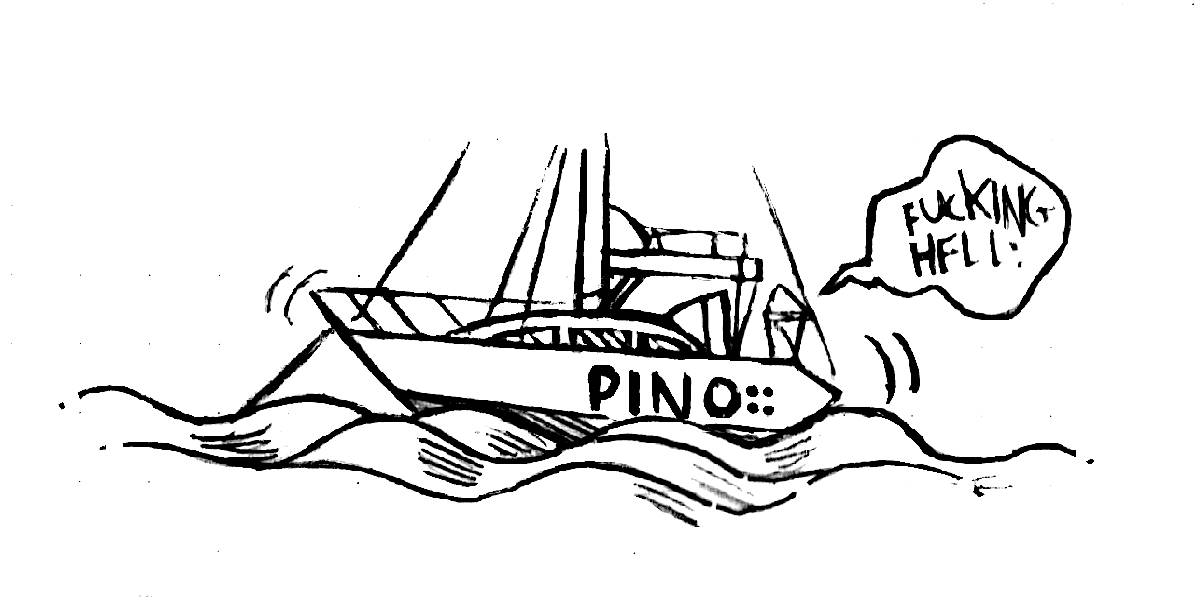 |
|
| Later, the forecast changed yet again, down to 15-25 kn. The motion at anchor became tolerable, cooking dinner without fear of feeling sea sick would be possible. I cooked some sticky brown rice with a topping of sweet and sour chickpeas with crushed peanuts on top. The wind was howling in the strait, but it wasn't felt as strongly here. The wind left entirely at 1700, allowing us to sleep well. We are always grateful when the wind goes to sleep too. | |
| May 5th | Secretary Islands to Smuggler Cove We awoke to an even quieter quiet. A lonely log drifted past, a bald eagle sat atop a bare tree top, a dog barked, the echo distorted the bark of the dog, making it appear like it belonged to a larger, more ferorious animal. We left our unnamed nook at 0830, motoring towards Porlier Pass to catch it at its quietest. Porlier Pass can run fast at peak current, but like all rapids, when timed right, the waters are smooth. Today, the waters were undisturbed. We passed a log supporting 12 black-headed gulls, we named them: the black-headed gull syndicate. This log was the place to be, this is where shady decisions in the black-headed gull world happened. 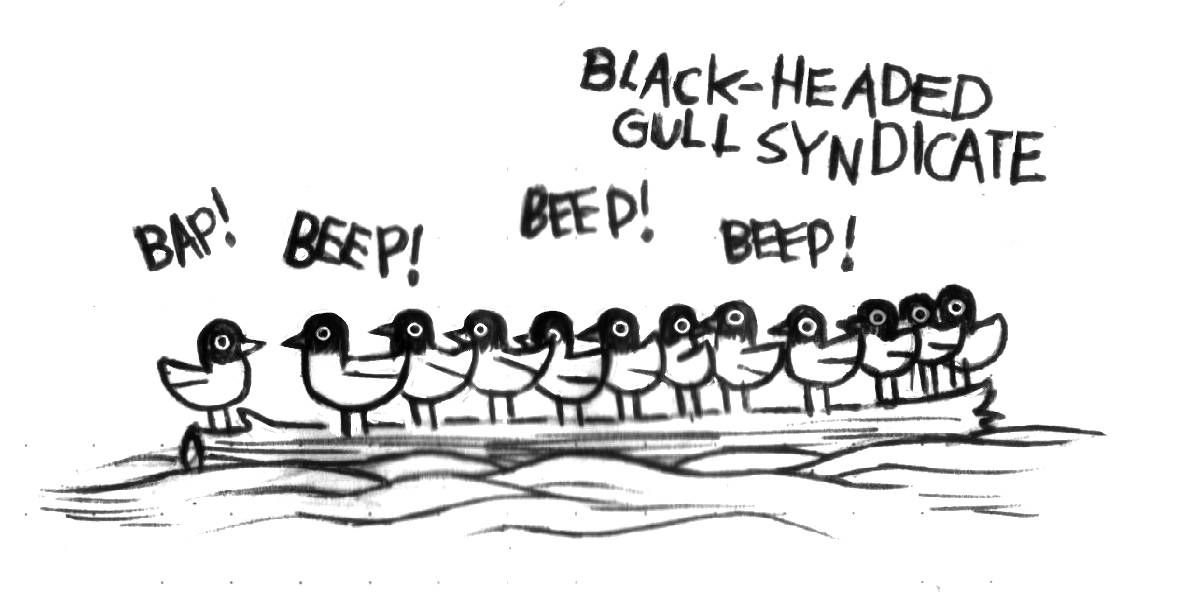 A small fishing boat idled in the pass in the shallows, we glided past them, hoping to find a rippled sea in the strait. Ripples were indicative of wind. The forecast had been unreliable, what was supposed to be 10-15 kn out of the southeast, turned into wind that was supposed to die entirely at 1000, not long after our exit from Porlier Pass. Wind was forecast in the north part of Georgia Strait, so we thought we'd go out and find it. We spotted a band of darker water on the horizon, there was wind out there, but we had to push further away from the shore to reach it. We met with the rippled band of water, hoping that it would stay rippled, it did, with many more bands ahead. A small fishing boat idled in the pass in the shallows, we glided past them, hoping to find a rippled sea in the strait. Ripples were indicative of wind. The forecast had been unreliable, what was supposed to be 10-15 kn out of the southeast, turned into wind that was supposed to die entirely at 1000, not long after our exit from Porlier Pass. Wind was forecast in the north part of Georgia Strait, so we thought we'd go out and find it. We spotted a band of darker water on the horizon, there was wind out there, but we had to push further away from the shore to reach it. We met with the rippled band of water, hoping that it would stay rippled, it did, with many more bands ahead. |
| Our plan was to skirt along the length of Galiano Island, if the wind did not manifest we would duck into Gabriola(another island, further north). The wind stayed, so we pushed on. 10-15 kn winds out of the southeast carried us all the way across. The wind did lessen at times, but it always increased again to fill our sails. The day started grey, and stayed grey. Our new rain jackets saw their first rain today. Our former foulweather gear would get wet and stay wet, making any sail in the rain uncomfortable, while our new vinyl bibs and jackets kept us dry. Although, keeping our hands dry and warm at the same time was a problem. |
|
| It was difficult to see the Vancouver mainland with this rain. In the absense of a visual reference, we had to follow our compass. We took turns steering Pino. When we spend long days on the water we have to give the other time to rest, to warm up. Most Alaska-bound sailors favor boats with enclosed cockpits, but Pino's cockpit is always exposed to the weather. The rain, the sun, and the wind always find us. Both of us were dry today, but it was cold, we hadn't layered on enough clothes. | |
| When we arrived at the entrance to Smuggler's Cove it was 1600, both of us were spent, our defenses eroded by the prolonged exposure to the rain and cold. In such conditions, our bodies have to work extra harder to keep us warm, burning more energy. "My tank is low." Just as I'd said this, the rain increased, bringing the morale onboard to a newfound low. We dropped the hook in the middle basin, not bothering to stern-tie to shore. Devine fired up the woodstove while I secured gear in the cockpit and on deck, determined not to have to go back out there once I tasted the warmth of the cabin. We ate a hearty rice noodle soup, it warmed our insides, while the woodstove took care of our outer shells. Our plan for tomorrow was to go to the grocery store in Pender Harbour. In our haste to leave Victoria, we forgot to stock up on a few key ingredients, like olive oil, and balsamic vinegar. The grocery store there, we knew, had excellent baguettes in stock. A singlehanded sailor came into the anchorage at 1900, he decided to stern-tie, even if there was room, even if it was raining buckets. 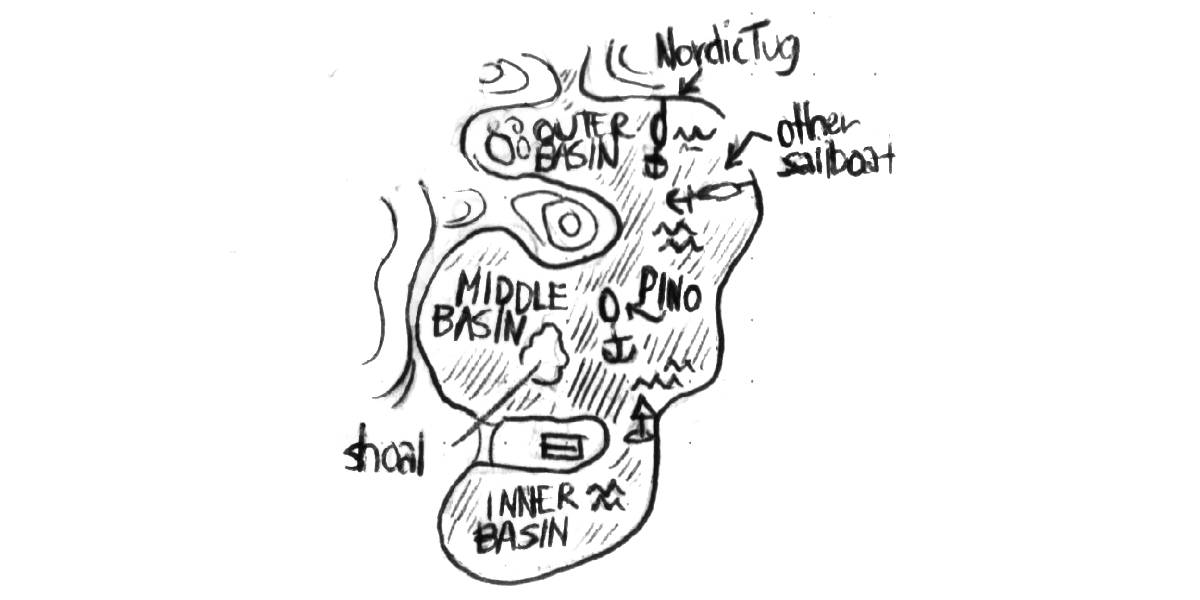 |
|
| May 6th | Smuggler's Cove to Pender Harbour The wind kept us awake last night. Southeast winds funnel through Smuggler's Cove. Our swing radius was very limited in this bay, when the anchor rode was taut, we were 18 m (60 ft) away from the shore. We assumed a southeast wind would point us toward the outer basin. Swinging that close to shore doesn't ever stop being worrisome. We were awake from 0100 to 0400. After 0400, the wind lessened, our anchor watch was over, we fell asleep. |
| We woke up at 0700. We've experienced big weather while anchored in this bay before, but whenever a detail changes, like anchoring somewhere new in the same bay, it is difficult to have complete trust. Our boat is infinitely valuable to us, sleeping badly is a small price to pay, and we can catch up on sleep later. We could see our own breath because of the cold. We prepared whole wheat pancakes for breakfast, while firing up the woodstove. |
|
| We left Smuggler's Cove at 0930, riding the tide north to Pender Harbour, a short 10 NM hop away. The sun came out during our transit, warming our bodies, a reminder that the world could be warm, that it could have color in it. Some clouds drew shapes on Texada Island, while others, heavy with water, threatened to burst. We spied a large cloud with a skirt of rain, south of us, the wind was helping it along, it too had Pender Harbour in sight. We hoped to arrive before it reached us. | |
| Pino found a spot on the Pender Harbour public dock at 1130. We went to pick up a few items at the grocery store. "Where are you going?" The captain of a Nordic Tug asked us. "North." We said. "Us too!" | |
| May 7th | Pender Harbour to Ballet Bay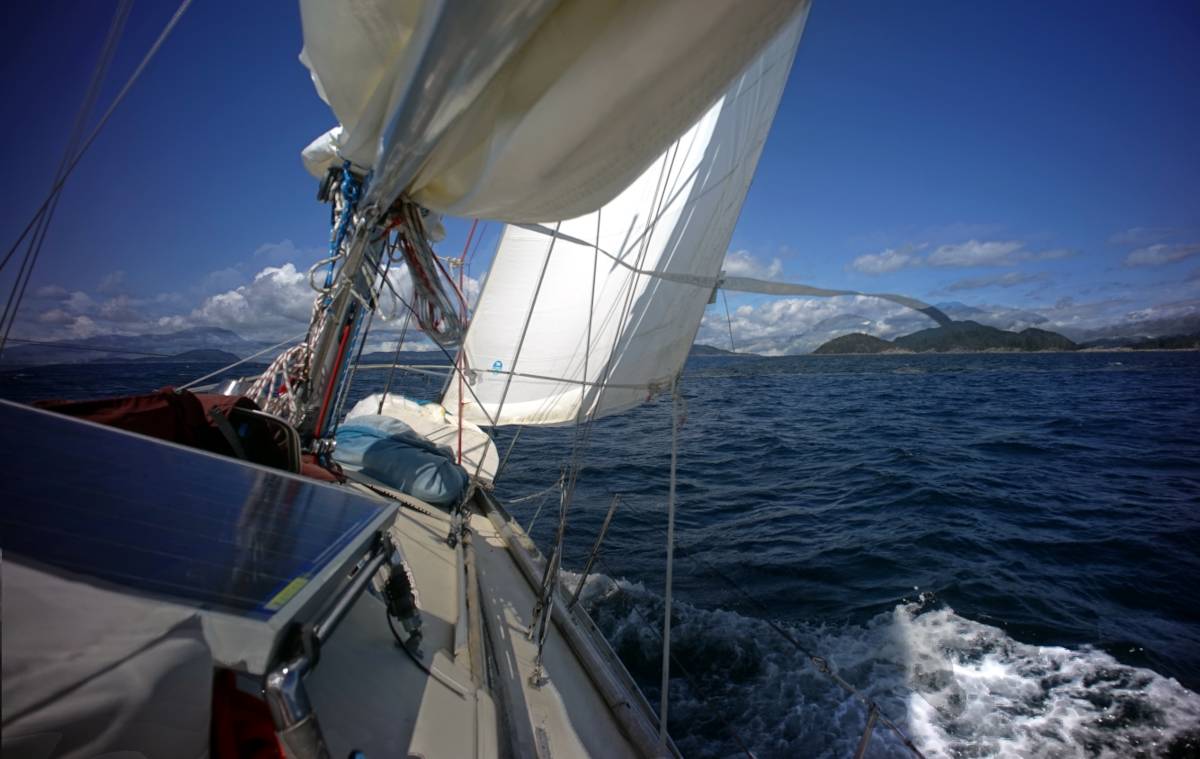 The plan was to skip north to Ballet Bay on Nelson Island, if the wind cooperated we would try to ride it up to an anchorage further north. We always leave with backup anchorages in mind, some for if the wind is helpful, others for if it isn't. The plan was to skip north to Ballet Bay on Nelson Island, if the wind cooperated we would try to ride it up to an anchorage further north. We always leave with backup anchorages in mind, some for if the wind is helpful, others for if it isn't.We forgot to buy a small axe while in Victoria, we considered looking for one in Pender Harbour but there were no hardware stores within reasonable walking distance — much of British Columbia is car-centric. We hope to find one in Port McNeill, a city near the top of Vancouver Island. We would use the axe to split our own kindling for the woodstove, wood sold in stores is usually not sized for our little 23x23 cm firebox. Mornings are still very cold aboard Pino, we run the woodstove to stay comfortable. |
| We left the dock at 1000. The wind funneled into the Harbour, a sign that there was a lot of weather out there. We put a reef in, beating to weather under a full sail can get really sporty. We inched out of the Harbour by motor, and sailed as soon as we cleared the outermost island and begun a seemingly infinite succession of tacking, with one coast fading away while the other came into focus. On each tack, our eyes found a landmark to aim for across the channel. Every lighthouse, old cannery, cliff face or clear-cut area on a mountain, acted a a marker and a proof of our progress. We had to tack 6 times to line up with the entrance to Ballet Bay, our planned anchorage of the day. |
|
| We saw two other sailboats on the water today. One of them, a catamaran, beat us to our anchorage, while the other sailed on. At times, we were going at 6 kn, a fine speed under a reefed mainsail. The boat was heeling to 20 degrees, a good test for our gimballed stove. We have used it everyday since we left. | |
| Once we arrived into Ballet Bay, we saw that the catamaran had claimed the shallows, but we found a spot nearby in 13 m (45 ft, 16 m / 55 ft at HW). The northwest wind found its way into the bay, but there were no waves at least. We prepared sandwiches with a baguette we picked up in Pender Harbour. I was glad to have waited to arrive to eat, some meals are unpleasant to eat underway. When the wind and the waves are up, I feel like I have to finish the meal in a hurry, I don't get to enjoy it. I want to enjoy my sandwich. I will enjoy my sandwich! |
|
| Week 2 | |
| May 8th | Ballet Bay to Sturt Bay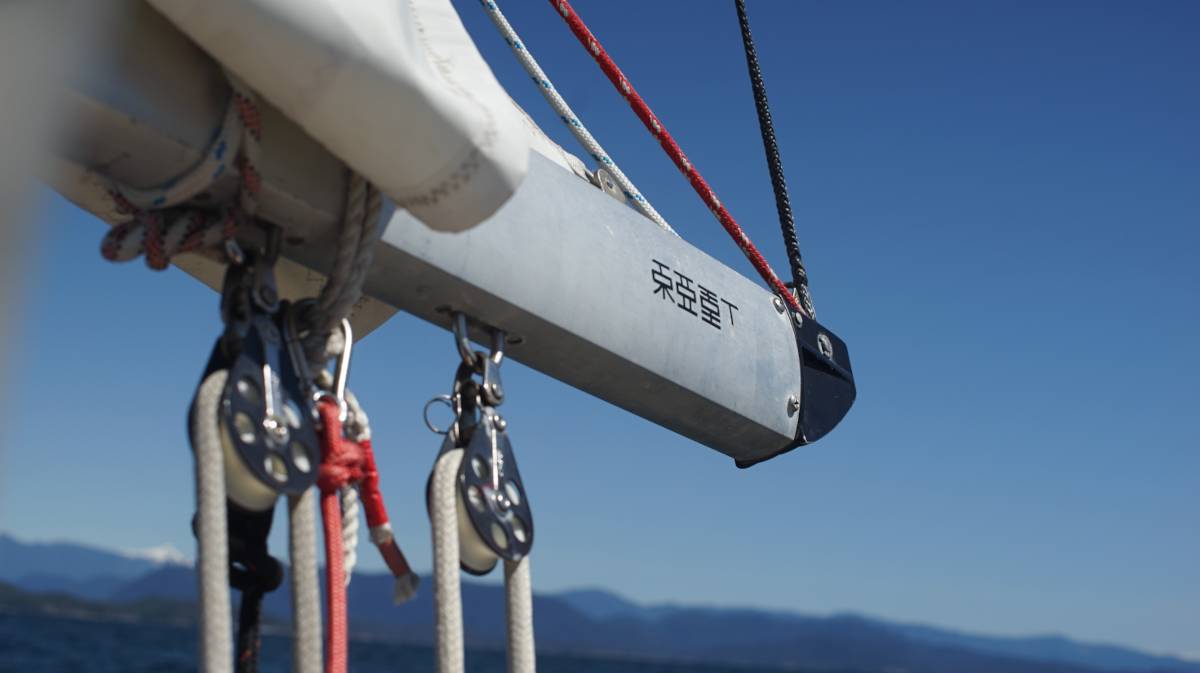 After partaking in another round of delicious sandwiches for lunch, we got ready to hoist the rode and anchor. In 13 m (45 ft) of water, all of the chain rode is out (we have 30 m / 100 ft of chain aboard), with a good length of rope rode hanging in the deeps. Pino does not have a windlass aboard, we haul everything up by hand, or by using a chain hook and leading a line back to a cockpit winch. The chain stopper at the bow locks the chain, permitting us to adjust the chain hook safely. We can't use the same technique for the rope rode, though. Up until now, we did it by hand, but that won't be possible in depths greater than 18 m (60 ft), which we'll likely encounter up north. Our plan was to tie a prusik knot around the rope rode to haul it in (read more about it in no windlass). After partaking in another round of delicious sandwiches for lunch, we got ready to hoist the rode and anchor. In 13 m (45 ft) of water, all of the chain rode is out (we have 30 m / 100 ft of chain aboard), with a good length of rope rode hanging in the deeps. Pino does not have a windlass aboard, we haul everything up by hand, or by using a chain hook and leading a line back to a cockpit winch. The chain stopper at the bow locks the chain, permitting us to adjust the chain hook safely. We can't use the same technique for the rope rode, though. Up until now, we did it by hand, but that won't be possible in depths greater than 18 m (60 ft), which we'll likely encounter up north. Our plan was to tie a prusik knot around the rope rode to haul it in (read more about it in no windlass). |
| This is not the fastest, or easiest method of hauling an anchor rode, but it works. Today, the wind was light, the water not too deep, we hoped it would continue to work well in more difficult conditions. Winches provide excellent mechanical advantage. A determined sailor could lift an anchor by way of a 4:1 pulley system alone, a technique rescuers use, but winches are present on most boats our size. Motor boats too could benefit from having a winch onboard, especially in the event of a windlass failure, or to pull in a stern line in heavy winds. We've seen boats failing to secure their stern lines with wind on the beam because they lacked the strength to pull the line in by hand. | |
| After hauling all of the rode back on deck, we motored out of Ballet Bay to a calm Malaspina Strait. The forecast called for 5-15 kn out of the northwest. Sometimes this means 5, other times 15, but it is usually zero. I spied a dark blue band on the water ahead. "Either that's wind, or a tide line," I said, grabbing the binoculars, "Wind! Lots of it!" We raised Pino's wings, entered the blue band, and sailed, sailed, sailed! Then, shortly after, we reefed, reefed, reefed, because the wind was stronger than 15 kn(we cannot offer precise readings, because our wind meter died a long time ago). As we reefed the main, we accidentally heaved-to, which sent a few loose items rolling in the cabin. | |
| We zigzagged up Malaspina Strait. The wind lessened as we neared Sturt Bay on the northeast end of Texada Island. While moorage on this coast keeps increasing, the dock fees for the modest facilities at the Texada Boating Club continue to be reasonable, but we decided to try anchoring in the bay north of the docks for the first time instead. We later learned that the bottom was fouled with old logging gear. Texada Island's industry, consisting of both logging and mining, has mostly disappeared, but scars remain. Many bays on this coast are fouled with old machinery, we often see rusty cables and gear on land when hiking, posing as roots, half-buried in the soil and ferns. | |
| We had Japanese curry for dinner, using up two whole potatoes that had begun to sprout. These days, we move everytime there is wind, even if it's weak. In the summer, a forecast of 5-15 kn will often mean no wind, but if the same numbers are forecast in the spring, the higher number is often more accurate. So far, we have sailed almost everyday. This was very different from the kind of sailing we'd done in these waters these past 4 years. We usually enjoy staying in the same anchorage for days, or weeks at a time. We will have to slow down once we arrive near open waters, stronger weather may not allow us to sail everyday — I am getting ahead of myself, eyes on tomorrow, Rek, eyes on tomorrow... well, eyes on tonight! I look forward to continuing to read The Martian. Mark Whatney is sprouting potatoes, just like us! | |
| May 9th | Sturt Bay to Galley Bay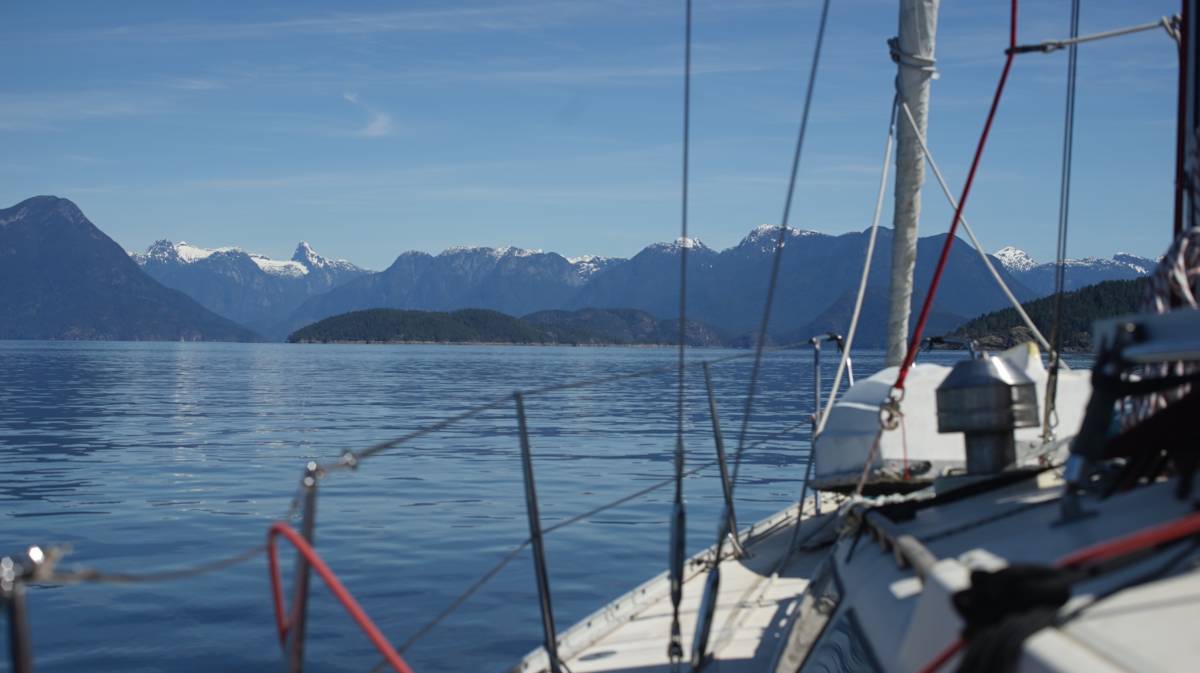 We woke up at 0600 to another calm morning, a quick look outside revealed that this quiet was contagious, it had spread to the whole of Malaspina Strait. We woke up at 0600 to another calm morning, a quick look outside revealed that this quiet was contagious, it had spread to the whole of Malaspina Strait. |
| Underway, Devine made modifications to our rain jackets, the jackets were new, but the strings used to tighten the hoods down over our heads weren't equipped with stoppers. On our last rainy transit across the Georgia Strait, we both complained about the lack of stoppers on our hoods. When sailing, a tight hood won't catch in the wind, keeping our vision clear to better see floating debris, whales and traffic. Devine harvested two stoppers from our older foul-weather jackets. The jackets each had 2 stoppers on the bottom, but we never used them. The only thing that these stoppers were good for was for getting caught in the cabin table when walking inside. Our table has an extension — bound to the main part of the table by a piano hinge — that we fold down when underway. The stopper on my jacket liked to get caught in the hinge between the two halves. "Everytime!" I'd say aloud, annoyed, reaching back to free it. Never again! 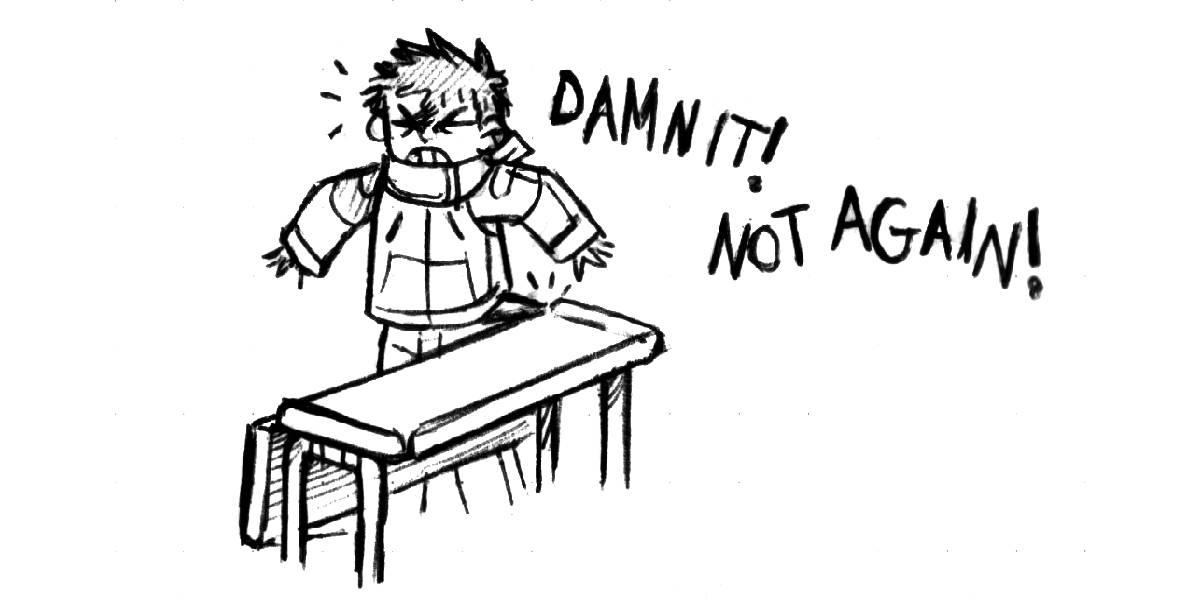 Both of our jackets were awarded hoods with stoppers! Sometimes it feels like the items we buy haven't been well-tested by their makers. Had they thoroughly worn our jackets, they too would have realized that stoppers were necessary. Devine sure enjoys fixing things underway. Both of our jackets were awarded hoods with stoppers! Sometimes it feels like the items we buy haven't been well-tested by their makers. Had they thoroughly worn our jackets, they too would have realized that stoppers were necessary. Devine sure enjoys fixing things underway. |
|
| On this long transit, whenever Devine, who'd been inside fixing things, would peek outside to look at our progress northward and say "Lund!" while gesturing to whatever was out there. Of course, it took Devine 3-4 more tries before Lund finally did materialize. In Pino lore, saying Lund aloud enough times toward the land will eventually turn said land into Lund. Lund is a small port very near to Desolation Sound when leaving Sturt Bay, once you reach it the land of quiet and beautiful anchorages is near. We have never been. |
|
| When arriving in Desolation Sound, a place that does not wear its name well in the summer, beautiful mountains appear. This early in the season, the mountains are covered in snow, adding to the majesty of the scenery. Snow to the peak of a mountain is what a crown is to a human head. We tucked into Galley Bay — a place, like Lund, that used to house a commune, now lined with summer homes. The bay appeared very restricted, hostile, with much of the barnacle-encrusted shore exposed at low tide. We were alone, it would have been shocking to find another boat here at this time of the year, Galley Bay serves as overflow parking when the popular anchorages are busy. We had picked this anchorage because... 1: We'd never been. 2: It was near Refuge Cove, our next stop. 3: It offered reasonable protection from prevailing winds. |
|
| We spotted some surf scoters, with their swollen, bright orange bills, swimming near a dock that afternoon. There were many of them moving together in a tight group. "Another entry for bird bingo," I said, it was the first time we had seen one outside the pages of a book. At high water, the bay took on a friendlier, more welcoming appearance. | |
| May 10th | Galley Bay to Refuge Cove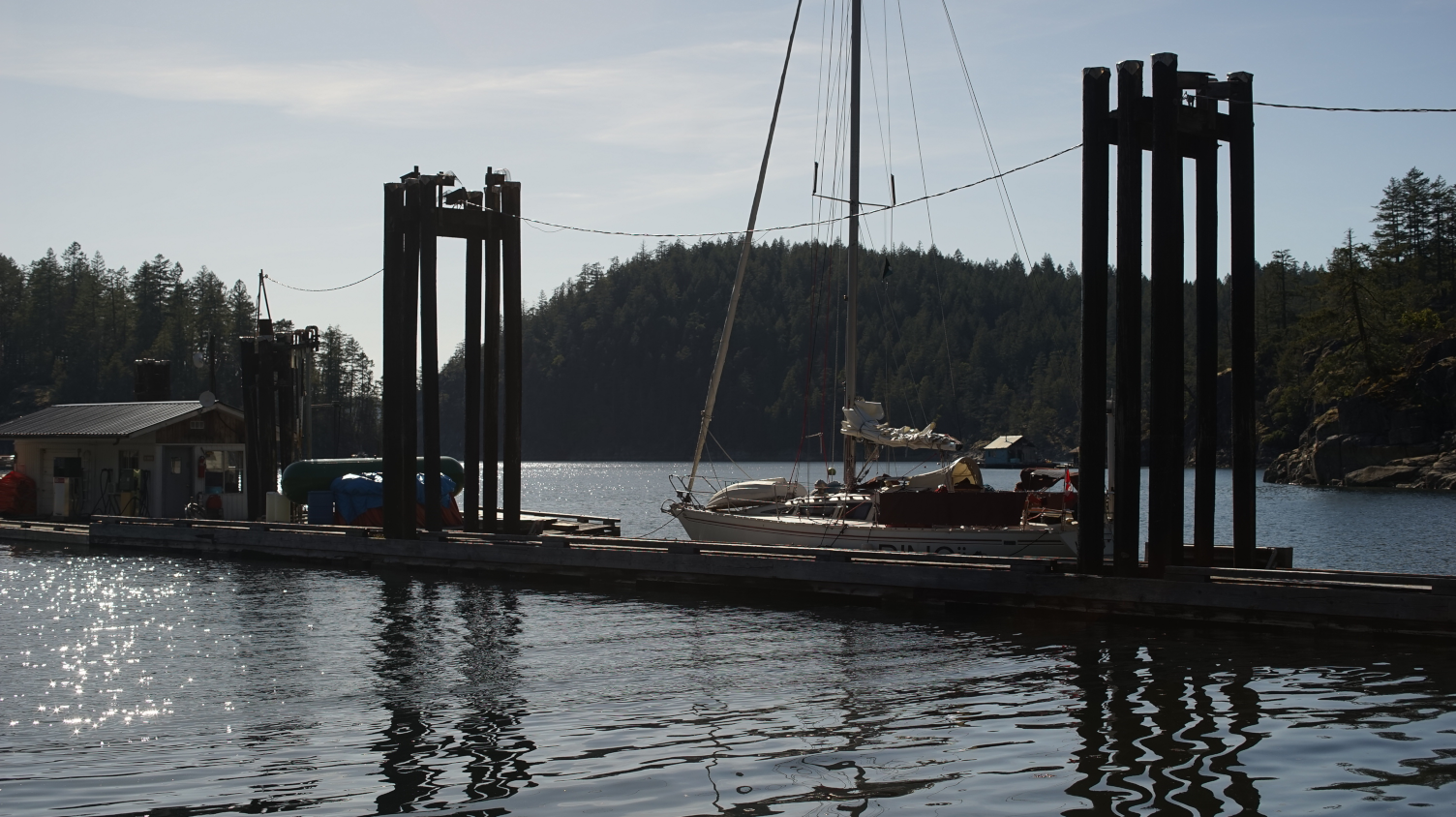 We shut the companionway screens before dark, but the mosquitoes were out early, they made it inside and waited. They sent their first agent at 0200, while we slept. It eluded us at first, we both got out of bed to find it. Another agent surfaced later, determined to rob us. We terminated 2 more that night, and another 2 come daylight. Each had left their mark on our walls, a red smear, a reminder that they had in part succeeded. We shut the companionway screens before dark, but the mosquitoes were out early, they made it inside and waited. They sent their first agent at 0200, while we slept. It eluded us at first, we both got out of bed to find it. Another agent surfaced later, determined to rob us. We terminated 2 more that night, and another 2 come daylight. Each had left their mark on our walls, a red smear, a reminder that they had in part succeeded. |
| The plan today was to head to Refuge Cove, a short distance away, to refill a 20 L bin with diesel. There weren't many convenient fuel stops north of Refuge Cove, we wanted to make sure we had enough for our transit through the many rapids up north. The fuel dock was only active 3 days a week at this time of the year, for 3 hours. | |
| We left Galley Bay at 1030. I hauled up most of the anchor rode by hand, but we used the cockpit winch and chain hook to pull in the remaining 15 m (50 ft). Hauling chain up this way stains the deck, especially if anchoring in mud. After engaging the chain stopper, I had to walk back to the block, which was as far as the chain hook could go on deck, I then unhooked the chain to drag it back, mud and all, into the locker at the bow. Most sailors would find this setup less... than ideal. | |
| We glided over to Refuge Cove, a short 5 NM sail, arriving at noon. The docks were empty, we had lunch while waiting for the dock attendant to arrive and operate the fuel pumps. Around 1300, many small boats started to pile in. "You hurt yourself?" The fuel dock attendant asked me, pointing at the blackout tattoo on my forearm, thinking it was a compression sleeve. "It's a tattoo," I corrected him. His face took on an amused, but bewildered expression. | |
| That evening, the only other vessel on the docks was a large supply barge, carrying a giant propane tank to resupply the marina for the coming season. We watched the entire re-supplying process. The local store was also busy unpacking boxes of food, organizing them on the shelves. Being here out of season and all seeing this was neat, like watching a restaurant kitchen before opening hours. | |
| When heading north, there are several paths to take, but all eventually lead into Johnstone Strait, a 110 km (68 mi) long channel known for its traffic, its fast-flowing waters, and for its daily strong wind warnings. The weather in that strait did not inspire an early visit, it was still blowing 35 kn, we instead chose to take the back route, via the Yuculta and Dent Rapids. We planned to cross the rapids on the 12th of May, until then we had time to waste. Why the 12th? Because the turn to ebb was at a reasonable hour on a neap tide. Neap tides are the lowest tides of the lunar month, occurring in the second and fourth quarters of the moon. At this point in the lunar cycle, the tide's range is at its minimum, making it an ideal time to traverse through fast-flowing rapids. A small tide reduces the speed of the current. | |
| May 11th | Refuge Cove to Frances Bay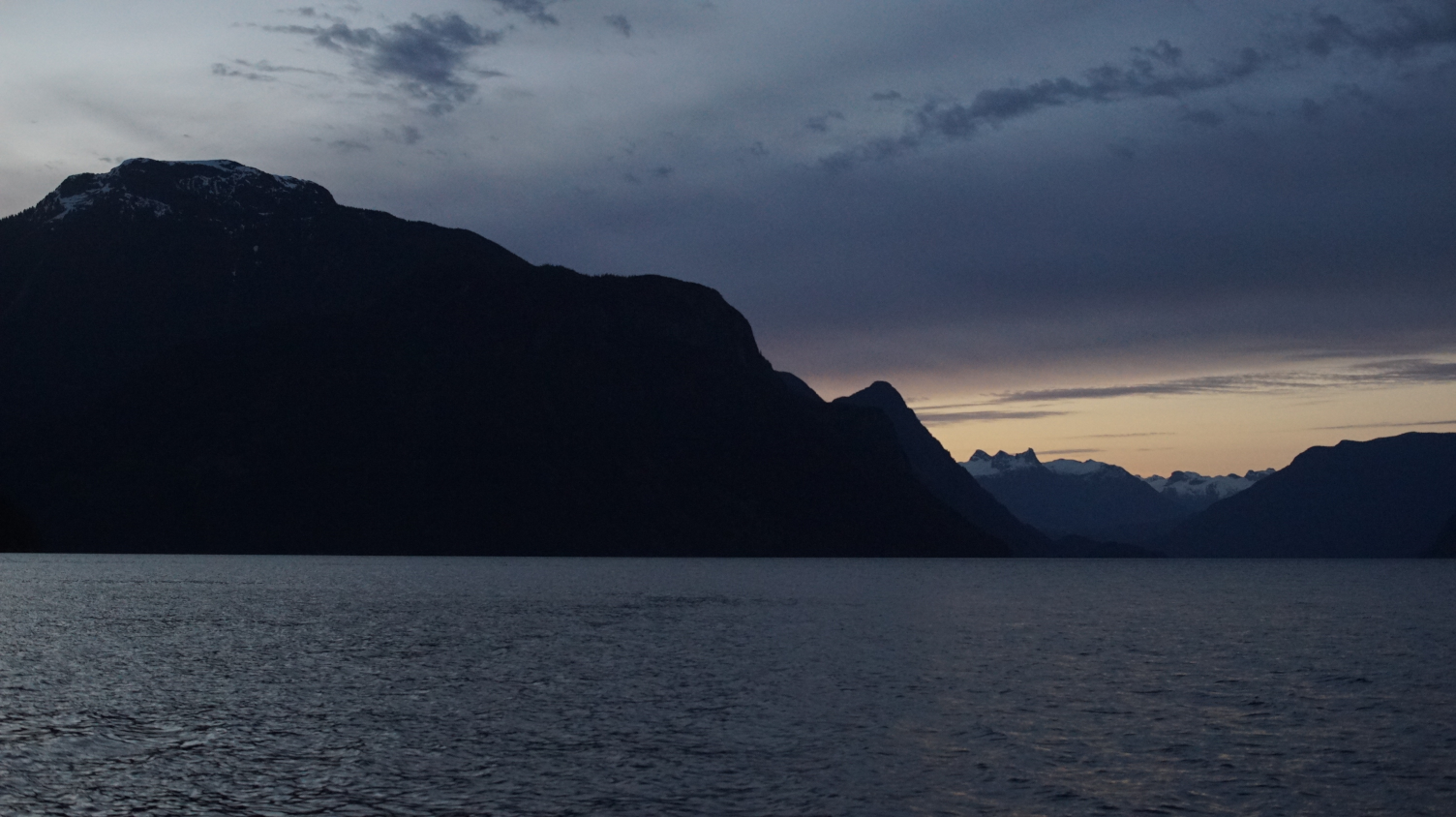 Our dock neighbors, 5-6 purple martins, woke us up early this morning. The dock owners installed birdhouses on the top of every pilling, the purple martins were enthusiastically occupying them all, no vacancies. Our dock neighbors, 5-6 purple martins, woke us up early this morning. The dock owners installed birdhouses on the top of every pilling, the purple martins were enthusiastically occupying them all, no vacancies. |
| We pushed off the dock at 0800. The wind was already up and slowly creeping in through Refuge Cove. We reefed the main and proceeded to sailing up Lewis Channel. The wind often blows down from this channel, funneling at its narrowest point, making for an exciting time on the water. We sailed, close-hauled, tacking from one side of the channel to the other, until the wind ran out of breath and we pulled into Frances Bay. By then, both of us were snacking on peanuts, tired and hungry. We arrived at 1400, 22 NM later. | |
| Frances Bay was very breezy, it appeared sheltered from weather on a chart, but the wind came speeding down the hills and into the anchorage. This anchorage was not ideal but it was near the Yucultas, there aren't many options for overnighting safely in the area, all are inconvenient for different reasons. One is littered with old logging equipment that can foul your anchor, another is subject to outflow winds from a nearby inlet at night... | |
| Low tide exposed old and abandoned logging equipment along the shoreline. While Devine steered us to the head of the bay, I prepared a trip line for our anchor. Rusty equipment ashore often means rusty equipment in the water, a trip line ensures that we can retrieve the anchor if ever it did get stuck. I tied the line to the crown of the anchor(many anchors have a hole pre-drilled for this, Rocnas have one). The fender squeaked and shifted uncomfortably as I tied the other end of the trip line onto it, as if to say, "you have got to be kidding!" The fender recalled the time we used it and 2 others of its kin to buoy our anchor chain while in French Polynesia. The 3 fenders were submerged, hovering in the depths, preventing the chain from getting caught in coral on the ocean floor. Today, the fender would not be submerged, it would stay on the surface, keeping our trip line afloat. I threw the fender overboard, we watched it drift away, marking the spot where our anchor lay. | |
We found 2 giant ants aboard today. They likely climbed in while we were docked in Refuge Cove. We hoped we wouldn't find more, they better not be the sort that like to chew through wood, Pino is fibreglass, but the interior is all wood.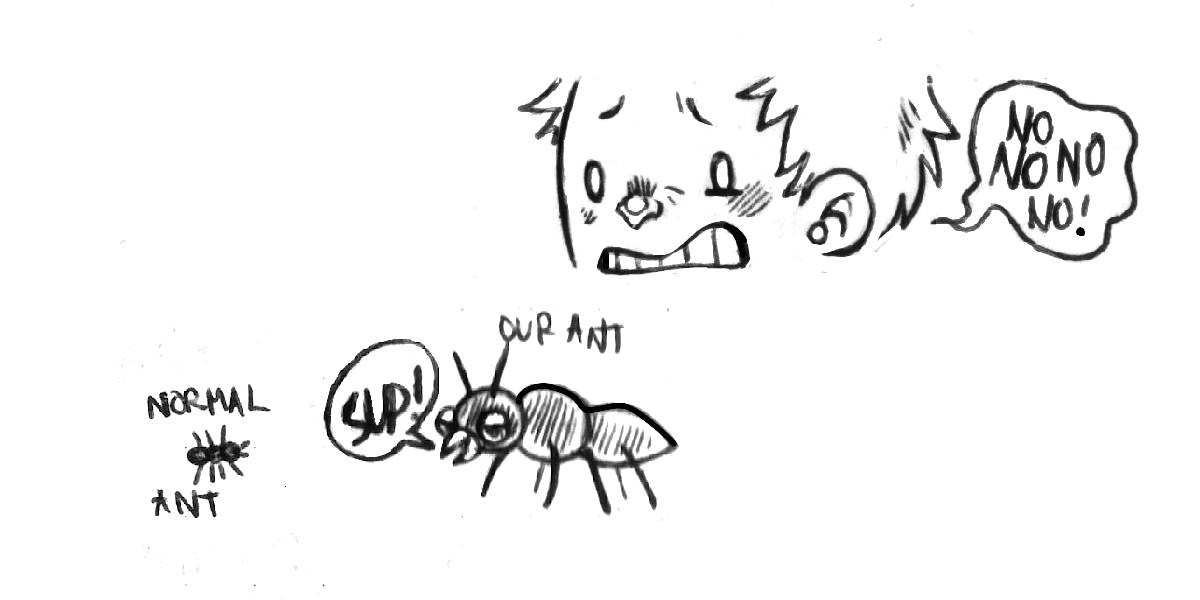 My arms were tired from the relentless tacking, but despite the soreness, I was glad that the wind had come. My arms were tired from the relentless tacking, but despite the soreness, I was glad that the wind had come. |
|
The strong gusts in this anchorage were very anxiety-inducing. Doodling and writing helped to combat this, but that doesn't help when I'm trying to sleep. Anxiety balloons in the dark.
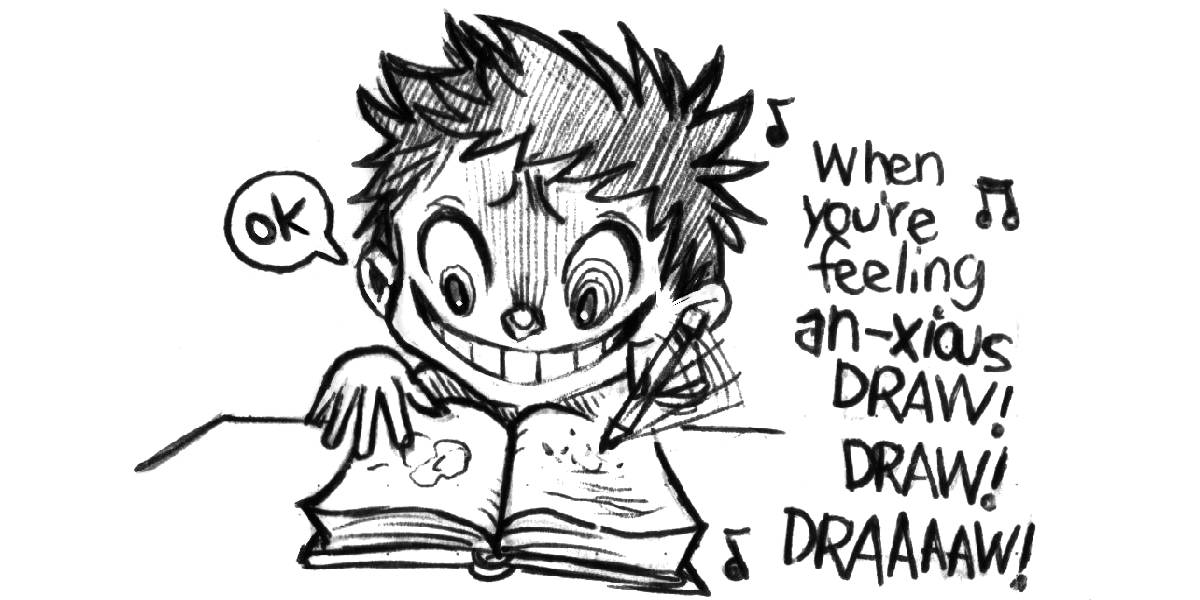 |
|
| May 12th | Frances Bay to Shoal Bay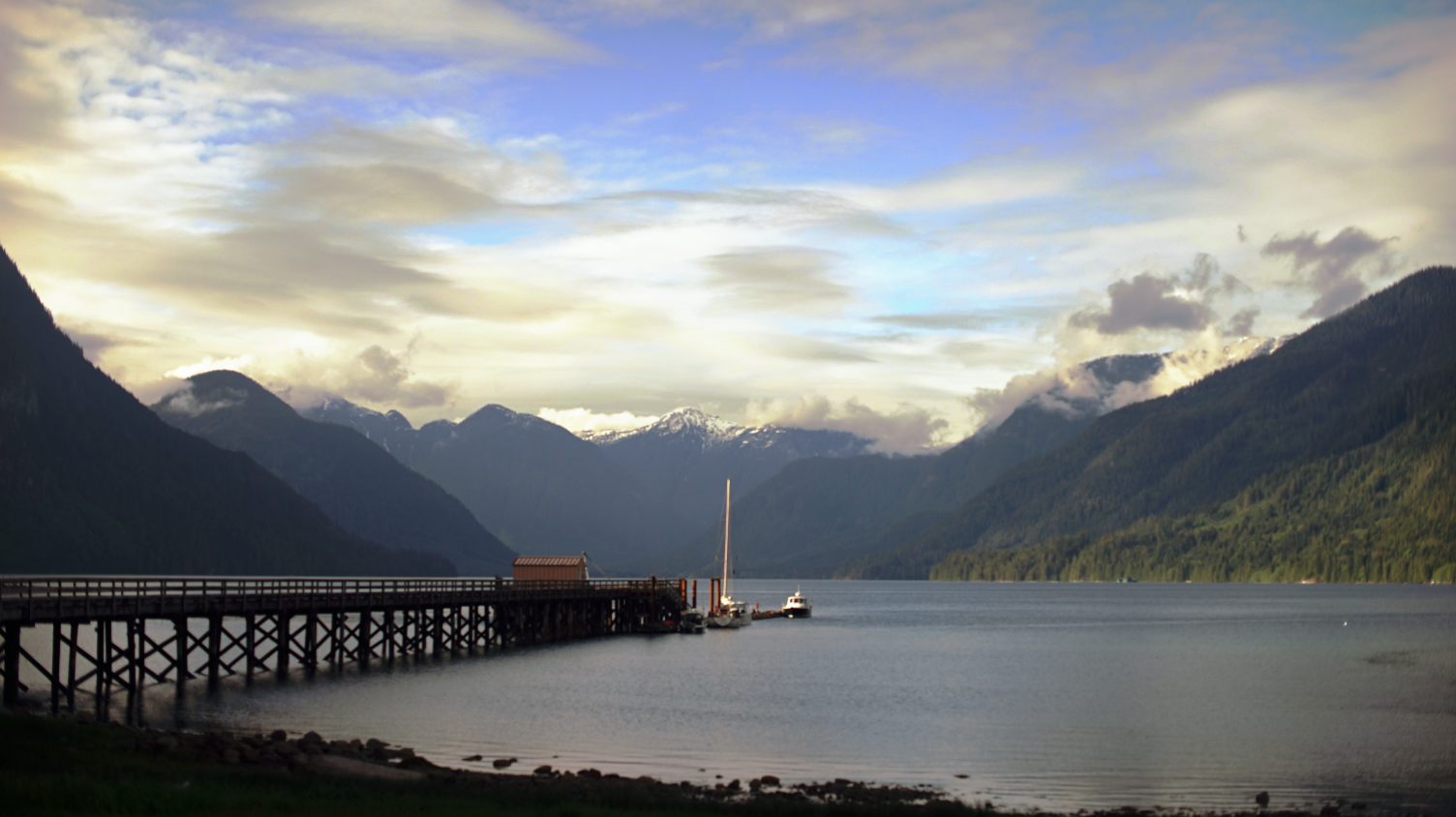 As expected, we slept very poorly last night. The wind did not let up. The wind rolled down the hills, like an out-of-control train coming to smash up against the shore. As expected, we slept very poorly last night. The wind did not let up. The wind rolled down the hills, like an out-of-control train coming to smash up against the shore.Both of us were awake when the alarm rang at 0500. We took the bed apart, got dressed, and went out to haul in the anchor rode. I don't think I will ever get used to hauling the anchor 5 minutes after waking. Our anchor did not get snagged on anything, we retrieved our fender, the tripline, and moved out of Frances Bay. We raised the main, but the wind decided to stop as soon as we finished hoisting it up. "You kept us awake all night, and now you won't help us out of this anchorage? Thanks for nothing wind!" Pino moved, without the help of the wind, towards Habbott Point at the south end of Stuart Island, where the Yuculta rapids begin. We would have to traverse 3 sets of rapids today, all one after the other. The first on the line is the Yucultas, then Gillard Passage, and finally the Dent rapids (see Yuculta and Dent Rapids for more information). |
| I had entered waypoints on Navionics(a navigation software, that we use along with our chartplotter), to map out the location of all of the eddys that would permit us to make progress through the last of the opposing ebb current in the Yuculta rapids. When northbound, the tactic is to arrive earlier to catch slack tide at the most turbulent point, Dent Rapids, but that means working against some current by riding eddys to get there. We chose to transit on a neap tide to lessen the amount of current we'd have to fight. We rode eddys, the water was disturbed, but not overly so. Once we arrived at Gillard Passage, we had more current to power through, especially at the narrowest point, but it was less than 1 kn. We arrived at Dent Rapids later than we had planned(15-20 minutes later), but we didn't have any trouble. On anything but a neap tide, arriving late would have been costly. For a slow boat, going through all 3 rapids is ambitious, but not impossible provided that the timing is good, that the moon isn't too full and that the sailor is aware of the locations of the eddys in the area. After passing the dreaded Dent rapids, we celebrated with a warm cup of coffee. Passing over a marking on a chart with a whirlpool named "Devil's Hole" was not reassuring, but this dreaded spiral only forms on a large flood current. We read of an attempt by the Spaniards(1792) to transit these rapids. Indigenous villagers had warned them not to run the rapids in their schooners, the Mexicana and the Sutil, they went through and one of the boats got sucked into a whirlpool and was spun three times (read more about the story). |
|
| The wind was up, we slipped on our tuques, scarves and gloves to keep warm, doing our best to finish the hot beverage before the cold got to it. The ride after the Dent rapids was problem free. Cordero Channel, after the rapids, was surrounded by big mountains. At the end of the many long arms branching from the channel, the mountains rose even higher. | |
| We arrived in an anchorage named Shoal Bay, surprised to find many boats on the government dock. We had difficulty squeezing in between two boats — Pino doesn't parallel-park very well. Once Pino's hips got closer to the dock, I threw the end of the boat hook onto the arm of a swimming ladder and pulled us in the rest of the way. Moorage at Shoal Bay dock was cheap, but popular, even in the shoulder season. |
|
| Shoal Bay was idyllic. When the clouds parted late in the evening, the sunlight set the ashen-hued scenery ablaze, painting trees green, carving details in the mountains. The 20-30 kn winds in the strait did not disturb our waters, the lion roared, but not a single blade of grass stirred. | |
| May 13th | Shoal Bay to Forward Harbour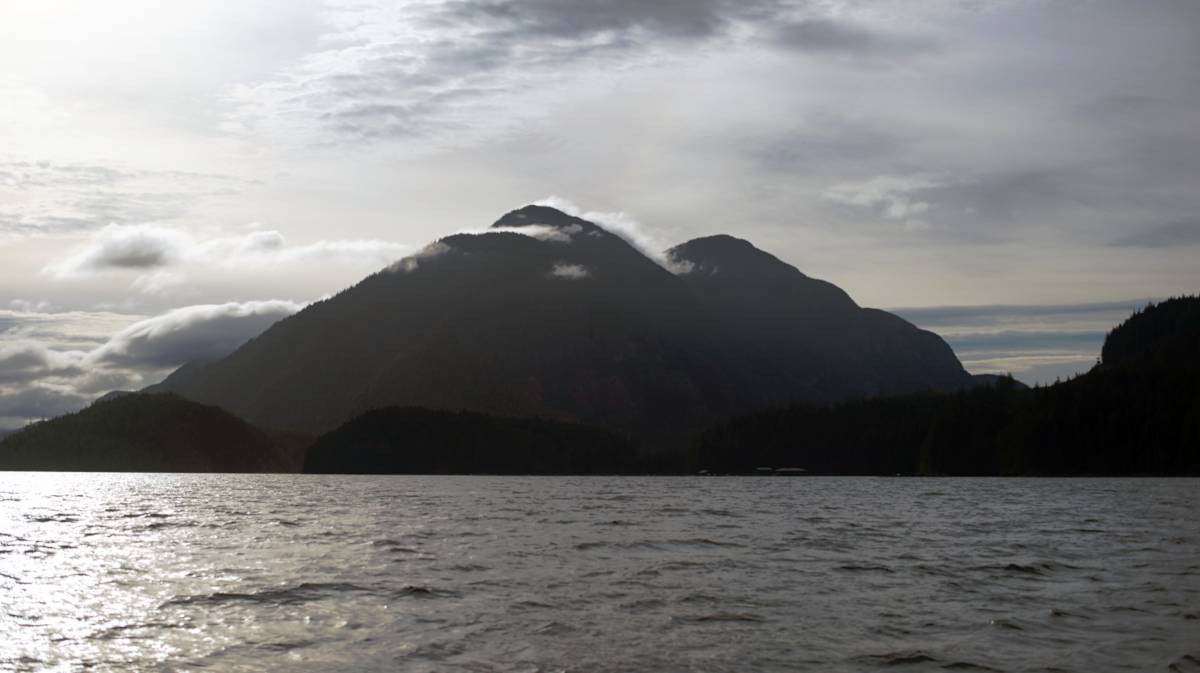 We awoke before our 0600 alarm, a crow had landed in the cockpit. "Wake up!" it cawed, "time to go! Time to go!" We left the dock 20 minutes after waking. This was our life now, we couldn't linger anywhere long enough to see a place in all of its moods. We awoke before our 0600 alarm, a crow had landed in the cockpit. "Wake up!" it cawed, "time to go! Time to go!" We left the dock 20 minutes after waking. This was our life now, we couldn't linger anywhere long enough to see a place in all of its moods. |
| We pushed against some current before Green Point Rapids to be there before slack in order to arrive at yet another set of rapids, Whirpool Rapids, 12 NM away, when it isn't running at peak current. Slack tide falls at the same time for both of these rapids, passing them both in calm waters would not be not possible for us. Pino the slow boat wasn't going to bridge 12 NM in less than 2 hours. We passed Green Point Rapids at 0730, with slack at 0754, we had planned on arriving earlier but the opposing current had slowed us down. The rapids opened onto Chancellor Channel, the current there soon turned in our favor, adding to our speed. We were glad for the help, because once past Tucker Point the wind from the strait penetrated the channel, blowing strongly in our faces. By the time we arrived at Whirlpool rapids, it was way past slack tide, there would be some current. "We're still on a neap tide," I said, "it's safe to assume that the current running there will not exceed 3 kn?" When nearing the narrowest point of the channel, looking through binoculars, we saw no dangers so we proceeded through. We started at 4.5 kn, then accelerated to 8.6 kn. "The current maybe did exceed 3 kn after all. 4 kn it seems like," Devine said with a grin, Devine who greatly enjoyed the rush of a sudden and brief increase in speed. We had read that running these rapids at higher current wasn't dangerous, because unlike the Dents, the channel was free of obstructions. |
|
We arrived at Forward Harbour at 1030, anchoring in Douglas Bay in 10 m (35 ft, 12 m / 41 ft at HW). On Navionics, we saw a disturbing review, that we both hoped was a joke, rating the anchorage 4/5 stars despite the fact that a cougar had taken their dog on the beach. 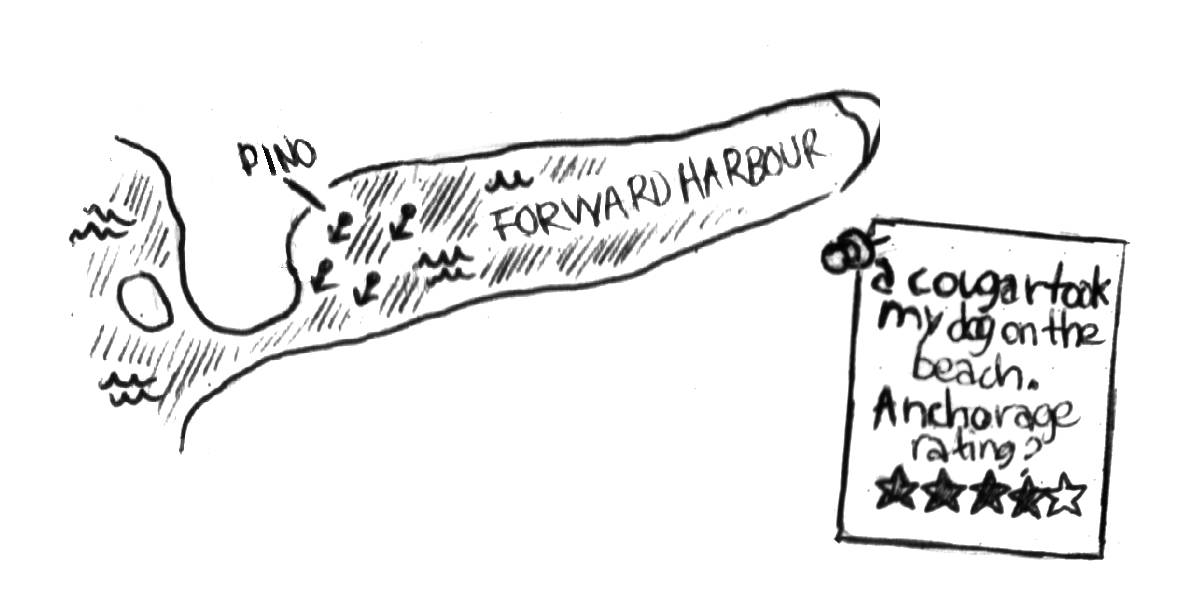 |
|
| Forward Harbour was our last anchorage before entering Johnstone Strait. As I have already mentioned, there are many back channels when heading north, but eventually, all boats, no matter what path they choose to take, end up in the strait. Sunderland Channel, laying ahead of us, was the last back-channel exit when northbound. When heading north through Johnstone Strait, the prevailing wind is from the west(in your face), if a boat rides an ebb current north, then a strong westerly wind blowing against a fast-flowing ebb will generate large waves. Every knot of current is the rough equivalent of 10 kn of wind, a sailboat sailing into a strong headwind in Johnstone Strait with a strong ebb current will face waves that are out of proportion to the conditions. |
|
| The clouds dissipated later in the afternoon, the coming warmth helped revive us. We raised our flip phone up the mast to improve our internet reception. | |
| Every day around 1600, we discussed the next day's transit, we checked the weather, went through our guidebooks, read about the hazards we might encounter, poured over charts, and made backup plans if ever the weather changed or if it didn't allow us to get to where we had planned to go. Tomorrow's wind was ideal for dipping our toes into Johnstone Strait for the first time. Forward Harbour was an okay stop, but the wind curled around the corner, putting all of the boats anchored near Douglas Bay stern to shore for a while. |
|
| May 14th | Forward Harbour to Port Neville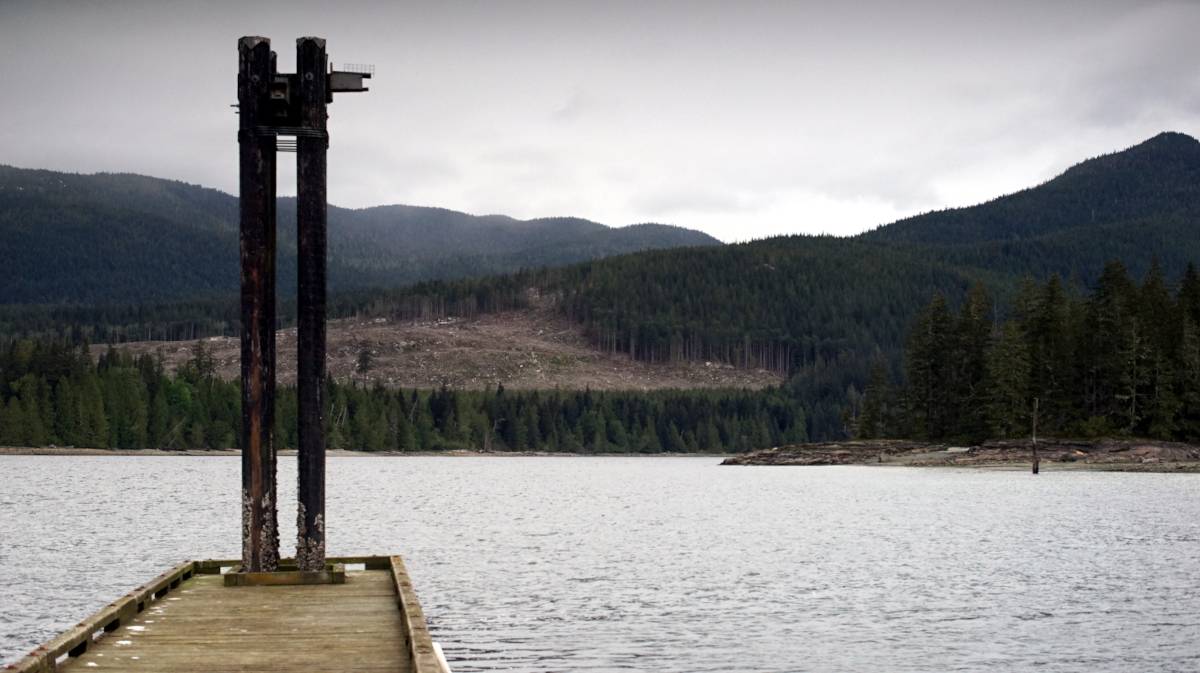 As was tradition on board, we got up at 0600. The forecast hadn't changed, we were expecting 15 kn out of the west-northwest. We motored to the entrance to Sunderland Channel, hoping to arrive at the junction leading into Johnstone Strait for 0930, near slack, to avoid some tide rips that form there when the flood tide turned to to ebb. We sailed out on a flood, if there was wind, working against the last of an opposing current in this channel wasn't a big deal. As was tradition on board, we got up at 0600. The forecast hadn't changed, we were expecting 15 kn out of the west-northwest. We motored to the entrance to Sunderland Channel, hoping to arrive at the junction leading into Johnstone Strait for 0930, near slack, to avoid some tide rips that form there when the flood tide turned to to ebb. We sailed out on a flood, if there was wind, working against the last of an opposing current in this channel wasn't a big deal.We flew, flew, flew! The wind was up, blowing out of where we need to go always, but we made good progress. We tacked back and forth, dodging islands, reefs, and orcas. Yes! We saw a pod of orcas with a baby while sailing here! They surfaced near us, we diverted but had plenty of time to take in their features. Everytime they surfaced, we would greet them with an overenthusiastic, "oh wow, oh wow, oh WOW!" Orcas are so beautiful, and the presence of a youngling warmed out hearts. |
| Because we were nervous about today's transit, we didn't have coffee or breakfast. Sometimes the weather changes suddenly, forecasting meaner, more difficult conditions. The ride got more and more sporty as we neared the mouth of the channel. As expected, we had some good wind waves, but our timing for our arrival at Tuna Point was good. We tacked our way forward, the increase in wind allowed us to point higher. We crashed into the larger waves, with spray washing over the bow. | |
| When nearing Port Neville, we encountered more orcas! Again, they stayed close — such lovely creatures. By the time we arrived at the entrance to Port Neville, we had tacked 25 times. I was very, very tired. This 12 NM trip had ballooned into 22 NM. The government dock was empty, the wind pushed us in a bit too aggressively onto it, our fenders let out a loud whine as we crushed them between Pino and the dock. | |
| The dock at Port Neville was old, abandoned, but still standing, it was mossy, some of the pillars were half-eaten. An old rusty refrigerator was lying on the dock, along with some disused fishing and crabbing gear. The mountains in this bay were bare, full of logging scars, robbed. The Port Neville government dock no longer had a wharfinger, and hadn't for a long time, but transient boaters continued to moor here. Anchoring in the bay was possible, but not ideal because of strong currents. This place used to host the longest running post office in British Columbia, the old building was still there, preserved as a historic site. Note: We later learned that the Tlowitsis First Nation would soon take ownership of the Port Neville wharf, and that there would be improvements done to the facility prior to the transfer. |
|
| Devine prepared pasta for lunch, while I started the woodstove. Spending a morning in the wind cooled us right down. After lunch, I sat by the stove, logbook in hand, thinking I would lie down and document the day's events, but the warmth of the stove put me to sleep. I was beat. Devine continued improvements on personal projects, to the sound of my snoring. I awoke to find that two other sailboats had joined us on the decrepit Port Neville dock. | |
| We had poutine a-la-Pino for dinner, steamed potatoes(frying wasn't going to happen) with a homemade gravy on top — our potatoes were getting very old, this was a good way to use them up. I spent time fixing a fuel leak on Calcifer II. I realized that I had stripped the fuel bleeding screw while doing maintenance last spring, which resulted in a constant slow leak when the engine was running. We attempted a temporary fix, using fuel-resistant teflon tape(not ideal, but it's all we had). |
|
| Week 3 | |
| May 15th | Port Neville to Telegraph Cove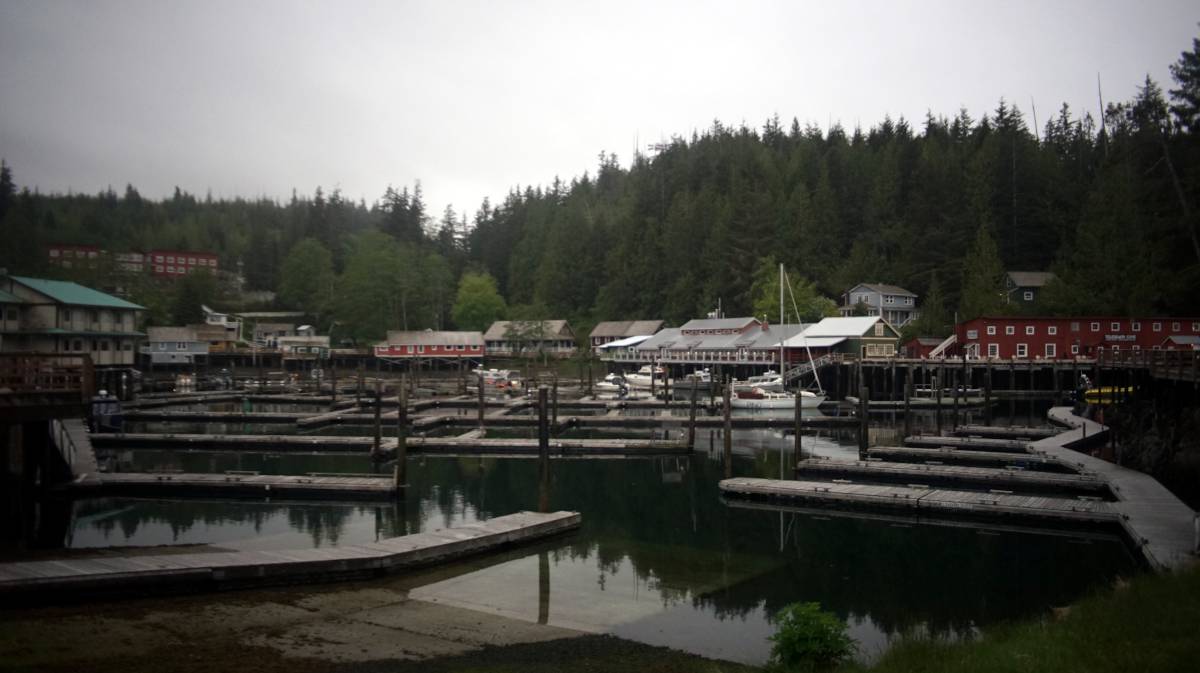 At 0600 our two dock neighbors were already underway, we left shortly after. Today the wind was 15 kn out of the northwest, but we saw that Weather Canada had a gale warning out for Johnstone Strait tomorrow afternoon (30-40 kn northwest) At 0600 our two dock neighbors were already underway, we left shortly after. Today the wind was 15 kn out of the northwest, but we saw that Weather Canada had a gale warning out for Johnstone Strait tomorrow afternoon (30-40 kn northwest)Port Harvey and Boughey Bay would have been 2 good anchoring options to weather out the passing gale, but because it was still early in the day when we arrived at Havannah Channel(the channel leading to the two anchorages), we decided to push on. The downside of anchoring at either of the aforementioned anchorages was that both were further inland, adding extra miles to get there and to return. Aiming for Boughey Bay required us to sail backward for 4 NM — not a desirable prospect. |
| A cruise ship hurried past us, its wakes transformed the sea around us into ocean waves, and its exhaust trail clung to the air long after it had gone. This was the first of many we would see on this trip. The wind left once we passed Havannah Channel, but the current added 2 kn to our speed. We put our engine to work. Peeking inside Calcifer II's chambers, it appeared that the fuel leak had stopped. Arriving at Port McNeill today would have been nice, but it was too much distance to cover in one day. We settled on stopping in Telegraph Cove, despite the fact that their facilites were designed to specifically accommodate trailerable boats, we were able to secure a spot. When we arrived the tide was very low, making the already very narrow entrance into the port appear even more restricted. Pino's fin keel allowed for quick turns, it was an asset in this particular port because of where our mooring spot was located. Near the entrance, we had to circle around an old piling to get to it — we think there used to be another finger here. The marina was empty, devoid of both boats and humans, business was not booming. |
|
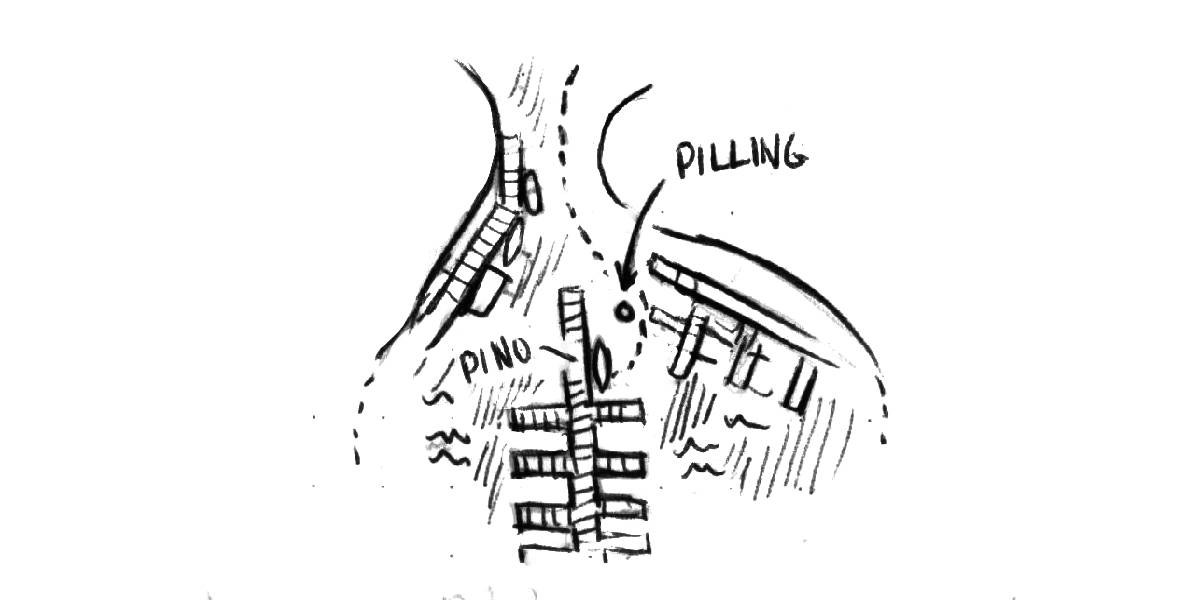 On arrival, we searched for the marina office to pay for our moorage. The harbour front consisted of colorful stilted buildings, with antique hardware strewn across the walkways and boardwalk as decoration. We wandered into the wrong marina office. Despite it being a very small town, the workers at the desk had no idea where the office for Telegraph Cove Marina & RV Park was. "Really?" we thought, "you don't know the location of the office of the marina neighboring yours? The only other facility that you share this tiny harbor with?" On arrival, we searched for the marina office to pay for our moorage. The harbour front consisted of colorful stilted buildings, with antique hardware strewn across the walkways and boardwalk as decoration. We wandered into the wrong marina office. Despite it being a very small town, the workers at the desk had no idea where the office for Telegraph Cove Marina & RV Park was. "Really?" we thought, "you don't know the location of the office of the marina neighboring yours? The only other facility that you share this tiny harbor with?"We wandered around and eventually found the office ourselves. In the shoulder season the workers don't occupy the office building, we had to call them. The owner arrived in a 4x4, with a labrador friend riding in the back. He told us about some of his favorite places in Southeast Alaska. "I caught so much halibut up there!" he said. He sang the praises of fishing for a short while, we listened intently — we didn't have the heart to tell him we didn't eat fish. |
|
| We went to bed early. We thought of staying here for 2 nights due to the coming weather, but we figured we would have time to get to Port McNeill before the weather turned too sour. We were glad the weather was cooperating, but moving non-stop cost us much of our energy. At least, we would be allowed to sleep-in tomorrow because the current only turned in our favor at 1100. We preferred to do transits in the morning, but we couldn't ignore the strength of the current in these waters. The wind was supposed to blow 20 kn out of the northwest, increasing to 20-30 later in the afternoon. We wanted to stop in Port McNeill to replenish our stores of fresh foods, we were down to a few sprouted potatoes, 1/2 a daikon, a 3/4 head of cabbage, and some garlic cloves. We also wanted to buy some firewood for our stove, because the weather will continue to be wet and cold for a long, long time... |
|
| May 16th | Telegraph Cove to Port McNeill Rain, rain, and more rain, it looked like rain would accompany us to Port McNeill. The forecast hadn't changed. Crows kept landing in our cockpit, we watched them through the quarter berth window. "Hm, the weather is not good!" One of them said. We could hear another walking on the deck. Tick, tick, tick, followed by a sudden and loud "CA-CAW!" — code for, "Not good!" They were trying to warn us to stay where we were, but we had it in mind to leave at 1100 to get to Port McNeill, a short 10 NM sail away. From out spot, we could see that there was wind out there, our bow was facing the opening. Telegraph Cove was a safe place, shielded from the elements. We could observe the chaos from the safety of our little quiet nook, but we chose to leave. |
| We added 2 reefs in the mainsail. We knew it was going to be rough, but 10 NM was nothing. The wind was tame, but got stronger as we approached Cormorant Island(lying between Telegraph Cove and Port McNeill). The passage south of Cormorant Island appeared narrow, difficult to tack through, so we decided to sail around the top. It was very rough up there. The wind increased yet again, we had many waves leaping up on deck, our faces were quickly encrusted with salt and various sea things. Tacking in heavy weather is much more demanding. After tacking, I could never reel in the jib sheet back fast enough, the sail caught the wind too quickly, Devine had to point Pino's bow into the wind longer so I could manage it. |
|
| By the time we sailed past Cormorant Island, the water was covered in white caps. We battled 20-25 kn out of the northwest, on the nose. It was a very harrowing ride, our path encumbered by both still and moving threats, shoals, reefs, the ferry to Sointula and Alert Bay. The ferry had time to pass twice, we had to tack to avoid it. We imagined the passengers aboard, watching our progress, seeing the sea as it was, thinking that we must really love sailing. Meanwhile, both of us wished we had listened to the crows and spent the night in Telegraph Cove, our cosy, calm nook. We had not considered wind against tide when we left the dock today, we're not sure why we didn't. "We are such fools," I thought. Our rain jackets were covered with salt, our faces were stiff, hardened by weather, the ride felt unending, like we'd been at sea for years. We assumed that the ledge north of Port McNeill would shield us from this wind, it didn't. Pino's headsail is on a roller furler, in heavy weather, if we roll in the jib too tight it won't roll all the way, and if we roll it in too loose, or crooked, the wind will find a way in and cause part of the sail to balloon out while partially furled — this last bit happened to us today. While I was in the cabin on the radio trying to secure us a slip, the wind saw an opportunity to sneak into the loose bit of sail. "Oh shit!" I heard Devine say. We were very near the marina docks at the time, a terrible place for that kind of thing to happen. The wind pumped air into the top part of the furled sail, ballooning it out, the strong winds then caused the bulge in the sail to flail violently, shaking the entire rig in a very disconcerting way. At that point unfurling the sail was impossible, the only way out of this mess was to do a full 360-degree turn with the boat to unroll the balloon in the sail, only then could we unfurl the sail again to secure it(this wasn't the first time since has happened to us). The jib was well-secured after that, we made sure of it. All of this happened 10 m (33 ft) away from the dock, it is not fun to have an audience when things go wrong. |
|
| The only available spot in the harbour that day was at the municipal marina, the one most exposed to wind waves, laying outside the protection of the breakwater. The other marina was full up. "Blustery wave pool it is!" we said, as the wind brought us onto the dock. We added our line snubbers to the bow and stern lines to try and cushion the violent motion. The fenders were screaming with every wave, there was white foam everywhere, a storm was brewing in the gap between Pino and G dock. We had come to Port McNeil to re-supply, but also to relax, this wasn't relaxing. When inside the cabin, it felt like being at sea. Being at anchor might have been a better choice, but moving was not possible now, Pino was pinned to the dock by wind and waves. We had made a lot of bad decisions today. After paying our moorage, Devine desperately wanted time off the boat, we went for a walk in town to the grocery store. We bought a baguette, cucumbers and carrots. "Fuck it," I said, "let's buy some pre-made hummus." We never buy pre-made hummus, we always make our own, but today we were tired and hungry. I then saw the price of a small tub of hummus, "we... are making our own hummus!" |
|
| When we arrived back to the chaotic mess that was our home, I went to work quick-cooking some chickpeas, I prefer to soak them overnight, but today we had decided on it late. I parboiled some dry chickpeas for 10 minutes, covered the pot, let them rest for an hour, then cooked them in the pressure cooker. For a moment, I wasn't sure homemade hummus was going to happen, because somehow I had lost the pressure cooker's little rubber vent plug, without it the cooker wouldn't hold its pressure. Luckily, I had kept the old one as a spare! I had replaced both the plug and the seal earlier this year, the seal was too worn to keep, but the plug was fine. We ate our hummus, doing our best to ignore the weather outside. A good baguette helped to soak up our worries. |
|
| May 17th | Port McNeill The boat quit being a bouncy castle sometime in the night. Come morning, the wind and waves having diminished, we moved Pino to a better, unoccupied spot. The harbourmaster had told us that we could move to that slip when the weather abated. Once at our new protected spot, we prepared some pancakes and coffee. Today was a day of rest! The boat quit being a bouncy castle sometime in the night. Come morning, the wind and waves having diminished, we moved Pino to a better, unoccupied spot. The harbourmaster had told us that we could move to that slip when the weather abated. Once at our new protected spot, we prepared some pancakes and coffee. Today was a day of rest! |
| After lunch, having just learned what a burl was, we went to seek out the world's largest burl, displayed nearby in Port McNeill. It was cut off a 552-year old Sitka Spruce. Unfortunately, the burl had lost some of its former majesty, it was now half-charred, laying in the gravel and bound with security tape. Last year, 2 teenagers had set fire to it, the burl wasn't consumed entirely by the flames, but it bore the injuries of that event. Despite the event, the crispy burl continues to draw in tourists. Walking on, we went to the hardware store to pick up a small maul and some fire wood. Up until now, our good friends Rik & Kay had been giving us starter for our stove, since they too had a wood stove and that ours wasn't terribly demanding. Now, it was time for us to chop our own! |
|
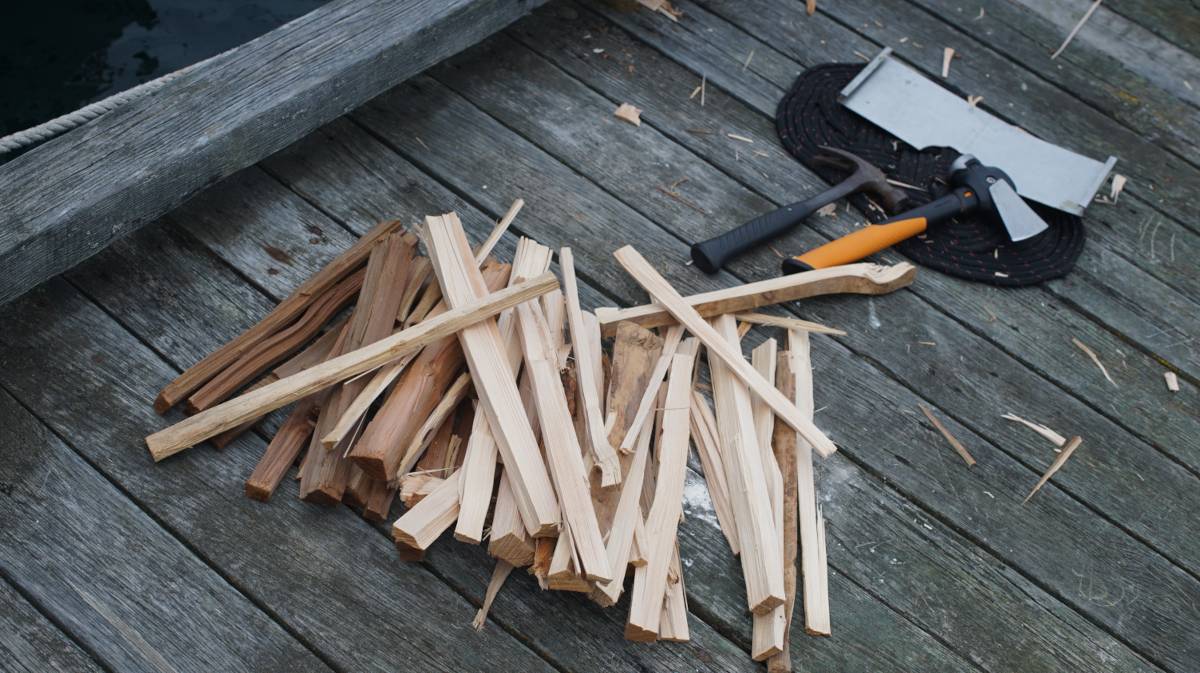 We bought a few logs, found a nice small(but heavy) maul, and went to work splitting the wood on the marina docks. Devine would hit the back of the maul with a hammer to help it along, then break off thin pieces, which I would then cut in half lengthwise with a hacksaw(so it could fit inside our tiny firebox). We knew we couldn't carry enough wood to keep the stove running constantly, but it was useful to warm our space on cold mornings and late evenings. We filled Pino's aft locker with wood, storing the rest in bags in the starboard side cockpit locker. We bought a few logs, found a nice small(but heavy) maul, and went to work splitting the wood on the marina docks. Devine would hit the back of the maul with a hammer to help it along, then break off thin pieces, which I would then cut in half lengthwise with a hacksaw(so it could fit inside our tiny firebox). We knew we couldn't carry enough wood to keep the stove running constantly, but it was useful to warm our space on cold mornings and late evenings. We filled Pino's aft locker with wood, storing the rest in bags in the starboard side cockpit locker.We finished splitting the wood just as the rain started. The rain revealed a leak on one of the starboard side chainplates. When the deck dries out, we will fix the leak. |
|
| We met Viktor and Caroline on their Cheoy Lee sailboat Moonshine today, they told us they wanted to go up as far as Prince Rupert. They planned to cross Queen Charlotte Strait on Monday, we had our eye on that same window. Having one extra day to relax was nice, my entire body hurt. Sailing in big weather left us with bruises, my left side and knee hurt, and because of all the sawing my back now complained too. Devine also had a few aches. "My arms are like jelly," they said, after spending an afternoon splitting wood. Yesterday, Devine handled the rough sail and the jib ordeal very well. They responded quickly, and so effectively that the jib problem was soon solved. At times, I freeze up, waiting for death to come. I can handle difficult situations well most times too, but if my senses are overloaded, I get overwhelmed. I am so glad to have Devine aboard, everyone needs a Devine. |
|
| May 18th | Port McNeill Ahh—to sleep in! What a luxury! Devine resumed work on implementing Paradise in Modal this morning, while I updated the cruising notes on our wiki. There was a lot to say about the places we'd been so far, it is less overwhelming to document if I update it as we go. |
| After lunch, our plan was to top off our fuel. Moving the boat to fill 2 bins seemed silly, so we called North Island Marina to find out if we could walk onto the fuel dock — the fuel dock was behind a locked gate, most people don't walk onto a fuel dock, they bring their boats. The marina was kind enough to give us an access code. I fixed the leak in the chainplate, adding more butyl tape to seal the deck. |
|
| Later that day, we spent time with Viktor and Caroline. We will both cross Queen Charlotte Strait on the 20th, the only calm wind day since May 16th. During our conversation, Devine continued to spread the joys of sprouting legumes, Caroline seemed very enthusiastic about the process. | |
| We prepared sushi rolls for dinner, with avocado, cucumber, carrots and tofu. We don't always eat well in the summer because we lack fresh ingredients, but this year we left Victoria with 15 jars of lacto-fermented vegetables. This summer, we also bought small quantities of beet and kale powder. Fresh beets and kale don't last, but the powders, if kept dry, last a long while. We like to add beet powder to chili, hummus and pasta sauces. Kale powder is bitter, more difficult to mix into meals, but we try to add it as often as possible. | |
| These days, by 2000 we are in bed, not sleeping, but doing whatever we'd be doing normally... but in the bed. May mornings and evenings were still cold, both of us tucked into bed was a great way to keep warm while saving on wood. We heat our bodies first, with clothes and blankets, if that wasn't enough, we fired up the wood stove. At around 2130, I read aloud to Devine, either until they fell asleep, or until my jaw got too sore. |
|
| May 19th | Port McNeill The wind has not stopped roaring ever since we arrived, the afternoon winds were especially ferocious. We didn't have any tasks planned for today, we just wanted to buy more food, fill the water tank, and maybe study anchoring options for tomorrow. This was our 4th day in Port McNeill. We enjoyed our time here, but now we were eager for some quieter weather that would allow us to move on. We'll get up at 0430 tomorrow to catch the last of the ebb out of here, then we'll see how far we can get. We will still have to contend with currents in these waters, we're looking forward to not having to plan around that (a note from the future: oh Rek, you sweet summer child... from that point on the current planning never stopped). Planning around gales wasn't fun either, but that's what we get for sailing in this area in the shoulder season. We have to make progress when the monster's eye isn't fixed on us. |
| This was our last dock day for a long while. We will go to bed early, and hopefully the ocean will treat us well tomorrow. | |
| May 20th | Port McNeill to Millbrook Cove Up at 0430, gone 20 minutes later. It was dark, but the harbor was well-lit. Caroline & Viktor waved us off, they were moments from leaving too. The current would be with us until 0730, we had to make as much progress as possible before it turned to full flood. |
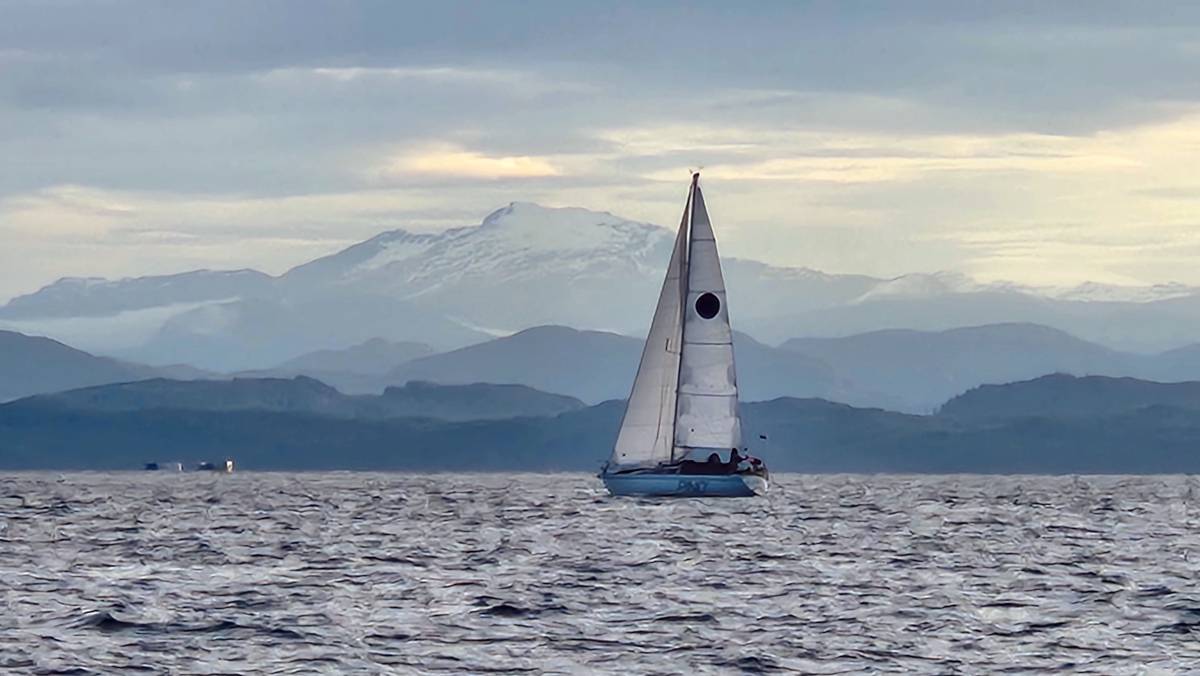 We left the marina first, but after rounding the Pulteney Point Lighthouse, boats started catching up to us, their cruising speed permitted them to leave a little later, they too were eager to move on the one day that a gale warning wasn't in effect in Queen Charlotte Strait. Our sails were up, but Calcifer II was doing most of the work. A light wind added to our speed, but it was slowly dying off. Moonshine was behind us, they overtook us, and quickly disappeared into the faraway haze. They took the middle route, while we chose to head towards the north shore. We knew the current would turn once we got there, if it hindered our progress too much we would backtrack to Blunden Harbour, if it didn't we would go to Allison Harbour, or Miles Inlet. We left the marina first, but after rounding the Pulteney Point Lighthouse, boats started catching up to us, their cruising speed permitted them to leave a little later, they too were eager to move on the one day that a gale warning wasn't in effect in Queen Charlotte Strait. Our sails were up, but Calcifer II was doing most of the work. A light wind added to our speed, but it was slowly dying off. Moonshine was behind us, they overtook us, and quickly disappeared into the faraway haze. They took the middle route, while we chose to head towards the north shore. We knew the current would turn once we got there, if it hindered our progress too much we would backtrack to Blunden Harbour, if it didn't we would go to Allison Harbour, or Miles Inlet.The wind left us after we passed Port Hardy, we knew this would happen, but Pino and the rabbits pushed on. |
|
| The day was mostly grey, but a visit by a humpback whale illuminated the scenery. They swam alongside us for while, showing us their fluke before diving deep. The current did slow us down, but we were still going at 3 kn which allowed us to put a cross on stopping at Blunden Harbour. We put a cross on many more anchorages, because when we arrived at Allison Harbour we decided to push on. |
|
| Devine is really, really terrible at gauging how far things are. "So, where's Cape Caution?" I would ask, staring ahead at some distant mountains. Devine, who had the chart plotter in view replied, "it's right after that hill there!" No, it was not right after that hill there, it was after many more hills there, and would take 3 hours to reach. "Is that Cape Caution?" Devine glanced at the chart again, "yes!" No, it was not Cape Caution, we couldn't actually see Cape Caution yet, it was in that moment a barely discernible, pale hill, lying 15 NM away. Really, I think Devine does this to give me a sense of progress, saying "it's so close!" when it was 25 NM away. | |
| Arriving at Miles Inlet, we did that thing again when we change our mind and sail further. "It's so calm today, we should go around Cape Caution," Devine suggested. We had planned for stops at 8 different ports, to give ourselves some options should conditions change, all located on different parts of each leg, guaranteeing us a safe harbour no matter what nature threw at us. "Yea, okay! Let's do it!" I said. Conditions around most capes are bad in heavy weather, especially when ocean waves hit shallow waters near shore. This was true for Cape Caution, the waters shoaled to 9-15 m (30-50 ft) near the cape. To make matters worse, Cape Caution was preceeded by another danger: Nakwakto Rapids — one of the fastest and most turbulent rapids in the world. When the channel is at peak ebb with an opposing wind, the contact between the two will generate very large waves in the north part of the strait. Today, there was no wind, the ocean waves were down, Slingby was flooding, a perfect day for rounding the cape, but it meant spending much more time on the water. |
|
We passed near Cape Caution, a fine thing to do when conditions permit it. The sea near the cape was like liquid metal, highly reflective, and smooth.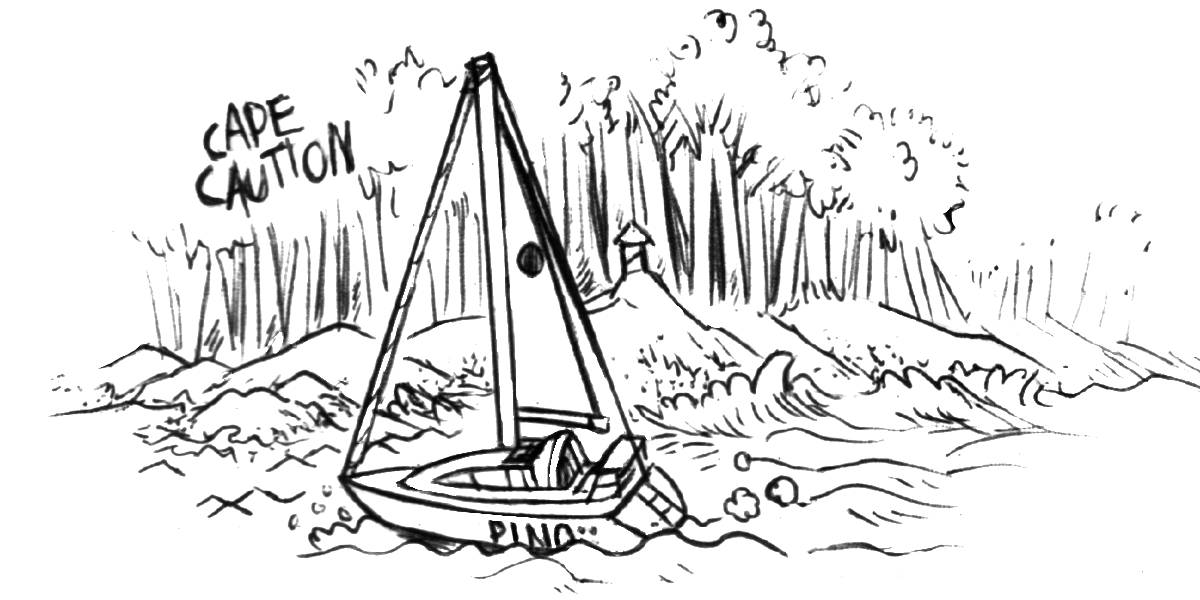 |
|
| Hello ocean swells! The waves were very tame today, but in the absence of wind the long swells caused the boat to roll, which in turn, sparked a feud between my ears and inner ears... in short, I couldn't finish my lunch. We saw our first sea otter! We mistook it for a floating log, with 2 truncated branches, but when the driftwood uncrossed its legs and dove, then we knew. |
|
| We raced a fog bank to Millbrook Cove, Pino crossed the finish line first. We dropped our anchor in 8 m (26 ft) at exactly 1800, having crossed the whole length(55 NM) of Queen Charlotte Strait. Devine went to sleep as soon as we arrived, burritoed into our fluffiest and warmest eggplant-colored blanket. Moonshine was there, we had not expected to find them here, then again, we weren't supposed to go up this far either! We had made a lot of progress today, we were officially past the top end of Vancouver Island! |
|
| Later, we fired up the wood stove to rid our space of dampness. The rain started at 2000, the chainplate leak was now gone. We had pasta with garlic and chili flakes for dinner, while using the last of my laptop's battery to watch Hunt for the Wilderpeople. There was no cell reception here, but we could get the weather via VHF. |
|
| May 21st | Millbrook Cove La grasse matinée ce matin! We got up late, weary from yesterday's long day on the water. The wind was supposed to rise to 20-30 out of the northwest today, that was too much wind to beat into. We were in open waters, we would not make good windward progress in big seas. When heading out of Millbrook Cove tomorrow we will likely have to contend with some proper ocean swells, when coastal sailing, wave height is an important metric when choosing a day to go to sea. |
| By lunch time, the wind was blowing hard into the anchorage, sending us flying with every gust. It has been excessively windy ever since we left Victoria, yesterday was the only calm day. I tried to draw this morning, diving into my conworlds to briefly escape my tempestuous reality. Devine was having fun re-mixing a song. "Our house, in the middle of our... our house, in the middle of our... our ho-" The song repeats the same phrase non-stop, an appropriate theme song for a game like Paradise. |
|
The 20-30 kn forecast increased to 30-35 kn. Millbrook Cove, so calm yesterday, now a mess of wavelets and disheveled trees. Speaking of dishevelment, while browsing through a book about the sea creatures of the Pacific Northwest, Devine found my spirit animal: the disheveled sea mouse, a thing that lives on the ocean floor with unkempt hair. When struggling to solve a problem, I run my hands through my hair, throwing all of the strands in different directions.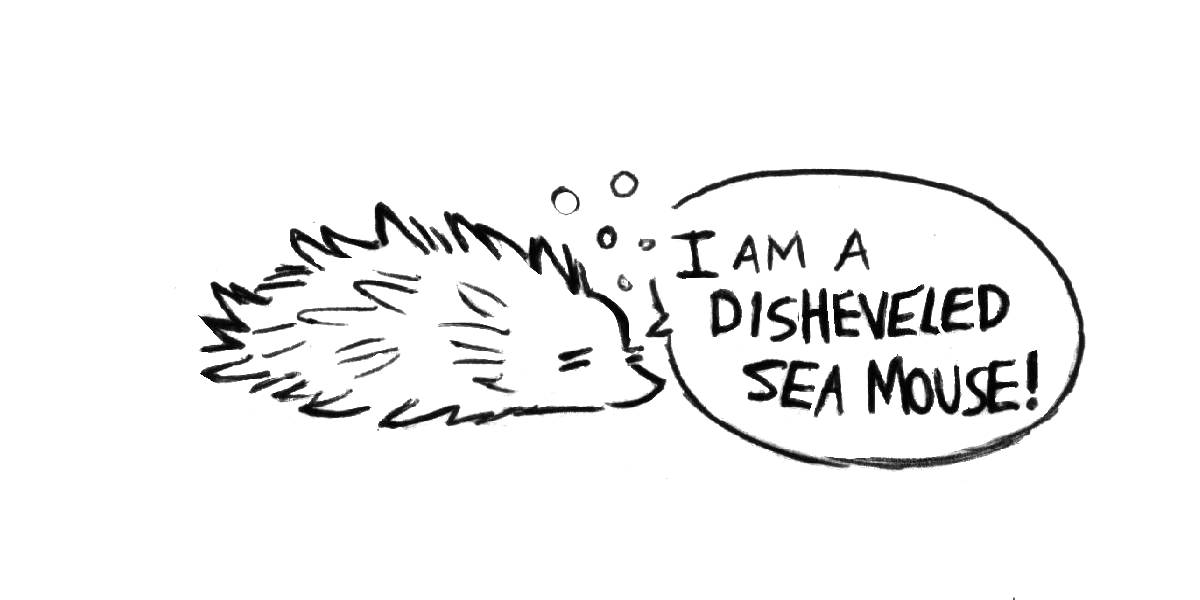 Welcome to the B.C. north coast, home to a never ending waltz of mean weather systems. Gales come in succession, leaving very little calm or moderate weather in between, because it amuses them to see us sailors cower into our little coves and bays. Gales make a game of trying to dislodge our anchors. The wind can be real mean sometimes, but it is difficult to be mad at wind, wind is our main fuel. You are making it hard for us to love you today, dear wind... Welcome to the B.C. north coast, home to a never ending waltz of mean weather systems. Gales come in succession, leaving very little calm or moderate weather in between, because it amuses them to see us sailors cower into our little coves and bays. Gales make a game of trying to dislodge our anchors. The wind can be real mean sometimes, but it is difficult to be mad at wind, wind is our main fuel. You are making it hard for us to love you today, dear wind...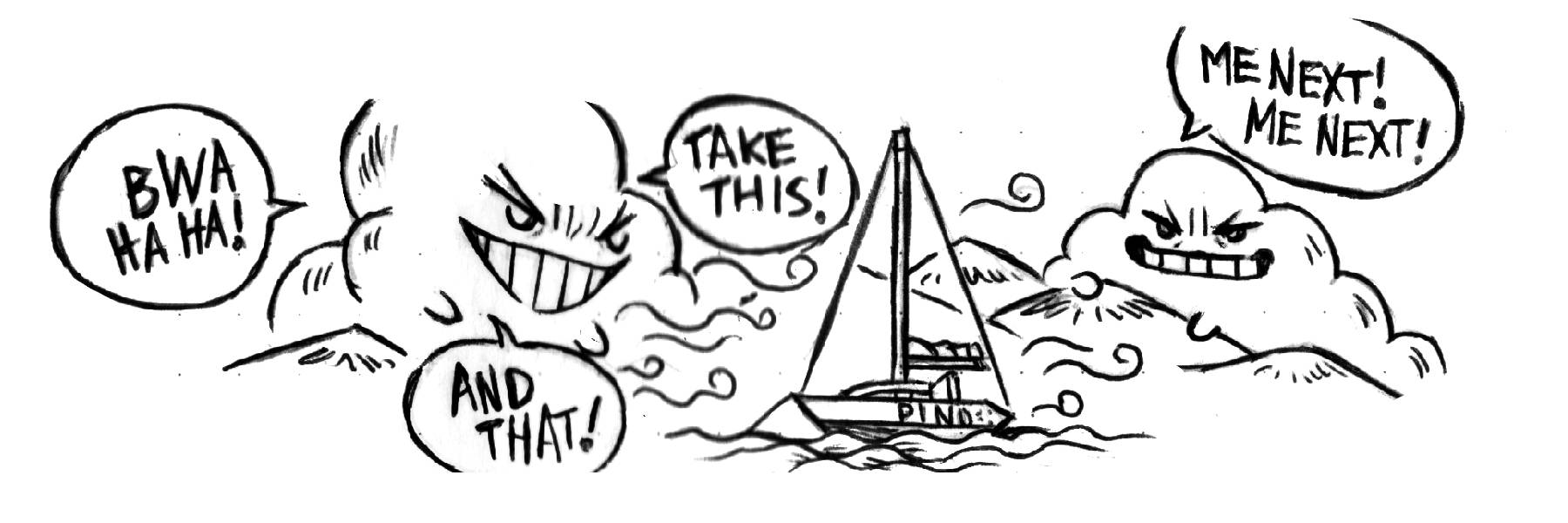 |
|
| Week 4 | |
| May 22nd | Millbrook Cove to Fury Cove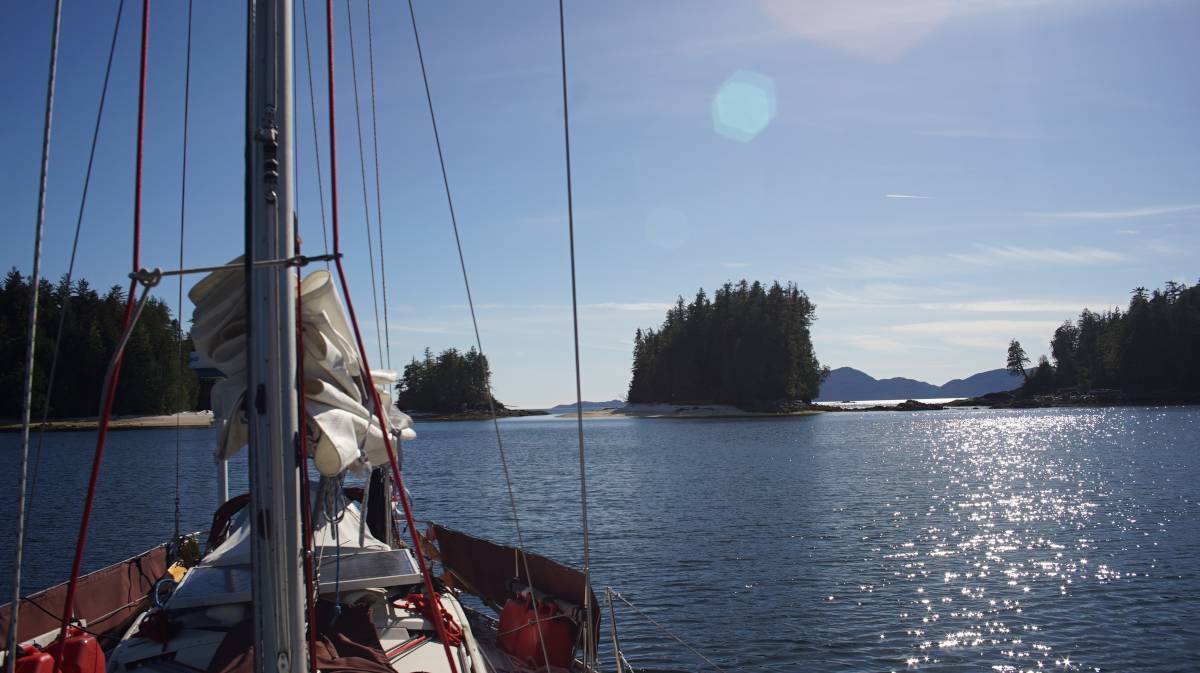 The wind abated sometimes during the night, or at least could no longer make it past the treeline enclosing our anchorage. The wind abated sometimes during the night, or at least could no longer make it past the treeline enclosing our anchorage.We woke to the sound of a horn, Caroline and Viktor were leaving. "Weather was crazy yesterday wasn't it?" Caroline shouted, "see you in Prince Rupert!" And, off they went. Their departure gave us the kick in the butt we needed to begin our own day of sailing. |
| The wind was still 15-25 out of the northwest, our goal was to make it to Fury Cove, it ought to have been a short sail. We had a pleasant downwind sail out of Millbrook Cove, but as soon as we rounded the point, it was time to tighten the sheets and to beat to weather. A lot of this coast is reef-strewn, the oceanside appears to have been devoured by termites and the rocks are the crumbs left behind. We spent a lot of time putting distance between us and these "crumbs", pointing into the open Pacific for a short time. "Let's go to Kodiak!" Devine joked, I wasn't amused, 15 NM already felt like an eternity. We don't have as much patience for long sails when sailing near shore, because it demands more out of us, we don't have the option of heaving-to for a whole day if we're exhausted. | |
| We tacked back towards the shore, then back to the ocean, then shore, ocean, shore etc. We tacked yet again, but only managed to sail right back to our starting point. The closer we got to Calvert Island, the less progress we made. Calvert Island was toying with the wind direction, sending us away, as if to say: "Go play elsewhere!" To gain a few miles, and to have a better angle to the wind, we cheated, woke Calcifer II, and made it closer to our anchorage on Penrose Island. We resumed sailing once at the mouth to Fitz Hugh Sound. We were making progress again, but both of us were starving by then, but we'd wait to arrive before preparing food. Neither of us had checked the time, we pulled into Fury Cove at 1600 — yep, we had been tacking for nearly 6 hours. 15 NM, short sail indeed. | |
| Fury Cove was well sheltered, with a white sand beach and a gap in the trees opening onto Fitz Hugh Sound. The sky was blue, it was warm too. I shed my wool shirt, fleece, and base layers. Devine joined me outside on deck, we were like lizards in search of a warm rock, cormorants looking to dry their waterlogged wings. We ate some jap chae, while watching The Martian. We finished reading the book yesterday, and now we wanted to watch the movie to compare. Kristen Wig playing Annie was an excellent casting choice. |
|
| May 23rd | Fury Cove to Codville Lagoon Time to leave paradise. Our cozy window overlooking Fitz Hugh Sound confirmed that the wind had switched to the south. South Winds! Finally! We raised Pino's wings while in the lee of an island, and sailed north with the wind at our backs. After days of beating to weather, sailing downwind was like floating on a cloud. |
We set up the whisker pole for a better downwind angle for the jib. Marvelous. Sailing downwind was magical, like being pushed and pulled at the same time. But the motion is clumsy, Pino bobs from left to right. The only way we've found to describe this awkward motion is to imagine someone playing the tuba(YouTube) over a cartoon.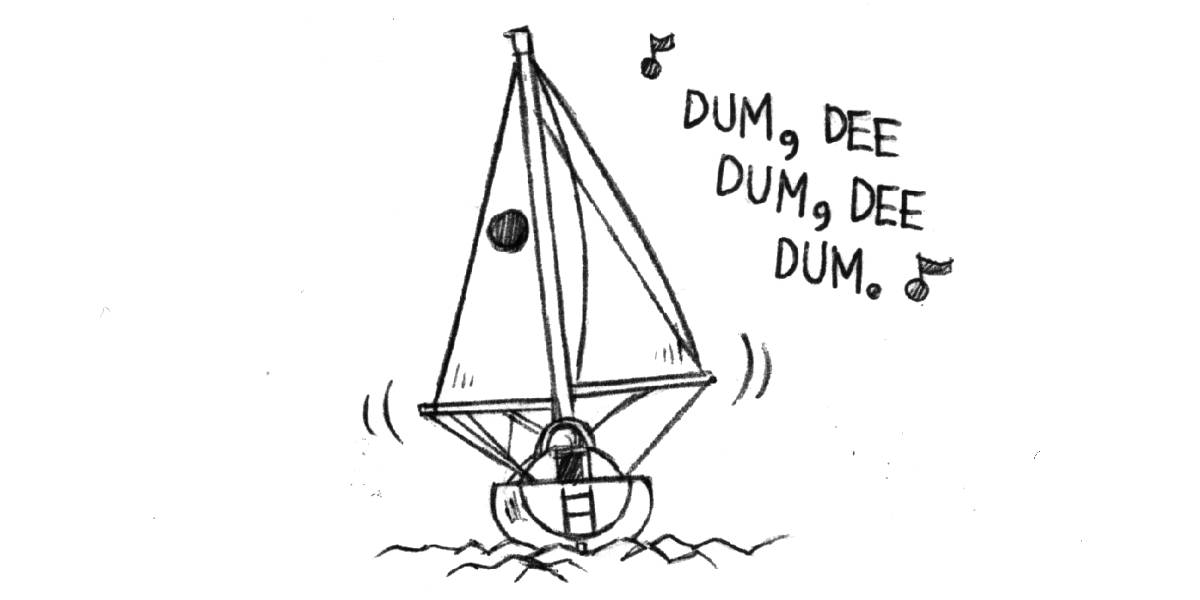 |
|
Our goal was to get to a place called Codville Lagoon, 40 NM away. "Ah, yes, Codville. The cod committee will be waiting," I said to Devine, "we must pay the cod tax." Our fantasy world was populated by greedy and opportunistic animals. "Yes, hello! You must now pay the gull tax!" A pair of black-headed gulls, perched on a piece of driftwood, said to us as we sailed past, but we pretended we hadn't heard. "You must paaay!" They continued to say, disappearing in the distance, folding back into the scenery.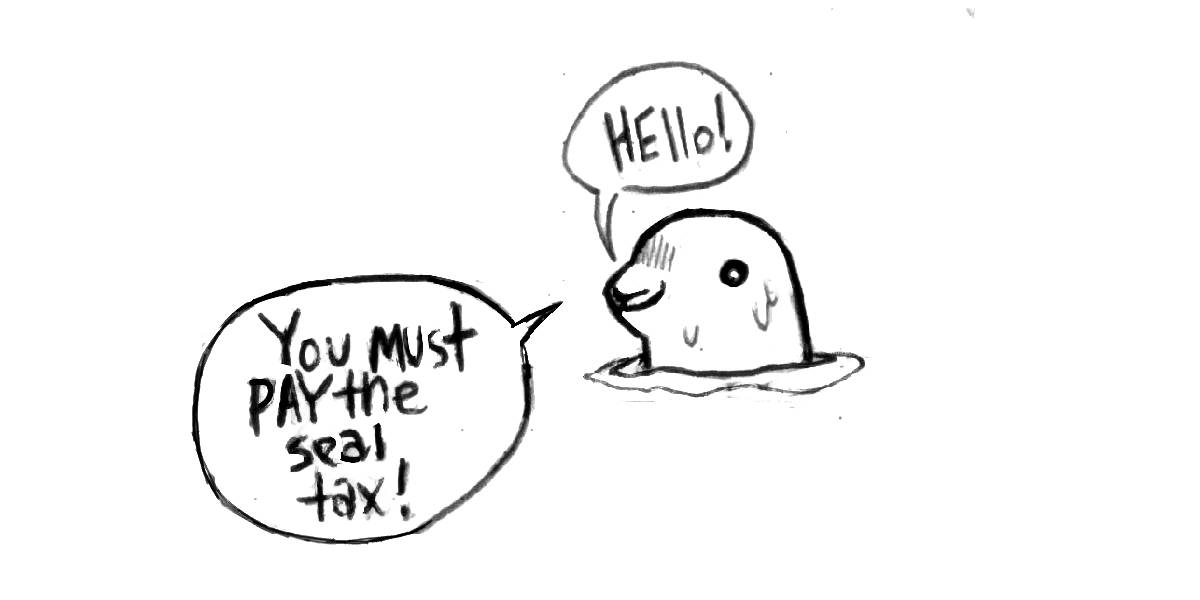 |
|
| The rain began, I put on my rain jacket, Devine did not. "You should change," I said. "Nah," Devine replied with a playful smirk. "You're gonna get so wet. That jacket takes forever to dry." Nearer to our destination the rain increased, as did the water content of Devine's jacket. "Well..." Devine began, reading my expression, "too late now!" I sighed, "indeed." |
|
| The wind carried us through the whole length of Fitz Hugh Sound and over to Codville. When turning towards the entrance, Devine pointed at energetic splashing in the distance, two humpback whales were jumping out of the water. "Uh oh," I said, "I think the cod committee is no more." We hugged the southern shore, giving them plenty of splashing room, we had stay near that shore anyway because of a submerged rock. The narrow channel opened onto a large protected basin, surrounded by tall green mountains. The weather won't find us in here, I thought. We went to anchor in the east basin, near a trailhead, dropping the anchor in 11 m (35 ft). | |
| Rain started to fall more heavily, so we took shelter inside the dry cabin. We threw a few logs in our woodstove to dry the space further. This place really was lovely, but because of the heavy, incessant rain, we couldn't really enjoy it. The rain on the windows obscured our view of paradise. Some weather did find us in Codville, blowing in from the entrance. Low tide revealed a few giant boulders nearby, like teeth jutting out of the ocean floor. The wind was attempting to push us into the belly of some mighty sea beast. The night didn't bring any bad surprises, the wind and the boulders left us alone. I fell asleep while writing this entry, pencil in hand. Sleep came, sleep stayed. |
|
| May 24th | Codville Lagoon to Lizzie Bay The forecast for today called for 20-30 kn out of the northwest. Our plan was to move the boat past Bella Bella to better position ourselves for tomorrow's southerly winds. I lifted the anchor by hand today, we only use the chain hook method to avoid injury, if doing it by hand is too difficult. I should have used this method today, I pushed myself a bit too hard, I'm not sure why I did that, after hoisting the anchor it felt like my forearms were going to blow up. |
| Two small boats entered the anchorage as we neared the exit. There was some current in the pass. "Hm," I thought, "strange, the current ought to be with us, not against us, what sort of current witchery is this?!" As we approached the mouth of Lama Passage, we noticed our speed was going down. "Hm!" I said again, feeling like the world's worst detective. "I guess the current in Lama Passage floods east?" We could still go forward, but it was robbing us of 2 kn of speed, costing us more fuel. We later learned that the flood meets from many directions in Fitz Hugh Sound. I deduced the flood direction based on the chart, I ought not to have planned this passage on a guess. Sherlock Holmes would not be impressed. |
|
| Our plan was to go to Discovery Harbour, 20 NM away, but aiming for that now without a helpful current was silly. We pushed through part of Lama Passage, but instead of going north to Bella Bella we turned our bow towards Lizzie Cove. Stopping here instead meant we'll have more distance to cover tomorrow, but at least we'll leave with a helpful current. Only the widest part of Lama Passage had wind, a bitter cold wind, we were frozen solid. Thankfully, we only had to travel 12 NM today. | |
| Lizzie Cove had a tricky entrance, with uncharted reefs obstructing part of the way inside, luckily, others had documented these obstructions. Our chartplotter didn't show some of the rocks, but Navionics users had added them to the charts. The back bay had a few floating buildings occupying the shallower parts of the cove, but there was room to anchor west of them. Once anchored, it took a long time to feel warm again, having a good helping of zaatar pasta helped. | |
| We will sleep early today, we have 55 NM to do tomorrow. The wind will be light in the morning, but we'll use that to motor through Bella Bella to Seaforth Channel, then hopefully, we will meet some south winds near noon to carry us around the bottom of Price Island. Winds were supposed to start at 15 kn from the south at noon, rising to 15-25 in the evening. The next few days have more south winds in store for us too, which ought to help push us up through Laredo Channel, and maybe Principe Channel the next day. | |
| May 25th | Lizzie Bay to Higgins Passage The wind was meant to switch to the south today, we would go out to catch some before the giant in the sky ran out of breath. |
| We motored out of Lizzie Cove, skirting by shoals and other unseen dangers, but at least now we knew where they were. We made our way up Lama Passage, towards Bella Bella, on flat waters — with a helpful current this time. The Bella Bella ferry was still asleep on the dock, we tip-toed past it, hoping it would stay where it was. Bella Bella though was awake, small boats zipped around its harbour, colorful houses lined its shores. For a moment we thought a large boat was coming towards us, but no, it was derelict, it might have been able to move once, but now it was unwanted, waiting for weather and time to wear it down to nothing. |
|
| Pino turned into Seaforth Channel, the water was calm, slick as ice. We spotted 5 targets behind us on AIS, a small motor boat regatta. One boat came near us, opening its window to say, "we're slowing down not to make wakes!" We smiled, "thank you!" Devine shouted back, waving. We don't always wave to people on motor boats because we can't see them through the cabin windows, but sometimes people take the time to open a window, or pop out of the back to wave — a very sweet gesture. The motored vessels felt more alive, carrying people with stories, they weren't just noisy automatons following waypoints. | |
| We saw a lot of wildlife while in this channel. First, a pair of sea otters, lying on their backs, which we once again mistook for logs, but we were able to make out their features better this time. Later, we spotted a very active humpback whale, it was leaping out of the water every 5 minutes. It swam close, we diverted and then at our stern, we saw it erupting out of the water (see a short video we took). | |
| We left a light breeze as soon as we exited Seaforth Channel, as if the wind had been waiting for our arrival to begin. We sailed on a beam reach towards Catala Pass, south of Price Island. It was difficult to see the entrance to this reef-emcumbered pass from afar, this place was weather-beaten, ground down by winter storms. We kept a close eye on our chart, to make sure not to miss a shoal, or a rock, waves dance overtop of them, waving to warn us, "I am here! Go Around!" The wind was tame, but the sea was messy, disturbed by the many obstructions in the water. Cutting through Catala Pass saved us a few sailing miles. | |
| Devine hadn't slept well last night, and took a nap while I steered us up the west coast of Price Island, it appeared to stretch to infinity before Pino's bow, mostly because I never look away long enough for my eyes to discern notable changes in the scenery. We thought of anchoring in Osment, or Parson's, but we instead decided to try Higgins Passage. It was now 1600, and we were both fed up of being in the cold. | |
| Getting into Higgins Passage would require careful piloting. We were becoming more daring when choosing anchorages. The entrance to Higgins, a passage tucked between the north of Price Island and the south of Swindle island, was very tight, with many hidden dangers. The reefs were very near one another, we could see where they were, but we would have preferred passing through areas with fewer dangers. | |
| Once inside, the waters were calm, populated with many islets to explore. Pushing deeper into Higgins Passage, we saw a group of kayakers camping ashore, making a fire. We were cold, we too were eager to get warm. We thought it crazy to find kayakers here at this time of the year, in this kind of weather. | |
| We anchored in 9 m (30 ft). Like on most cold days, Devine went inside to start a fire. We ate gnocchi for dinner, then fell asleep at 2030. 25-35 kn southeast winds woke us up at 0100. Our spot was safe, but the noise made it difficult to sleep again. "You still awake?" I asked Devine at 0400. "Yes." We both sighed. |
|
| May 26th | Higgins Passage to Bone Anchorage We slept in today, to try and recover from yesterday's lack of sleep. We got up at 0800, had breakfast and coffee. We were back to eat oatmeal, after running out of bread for morning toast. The weather outside was terrible, it was raining hard, the wind was still howling. We had planned to leave today, but we couldn't bear the thought of being out there. We were both exhausted, the melancholy landscape made us want to cocoon, but the cocoon idea collapsed when Devine said, "we should go." "Yea, we probably should," I said. |
| The wind was still up, but we only had 10 NM to make until past the top of Swindle Island, and another 10 before Aristazabal Island offered us shelter from the waves. The wind was in the south again tomorrow, and then it would be too light to sail. We knew it would be better to push on today to try and get as many miles in as we could, while the weather was still with us. Squandering these good winds would be silly. So, we layered on all our warm clothes, ready to face a very wet and cold day on the water. Our chosen anchorage was 35 NM away, it was far, but manageable with good winds. Unfortunately, there weren't many good anchoring options in the area, the very good ones were far, the closest ones didn't offer protection from southerly winds or required careful timing on arrival because of rapids. The only safe place that wasn't too far from where we were was Bone Anchorage at the head of Racey Inlet on Princess Royal Island. |
|
| During a break in the rain, we went outside to lift the anchor. I accidentally pulled up a lion's mane jellyfish, I was glad I saw it before bringing it on deck because they can sting. I wear rubber gloves when pulling the chain, but the gloves were now worn, full of holes. I lowered the chain back down again to allow for the jellyfish to return to the water. Once the anchor was up, we hoisted the mainsail, putting in 2 reefs. We knew there was still a lot of weather out there, it was better to play it safe. |
|
| One reason I was hesitant to go to Higgins Passage yesterday, was because I was afraid that leaving the anchorage in big southerly winds would be too dangerous. The exit, as I described earlier, was full of reefs, and it was not very well protected from waves. I was concerned about the size of the waves that we would find out there... I wasn't wrong about the big waves at the exit. Our proximity to shore caused them to swell up to monstrous heights. The reefs did what they do best, continuing to lie in the way — such discourteous reefs. Getting away from the anchorage was dicey, one large wave threw us hard sideways, but we recovered quickly. We thought we had perfected the art of stowing items in big seas, but there was always one or two things that came rolling out to prove us wrong. "Hey, hey! Look at me!" they'd say. "No! Go back to your spot!" They never listen, and proceed to tumbling around the cabin floor, waiting for us to move them. We motor-sailed until we were a bit further from shore, if we only sailed we ran the risk of drifting too far towards the shore. We shut Calcifer II off as soon as we were clear of dangers. |
|
The sea conditions improved once we arrived into Laredo Channel. Devine had been steering into the worse of the waves, and went inside to rest while I took over. Devine got the waves, but I got the rain. Yes, the rain and came, it fell heavy, reminding me of what it was like sailing through squalls while in the South Pacific ocean. The rain clouds brought stronger winds along with them. Luckily, I was prepared for both rain and cold! The rain jackets and bibs we got were PVC, they kept us dry. When our former foulweather jackets got wet, they stayed wet, but our new rainproof gear would dry very fast, so they didn't bring too much humidity inside the cabin. The only issue with those jackets is that they weren't warm, so today, we wore our other foulweather jackets under the waterproof coats — perfection. Going to the head, having to peel off all of those extra layers was an ordeal, but staying warm was important.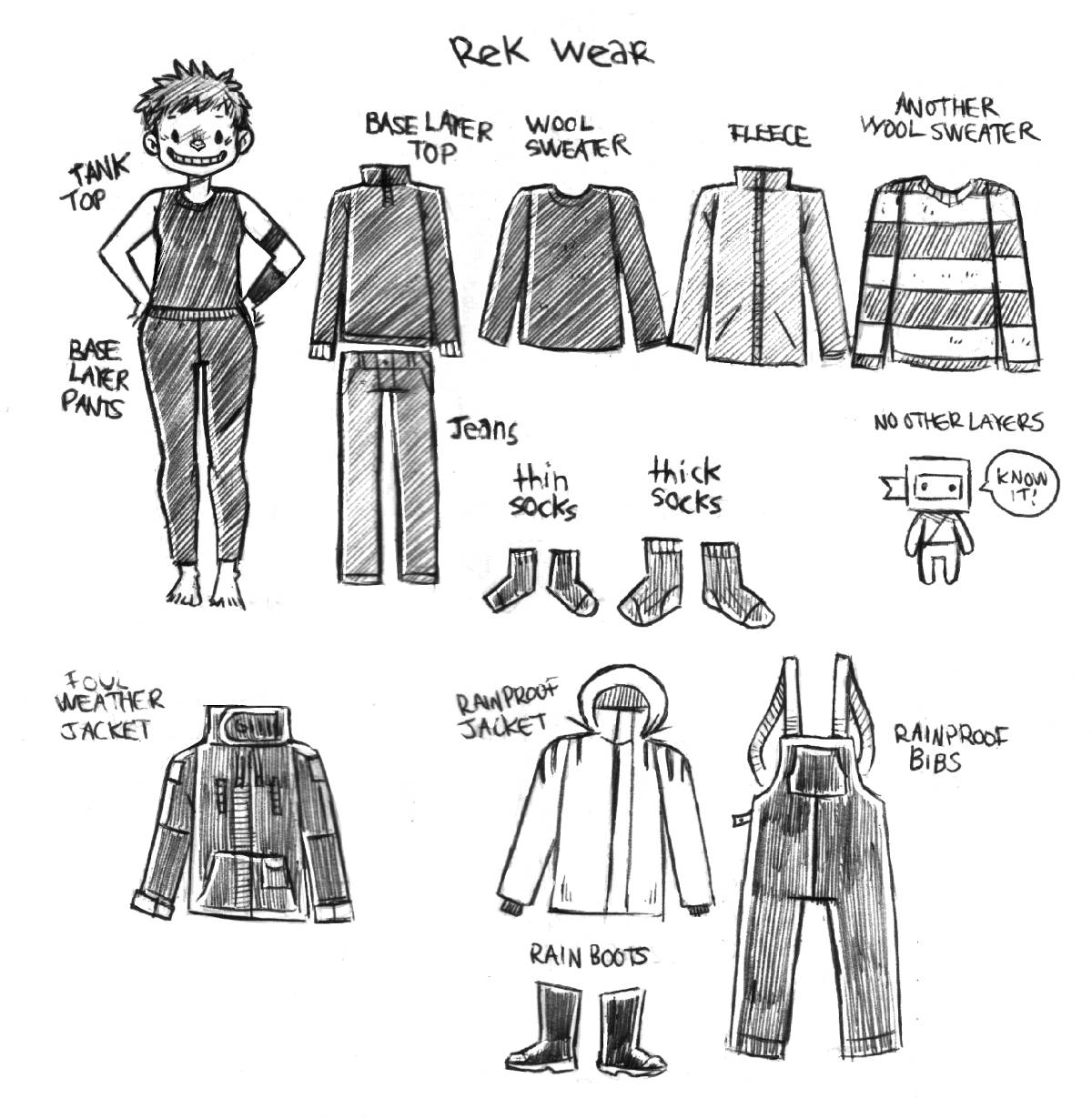 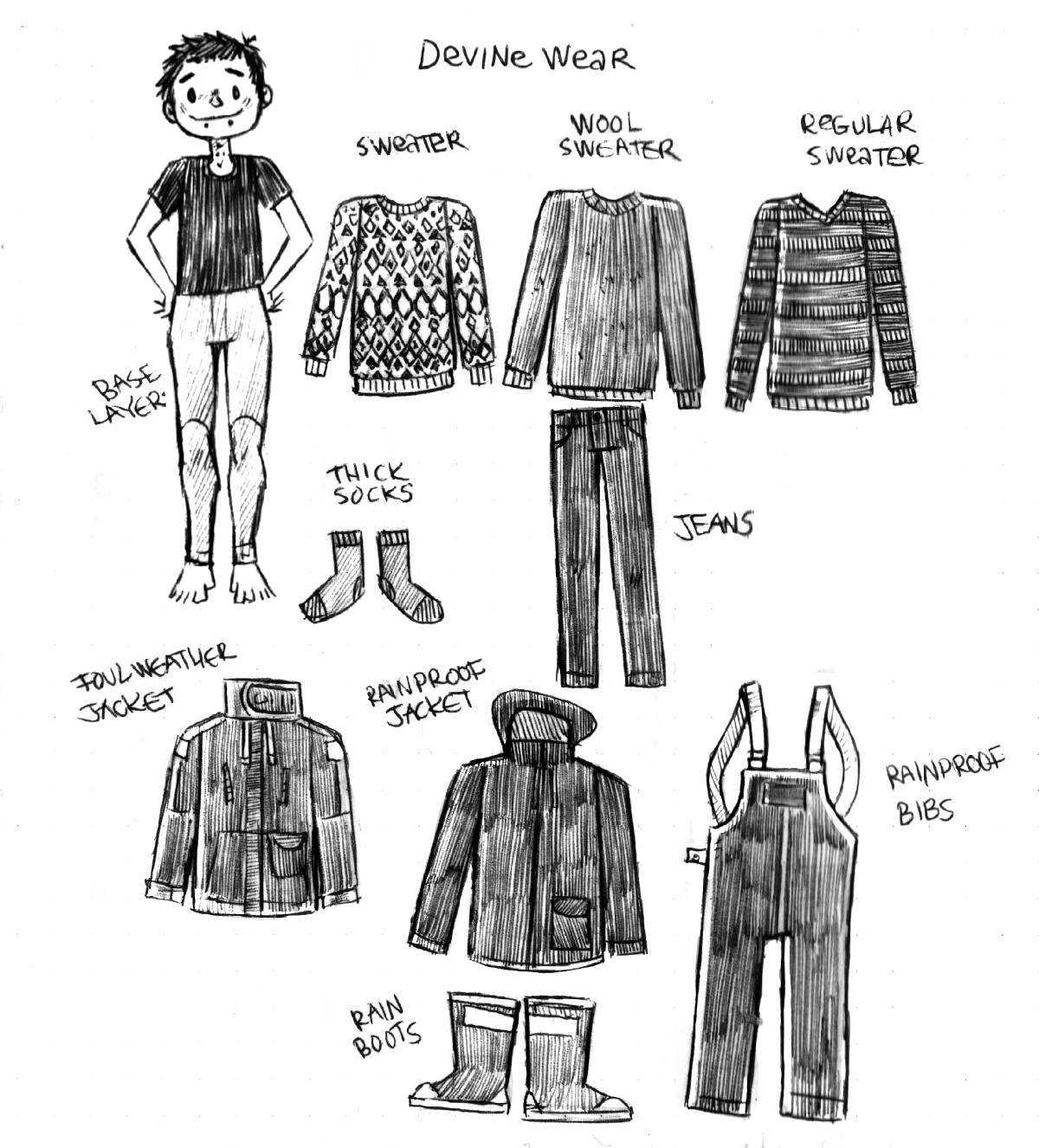 |
|
| Devine prepared ramen for lunch. "You want to take turns eating inside?" They asked me, it was still raining hard then. "Nah, just give it to me here. Ramen is wet, it can get more wet." The warm ramen broth helped to warm my cold insides. "Ikikatta!" Yes, back to life! As mentioned before, our hands are always cold, we haven't solved that problem yet. Any glove we own gets instantly wet as soon as we start to handle ropes, we always have to adjust the jib or main sheet, we can't avoid it. The gloves imbibed all of the water that had been weighing down our lines, a transaction that we would gladly do away with. |
|
| I handed the tiller to Devine when near the turn for our anchorage. Bone Anchorage, while protected, was 5 NM inland. We had no other options, so we pushed on. The rain had stopped for a while, but came back as we began to motor down Racey Inlet, the wetness stayed with us for the entire way, except now, we had it in the face rather then in the back. Downwind, the rain hit our backs and wasn't bothersome, but now, it was soaking Devine's front. "UGH!" I ugh'ed back in agreement. The rain fell very hard at times. I was partially hidden behind our mini dodger, navigating from there, my spot was a haven in comparison to Devine's exposed location. I offered to take turns. To make matters worse, there as a bit of current against us in the inlet, slowing our progress, prolonging our time in the rain. The time to our destination felt like it stayed at 52 minutes for 3 hours, in reality, it took us a bit over an hour to arrive, but it felt like more in those conditions. When we create waypoints on our chartplotter, we can see the time left to our destination based on our current speed. It is sometimes reassuring to see the time we have left, but today, it was driving us mad. |
|
| We pushed deeper and deeper, the inlet narrowed and narrowed, until we reached Bone Anchorage. Yes! Finally! There were a few rocks to dodge, but it was nothing when compared to what we had to deal with in Higgins Passage. We found the source of the opposing current ahead, a stream of water, we could hear the sound of water rushing. We passed a crab trap float, and could see the pull the water had on it, this is what we were up against. Even at anchor, the current kept our rope rode taut. | |
| Another beautiful quiet place, but no time to enjoy it, because it's raining again, but also because we have to catch more south winds tomorrow. This is unlike the type of sailing we generally do in these waters, where we stay for weeks at a time in the same anchorage. I prepared coconut curry with some basmati rice for dinner, while Devine warmed up by the fire. We arrived to Bone Anchorage earlier than we thought, the wind helped to push us north fast, but the rain was an unwelcomed companion. The plants in the area were enjoying it, this place was incredibly lush. While the Salish Sea experiences water shortages in the high summer, this place must never experience this kind of thirst. |
|
| We had 1/2 tank of diesel left in our main tank, but it was raining so much that it was hard to find time to fill it. We still had 3x20L Jerry cans left. Tomorrow, we are aiming for Patterson Inlet, we don't think we can get to Petrel Channel in one leap, it's too far, we know our limits, and I think more rain is on the way tomorrow... | |
| May 27th | Bone Anchorage to Patterson Inlet Up at 0600, gone at 0620. We don't have VHF reception in Bone Anchorage, so we are assuming that the weather out there has stayed the same. We bought some minutes for our SAT phone for such times, but we weren't going to get a signal out here, in a place tucked between tall mountains. I tried anyway, but noticed that the app that we use to visualize GRIB files was uninstalled on our little ipad — how did this happen? We didn't do this. We learned that Apple thinks its doing us a favor by uninstalling apps — without our consent — that we haven't used in a while, to save on storage space. I really do not like technology making decisions for me. We will only have internet access in Prince Rupert to re-install this app. Fuck you Apple, for removing apps without asking... I had no idea that automatic offloading was a thing, we have since disabled it. |
| We picked up some VHF signal once out of Racey Inlet. Today called for 15-25 kn winds out of the south, ideal weather propel us through Principe Channel. It also seemed that the south winds will stay tomorrow! | |
| The rain these days was incessant, we got a few good downpours already and it was only 1030. We saw other boats on AIS, namely the passenger ship Swell, a boat usually moored with us in Victoria. In the early summer, it takes guests out on long trips. We ran into it in Port McNeill, today it appeared to be heading into Kittimat. | |
| Both Estevan and Principe Channel offered protection from weather and swell, but it was still hellish out there. The squall clouds were enormous, they spewed out tropical-style amounts of rain while accelerating the wind in the area. One particular squall scared me. The wind whistled in the rigging as it approached us from the stern. Lacking a wind meter, we cannot know the exact wind speed, but we could tell it was strong by listening. The following waves were impressive, pushing at our rear, the sky was dark too, making the scene all the more ominous. I had an anxiety attack, maybe it was fatigue, but more likely it was the fear of big waves. Ever since one threw me overboard I felt nervous when a high wave approached our boat. If it sounded big but wasn't, it still had the power to frighten me. I wasn't sure if this fear would persist, we hadn't seen proper ocean swells since the summer of 2020. I might not have reacted this way if I had been tethered to the boat, I wasn't. The tether was what kept me attached the boat that last time. I should have had it on me already. Anyhow, Devine, kind and sweet and infinitely supportive, rushed out to steer as the squall passed. It gave me time to compose myself, the fear was still there, but the shock subsided. Devine endured another squall later for me. Solid gold Devine. |
|
| We arrived near the mouth of Patterson Inlet around 1600, that last squall propelled us at 8 kn, towards the entrance. Pino steers fine in that, but the motion was unsettling. It took us a while to find a place suitable for lowering the mainsail, the wind was coming at us from too many different directions. The narrowest part of the inlet had no wind, so we doused it there. My hands were frozen when we arrived near the anchorage, they were red and sensitive. Reaching under the folded mainsail to secure it with a sail tie hurt like hell. I slipped my anchoring gloves on, gloves that were torn, salty, cold, wet and reeking of various sea things. I really need to replace these gloves. I was fine using them in the Salish Sea, but it was struggle in colder waters, as was heaving chain hand-over-hand. Holding metal that had been soaking in cool waters all night wasn't pleasant. |
|
| Speaking of cold hands, arriving in Patterson Inlet, I let down the anchor & chain in 12 m (42 ft HW) of water. Here, the tides were 6 m (20 ft), something we had to consider when choosing a spot. Like all places on this coast, Patterson Inlet was quiet, green and surrounded by mountains and wildlife. We always heard the sound of rushing water, from a fast-flowing river, or waterfall nearby. But as always, the cold and wetness had worn us out. In Quebec, we say "avoir les deux yeux dans l'même trou," to say that we are very tired, it translates to "having two eyes in the same hole." That was the best way to describe how we felt when we arrived. |
|
| We had sailed 55 NM today, a big leap, with many more leaps ahead. Tomorrow's jump will be shorter through. Like Bone Anchorage, this place had no VHF reception. We were now 64 NM away from Prince Rupert, we were getting close! We were also halfway up the length of Haida Gwai, and island we've been studying on charts for the past 5 years. It always seemed so far, so inaccessible, but now it was right there, we'd never been so close. |
|
| Week 5 | |
| May 28th | Patterson Inlet to Captain Cove The tides determine when we can move. Sometimes, this fact of life is annoying, other times it is appreciated because it forces us to leave later. "Oh no no no, we're not sleeping in because we're lazy, it's the tides!" We had oatmeal and coffee by the fire. The boat was very damp this morning, the thermometer was reading 10°C today. Getting out of bed to face the cold wasn't easy, we wore our lingering bed warmth like armor. |
We had a peaceful night at Patterson Inlet, sleeping to the sound of waterfalls and the occasional pattering of rain. The inlet was calm calm when we left, we even had a bit of sun! The brightness of the day and the still waters created a perfect inverted reflection of the rocks and trees bordering the channel. This inversion gave the impression that the land continued, that we could see its underside, like it was floating in space. Looking around I felt nauseous, ungrounded, the world had stopped making sense, up was down, and our boat was flying.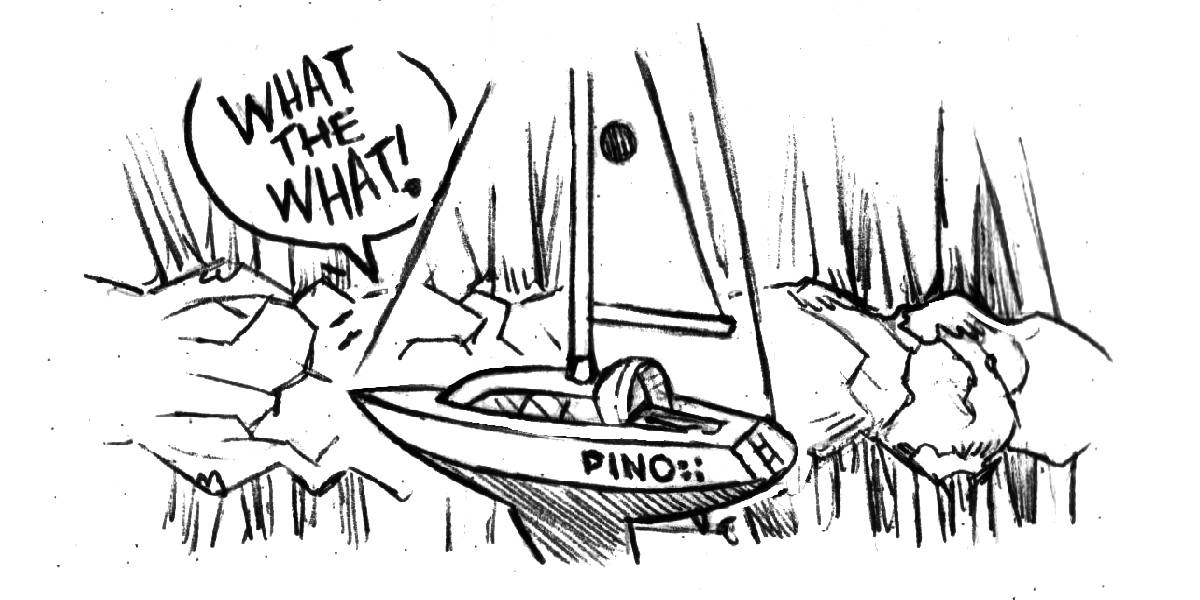 |
|
| We rode a 10-20 kn southwest wind into Petrel Channel, we had expected it to die out, but squalls trailing astern of us propelled us on. The squalls pushed us past our backup anchorage. The channel was so protected that there were no waves, this paired with a favorable current made for very fast sailing. We sailed almost all of the way to Captain Cove, the squalls abandoned us on the last 2 NM. Our sail today had been tranquil, undemanding, we could stop and watch the many waterfalls streaming down the mountains. Binoculars in hand we searched for bears, but saw none. |
|
| We tucked under the two islets in the southwest part of Captain Cove, in 9 m (30 ft). We were once again alone at anchor. Because our day on the water was so calm, we weren't tired when we arrived at 1630. Devine lit the woodstove while I prepared pad thai for dinner. Devine usually makes lunch, while I make dinner, this arrangement suits us fine. | |
| The rain kept the buckets on deck full of water, water which I pour into the trough of the deck iron to cool the stove pipe. Unfortunately, we noticed this spring that the ring we made for the deck iron has developed cracks. The cold temperatures we experienced last winter(-15°C | 59°F one night) caused the water in the wood to freeze and to expand. We'll have to redo the ring next spring. When we make projects we sometimes get the design right the first time, but sometimes we don't. | |
| May 29th | Captain Cove to Prince Rupert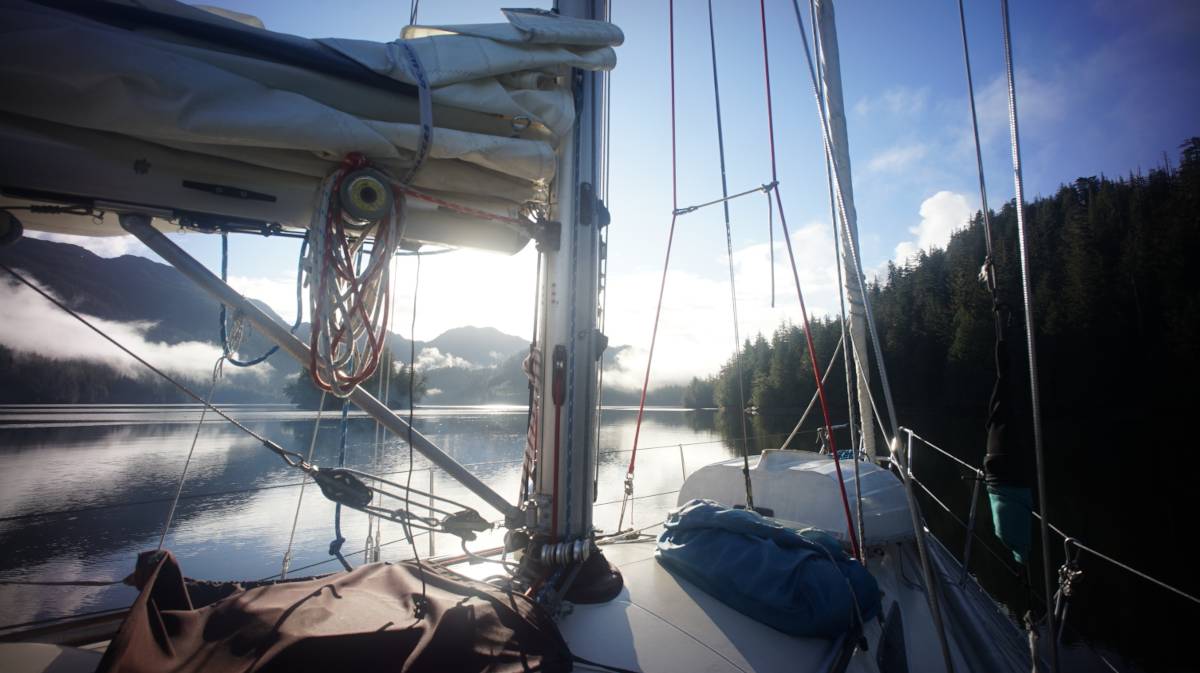 We awoke to a blue sky, a rare event! Captain Cove was especially picturesque in this kind of lighting, with low clouds clinging to every hill, mountains in the morning were not the same without them, they would appear underdressed, unfinished — really though, mountains are never finished. We awoke to a blue sky, a rare event! Captain Cove was especially picturesque in this kind of lighting, with low clouds clinging to every hill, mountains in the morning were not the same without them, they would appear underdressed, unfinished — really though, mountains are never finished. |
| Lacking VHF reception, we left the anchorage not knowing what the wind was doing out there. The mountains kept the weather reports to themselves. Luckily, the wind was weak that day, 5-15 kts out of the SE, closer to the 5 than to the 15. | |
We had trouble progressing through Odgen Channel, the current was supposed to flood, but it was fighting us. Our speed was 2.9-3.1 kts. "Did I read the tides wrong?" I hadn't. I later learned that at this time of the year, it was common for snowmelt to flow down this channel, resulting in the current never reversing entirely — maybe that's what it was. We pushed on.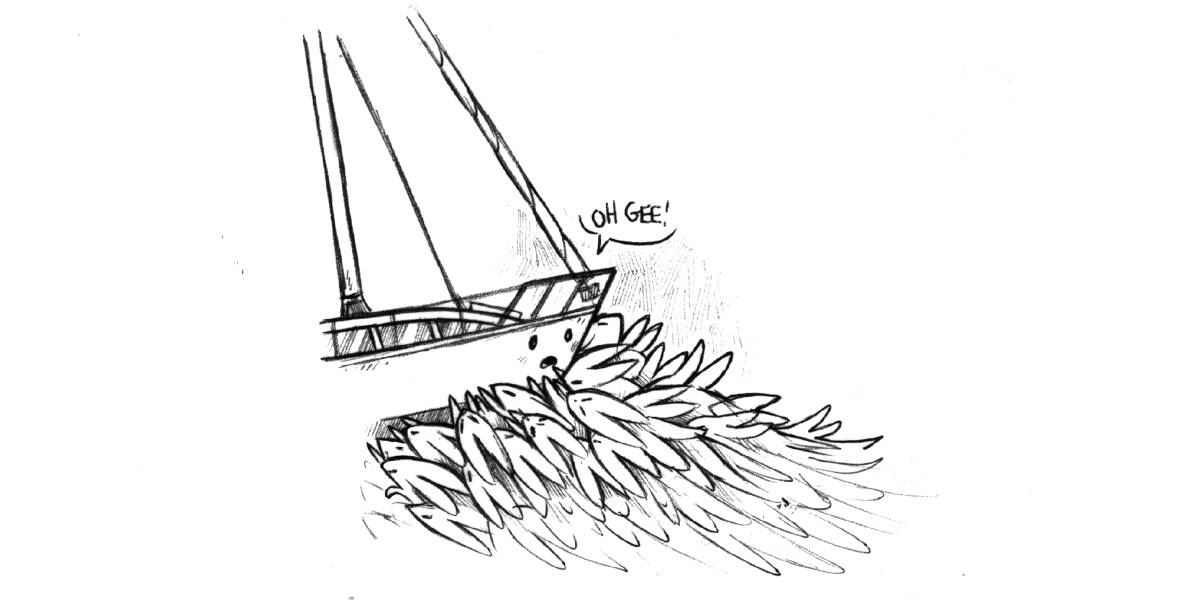 Once in Arthur Passage, the current released us, we began to feel its pull, adding to our speed. Entering Arthur Passage meant the return of cell and VHF reception again! We tried to secure a spot at a dock in town, but got no answer from either Cow Bay Marina or the Prince Rupert Yacht Club(PRRYC). Once in Arthur Passage, the current released us, we began to feel its pull, adding to our speed. Entering Arthur Passage meant the return of cell and VHF reception again! We tried to secure a spot at a dock in town, but got no answer from either Cow Bay Marina or the Prince Rupert Yacht Club(PRRYC). |
|
Later, the PRRYC returned our messages and informed us that they had room on their docks. "That's one thing off ours mind!" I said, now, we could focus on getting ourselves into port. We wanted to dock to refill our water tanks, the only anchorage in the area was too far from the main city.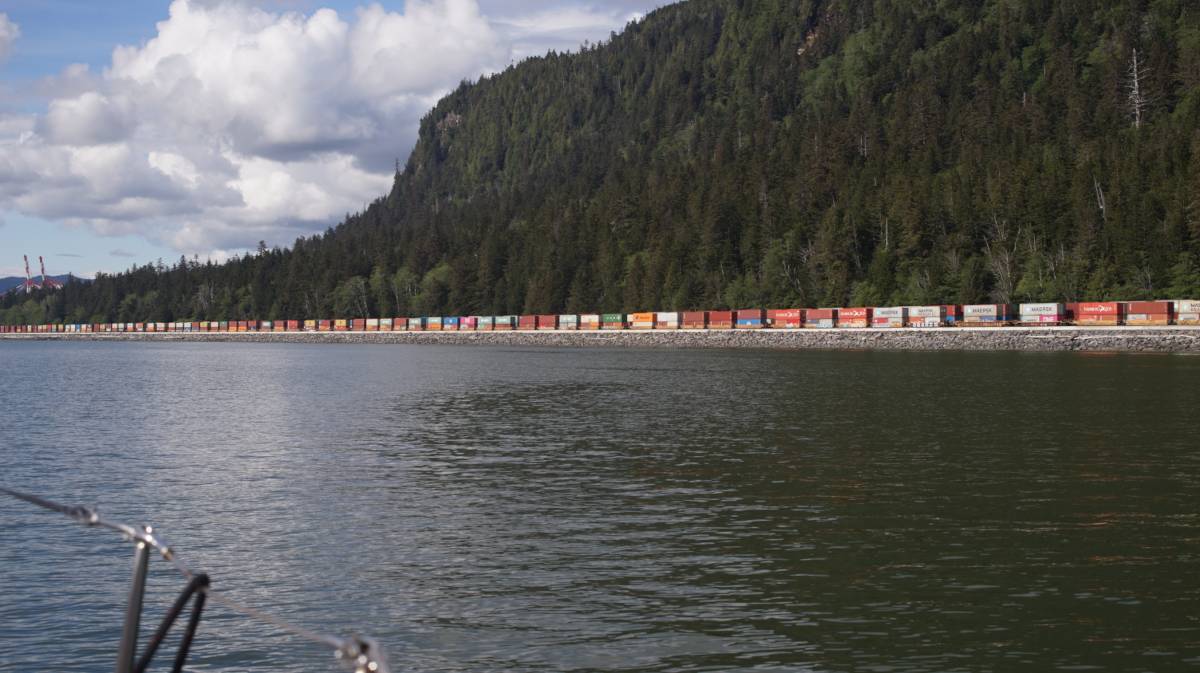 When near the entrance, we saw blocks of color ashore, all neatly lined up on the north side of the channel, bending with the land, as far as we could see. The blocks of color were shipping containers, stacked onto trains leading to a container terminal near the city. A ship was at the dock, while gigantic cranes lifted the cargo aboard. "It is crazy to think that humans have built this. We can move incredibly heavy objects around, like ants, but with mechanical appendages." When near the entrance, we saw blocks of color ashore, all neatly lined up on the north side of the channel, bending with the land, as far as we could see. The blocks of color were shipping containers, stacked onto trains leading to a container terminal near the city. A ship was at the dock, while gigantic cranes lifted the cargo aboard. "It is crazy to think that humans have built this. We can move incredibly heavy objects around, like ants, but with mechanical appendages."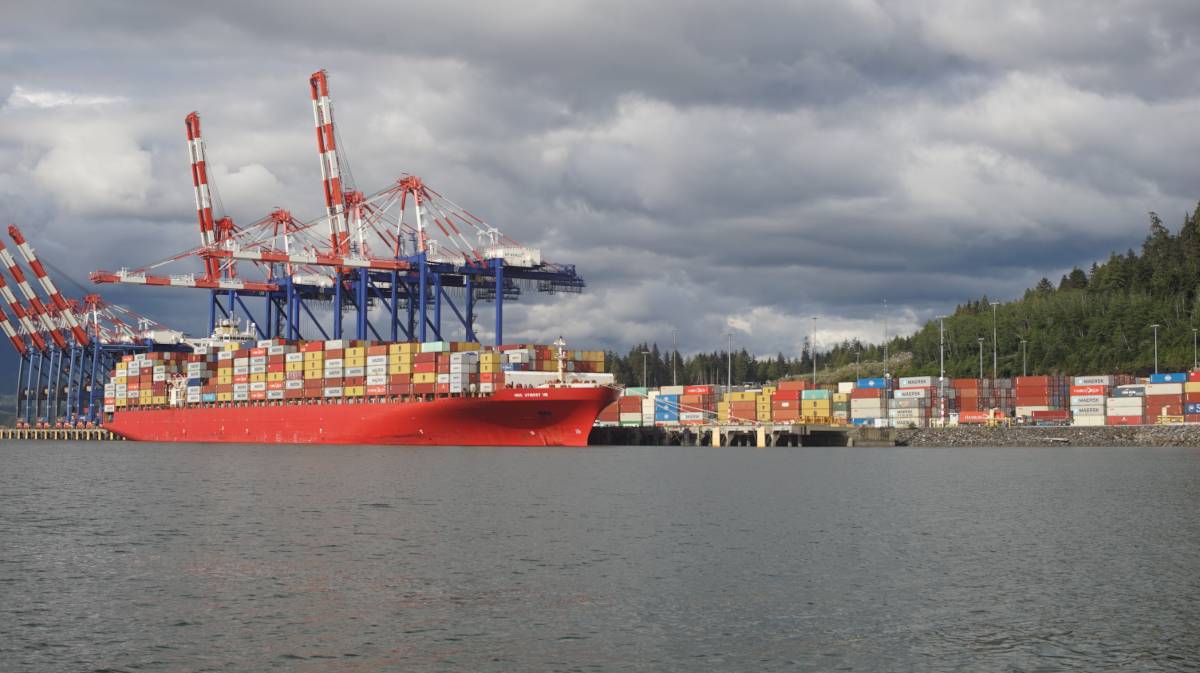 |
|
| At 1830, as we neared the PRRYC, we saw that the harbormaster was at the dock with two helpers. They pointed to what would be our spot on the dock. We missed it because the current in the harbour was running fast, Devine turned Pino around. When nearing the dock, Devine aligned us parallel with it, then we drifted to our spot, letting the current do the work. 5 minutes after arriving and Devine had already found a place where we could eat a burger(plant-based) and fries. Priorities amirite? On the way to the restaurant, we passed a memorial for a Japanese boat named Zaru Maru, a fishing boat that had washed up ashore in Prince Rupert in 1985. The sailor died, but his boat found the shore. When Zaru Maru was recovered, local artisans decided to restore it and to put it on display as a memorial for mariners lost at sea. The sailor's wife was grateful for both the restoration project and the memorial, saying her husband would be glad that the ship, his pride and joy, was still around. |
|
| May 30th | Prince Rupert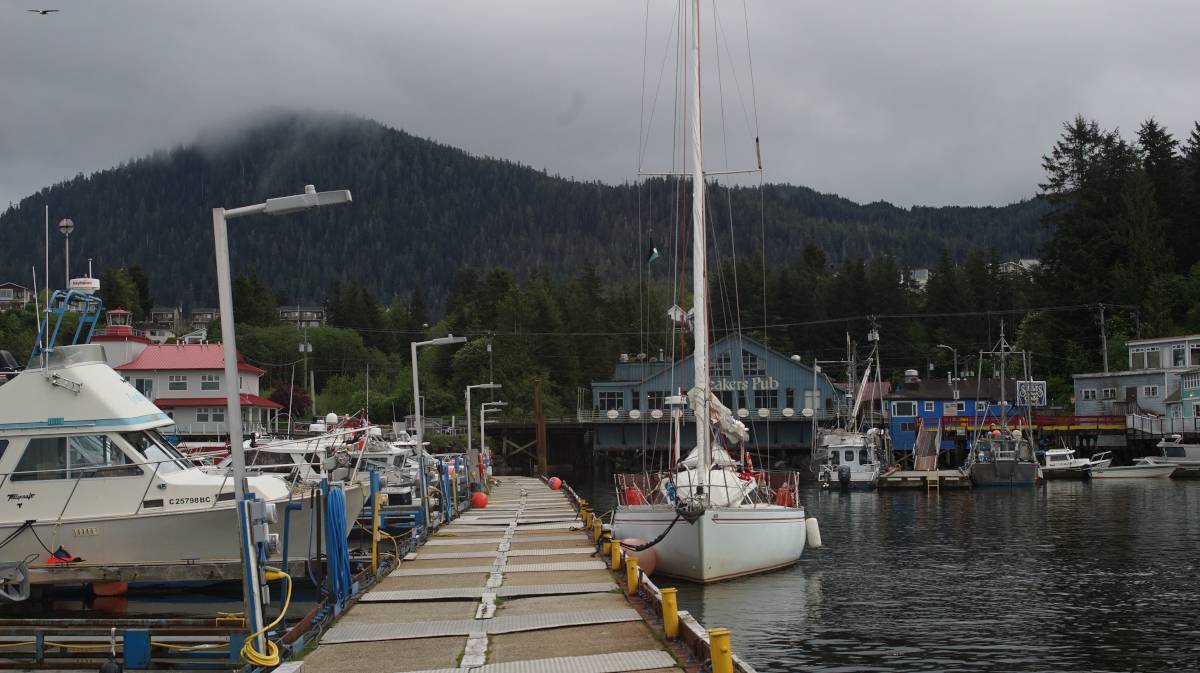 We got up at 0730, prepared pancakes to celebrate our arrival to Prince Rupert, and had coffee in the warmth and comfort of our home. We were hooked to shore power for the first time since leaving Victoria, we put our electric room heater and induction plate to work. We got up at 0730, prepared pancakes to celebrate our arrival to Prince Rupert, and had coffee in the warmth and comfort of our home. We were hooked to shore power for the first time since leaving Victoria, we put our electric room heater and induction plate to work.Later that day, a fellow mariner came by and handed us 3 bags full of produce. "We have too much! We're going to Alaska, we're not sure they'll let us take this stuff in." We were going to Alaska too, but took everything, we'll get through what we can. For some obscure reason we inherit a lot of produce from other sailors. |
| After completing some errands in town, we spent the rest of the day relaxing aboard Pino, enjoying our day off from sailing. | |
| May 31st | Prince Rupert We filled 2x20L bins with diesel next door, borrowing the yacht club's wheelbarrow to ferry them to and back. The ramp to get to the gas dock was steep, the wheelbarrow had to wait at the top. We ought to have checked the state of the tide when choosing a time to fill the bins, we had a hard time walking them back up. When paying the bill, the clerk at the desk had us fill a form to confirm that we weren't going to put this fuel into a locomotive engine, "wouldn't dream of it." |
| SY Moonshine arrived in Prince Rupert later that day, they circled around the harbour for a while, trying to find a place where they could dock. They eventually found room in Cow Bay Marina, on their breakwater float, a small fishing boat had moved to allow them to dock — a good thing because they had told us in an email that they had engine issues, they weren't sure if it would start again if they switched it off. Devine went to see them while I filled the water in our tank. It was raining hard, we couldn't leave the companionway door open for too long at the risk of flooding the cabin. Devine returned with Viktor and Caroline, and Luc — a boater, and friend of theirs. We had a nice evening together, Prince Rupert was as north as Moonshine would go this year, and Luc had plans to continue to Southeast Alaska, like us! |
|
| When they left, we began to mediate a peace accord between our Iridium SAT phone and our ancient Apple devices — they're not talking yet. We were leaving for Southeast Alaska tomorrow at 0700. A gale was on the way, we were aiming to stay ahead of it. |
|
| June 1st | Prince Rupert to Foggy Bay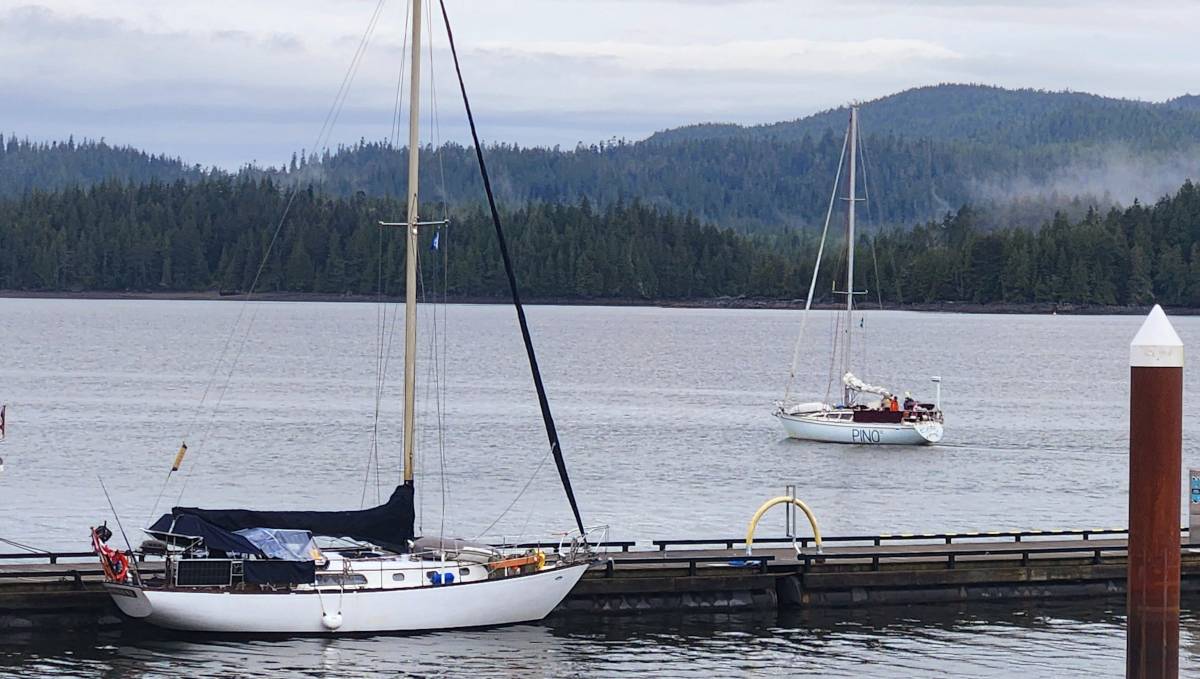 We left Prince Rupert at 0700, aiming for Foggy Bay. We raised Pino's main in the harbor, then motored towards Metlakatla Pass, a narrow fairway with many shallows, seaweed, current, and unreliable channel markers. Passages like these are always less intimidating than guide books make them out to be, but the writers are clever to exaggerate the dangers, their warnings in mind, we proceeded cautiously, with one eye on the water and the other on the depth sounder. In the past, tug boats had accidentally dragged some of the channel markers out of place, making it difficult to trust their position. Today, the markers were in alignment with their charted positions on both Navionics and our chartplotter. The current only added to our speed when passing through the narrowest section, the rest was smooth smooth, the only annoyance was the presence of biting midges. We disturbed the quiet with our constant hand clapping. When exiting the pass, once we were clear of all the channel markers, we pointed our bow to the northernmost tip of Dundas Island. We left Prince Rupert at 0700, aiming for Foggy Bay. We raised Pino's main in the harbor, then motored towards Metlakatla Pass, a narrow fairway with many shallows, seaweed, current, and unreliable channel markers. Passages like these are always less intimidating than guide books make them out to be, but the writers are clever to exaggerate the dangers, their warnings in mind, we proceeded cautiously, with one eye on the water and the other on the depth sounder. In the past, tug boats had accidentally dragged some of the channel markers out of place, making it difficult to trust their position. Today, the markers were in alignment with their charted positions on both Navionics and our chartplotter. The current only added to our speed when passing through the narrowest section, the rest was smooth smooth, the only annoyance was the presence of biting midges. We disturbed the quiet with our constant hand clapping. When exiting the pass, once we were clear of all the channel markers, we pointed our bow to the northernmost tip of Dundas Island. |
| The wind was not strong enough to give us a worthwhile push, so we motorsailed for a while. Later, the wind returned and stayed, permitting us to shut the noise machine, but we had to keep it on once we cleared Dundas Island, there was no wind there and we had long ocean swells to deal with. The way to Cape Fox was long, the stretch to Foggy Bay... even more so. Devine brewed up some tea and coffee(for me) to keep us from nodding off at the helm. Motoring was very, very boring, and unchallenging. The caffeinated beverages did help for a while, but the relentless head-nodding returned, the only reliable remedy was a nap. Once we arrived at the invisible border separating US waters from Canadian waters, we switched our chartplotter card. Friends on the Victoria docks had lent us their chart card for Southeast Alaska. |
|
We thought we would get soaked today, but the storm clouds never approached us, and once halfway across Dixon Entrance the sun dominated the skies. We saw no new wildlife, but the water and shores were always full of gulls, a gull on every rock. Everytime we looked ashore for a glimpse of something alive, something new, there was always just gulls. Gulls abound. We still haven't seen a bear, maybe the gulls have agreed to act as stand-ins. The gull syndicate is strong on this coast.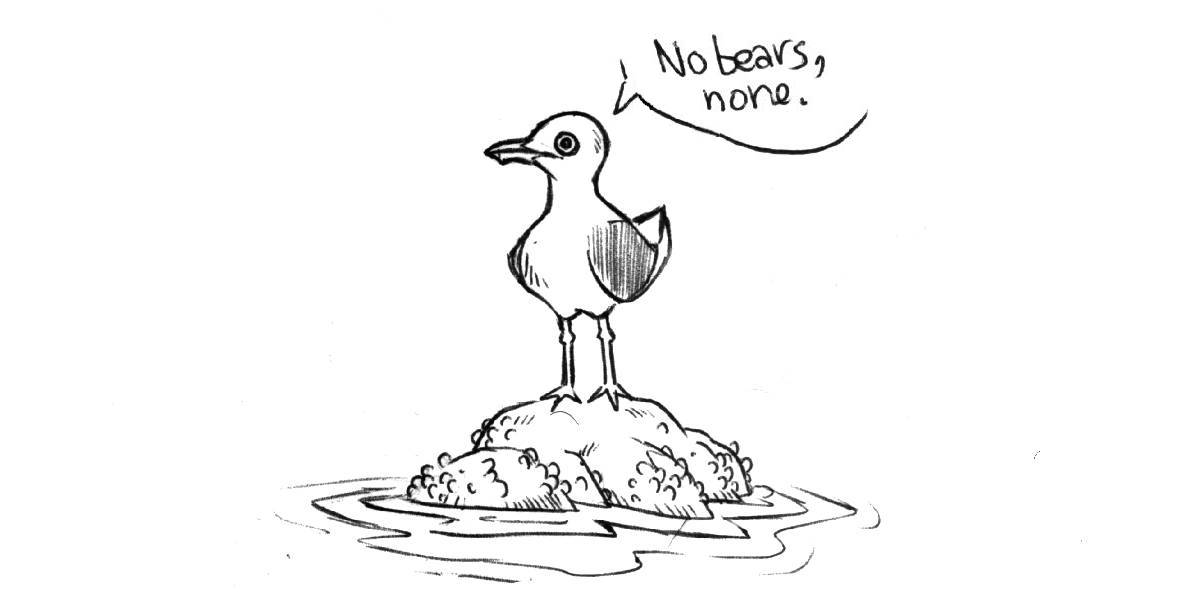 We turned into the outer waters of Foggy Bay, then slipped into the inner cove, avoiding obstacles in the entrance channel. When inside, we saw that one other boat lay at anchor here, the same one we had seen in Prince Rupert that had given us their produce. We turned into the outer waters of Foggy Bay, then slipped into the inner cove, avoiding obstacles in the entrance channel. When inside, we saw that one other boat lay at anchor here, the same one we had seen in Prince Rupert that had given us their produce.We anchored in 8 m (26 ft), adding extra rode for the additional 3 m(10 ft) of tide we were expecting. Then, we ducked inside to prepare food, we were both starving. |
|
| Since we had no yet cleared customs, Devine raised our Q flag. We had called US customs officials on the phone when leaving Prince Rupert to ask for permission to stop in Foggy Bay for the night before going to Ketchikan. Stopping in Foggy Bay was a good option for slower boats, like ours. The wind was supposed to pick up tonight, and to rise even higher tomorrow morning. A problem for tomorrow. | |
| June 2nd | Foggy Bay to Ketchikan We had zero weather while anchored in Foggy Bay. The 30-40 kn winds did not reach us. We left at 0700, expecting a breeze to help us to Ketchikan, but it was too weak. "Methinks I see the wind!" I would say, spotting ripples in the water ahead, but almost always it was tidelines, "no, I was mistook." The only wind we encountered was when near the mouths of the many arms lining Revillagigedo Channel, but as soon we cleared one the breeze abandoned us once again. The only boats on the water were small runabouts, fishing boats, or large passenger ships. We assumed that the southeast winds forecast in Clarence Strait meant wind in this channel too, we had fewer miles to travel today, but a day of motoring was a brain killer. There was no elegance in it. We were grateful that Calcifer II was cooperating, infinitely grateful, but it was a chore. |
| The horizon was grey, thick clouds obscured the tops of mountains, the rain fell and fell, there was no break in it. We saw orcas in the water from afar, their long straight black fins were easy to discern against the pale, hazy scenery. | |
| Devine prepared ramen for lunch, I inhaled my portion while steering in the rain. Eating comforting foods helped to make the transit more pleasant. The closer we got to Tongass Narrows, the busier it was. We passed many small tour boats, two of them waited for us to sail past, tourists aboard took photos of us under sail, propelled by good wind blowing out of Carrol Inlet. "Typical that we only ever get the best wind at the end of our trip..." Devine said. We began to see homes on the shore, buried in green foliage — so much green! |
|
Once in Ketchikan we chose to go to Bar Harbor, the marina furthest from the downtown area. Following the instructions of the harbormaster, we pulled into our assigned slip in the north basin.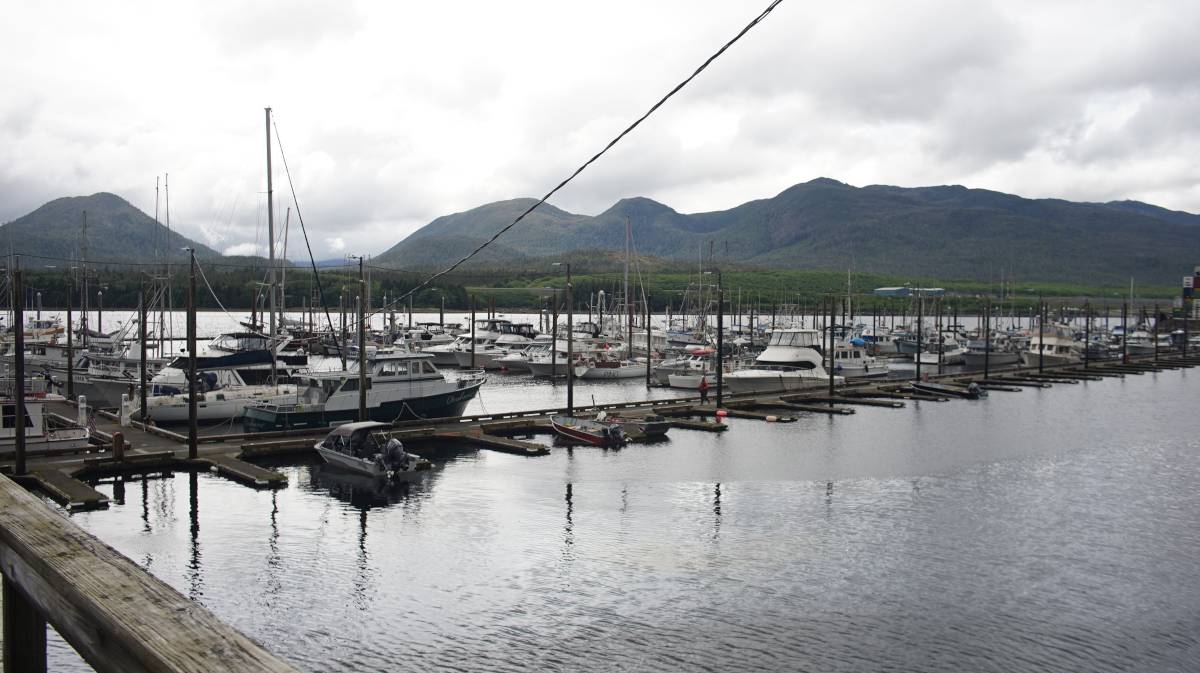 On arrival, we had to report our arrival to the CBP by phone, we had purchased a data/voice plan for our dumb phone, we had data, but couldn't make calls. We knew we could report our arrival via an app(Roam), but again, our hardware was at fault, no device we owned could support it. The only way to tell them that we'd arrived was to step off the boat and to find a phone. We walked to the harbormaster's office, explained our situation and made the call. The CBP requested that we walk to their office downtown to finish the check-in process, a 45-minute walk away. The harbormaster was heading home for the day, she graciously offered to drop us off at the Federal building. On arrival, we had to report our arrival to the CBP by phone, we had purchased a data/voice plan for our dumb phone, we had data, but couldn't make calls. We knew we could report our arrival via an app(Roam), but again, our hardware was at fault, no device we owned could support it. The only way to tell them that we'd arrived was to step off the boat and to find a phone. We walked to the harbormaster's office, explained our situation and made the call. The CBP requested that we walk to their office downtown to finish the check-in process, a 45-minute walk away. The harbormaster was heading home for the day, she graciously offered to drop us off at the Federal building.The federal building was salmon-colored, nested at the heart of downtown Ketchikan. Checking in was painless, the officer did not ask about fruit or vegetables onboard, in fact, they weren't going to come aboard at all. Books we had read warned us that the Ketchikan CBP would always board visitors on arrival, maybe they didn't want to come to the boat because of how late it was. They also didn't care that we didn't use the app, "our phone is too dumb, and our other devices are too old," we said. "I don't like having a computer in my pocket, so good for you!" one of the customs officers said to us. 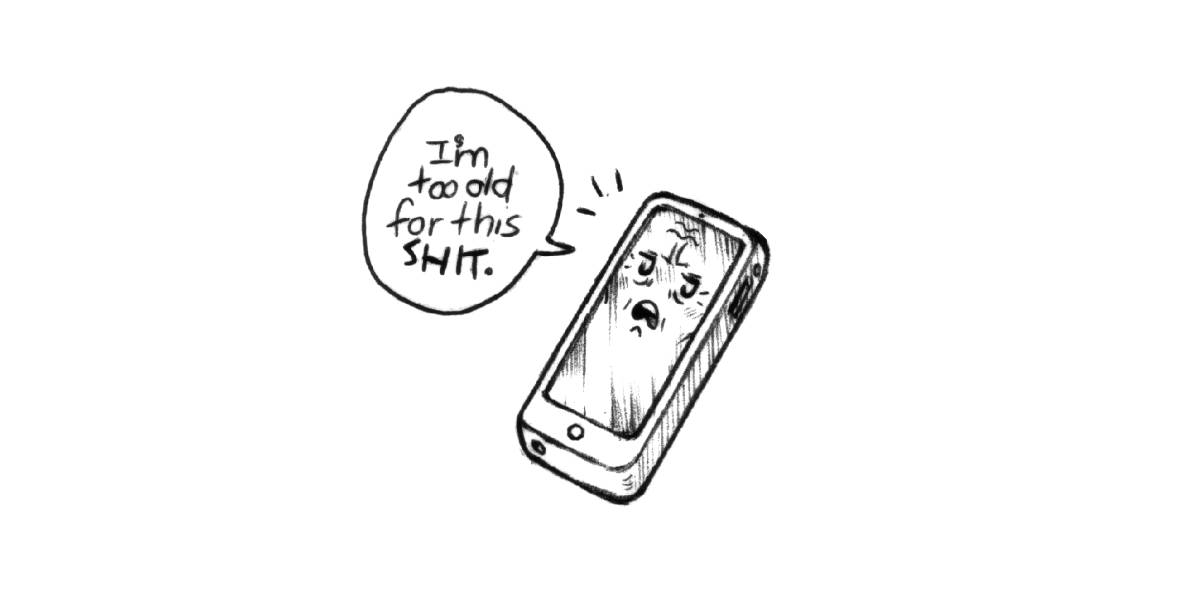 |
|
We walked back to the boat, getting a good look at downtown Ketchikan all the while. There were a few neat looking shops, but most of them were there for the tourists. We must have seen 6 diamond shops. Thomas Basin and Casey Moran, two moorage options for transient boaters, lie in the shadow of the cruiseships, 2 were docked when we arrived. Our spot in town was far away, yes, but there were no cruiseships there, only working and cruising boats. We thought about stopping somewhere for drinks, but by then we were both tired and hungry.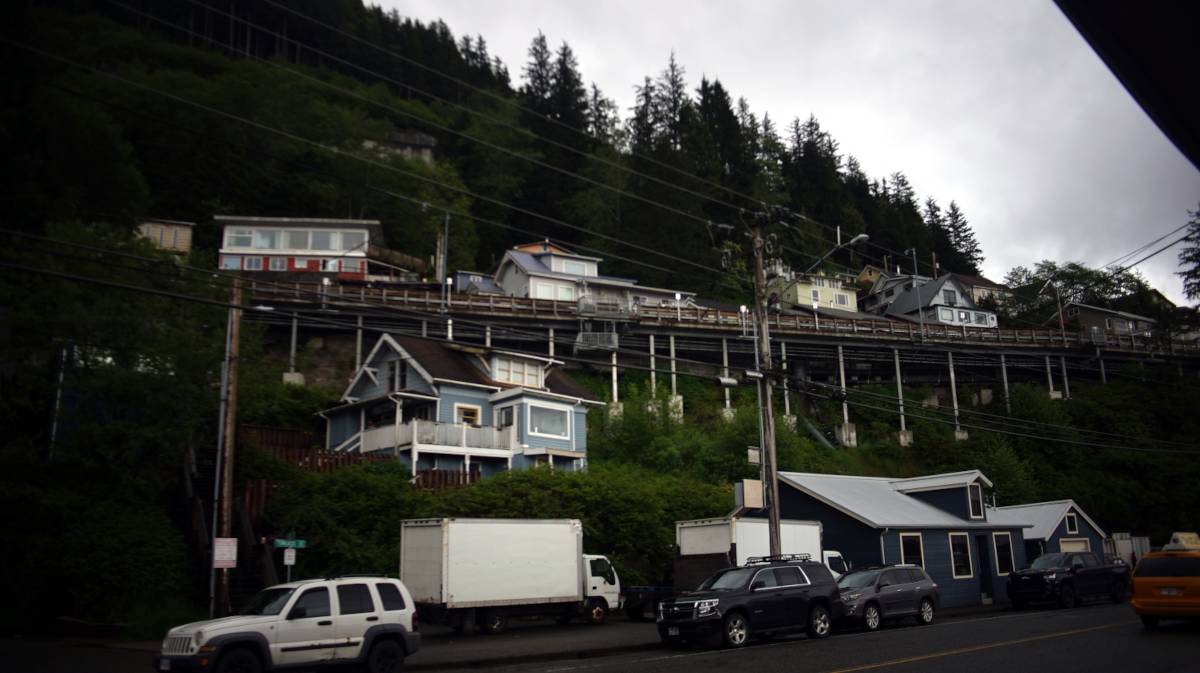 The houses bordering the main road were all perched up high on the cliff slide, with very long wooden staircases leading up to them, with other horizontal walkways connecting the houses together. We loved the idea of a shared stairway. The houses bordering the main road were all perched up high on the cliff slide, with very long wooden staircases leading up to them, with other horizontal walkways connecting the houses together. We loved the idea of a shared stairway. |
|
| We arrived back on Pino at 1845, had a drink, ate some left-over chili, and exchanged our Q flag for an American courtesy flag. Our stay in this beautiful region had begun, a place where bald eagles were as common as gulls(gull syndicate has competition here). | |
| June 3rd | Ketchikan Today, we wandered through town to explore, but the cruiseship passengers had filled every worthwhile place. We thought of having a drink at a bar recommended by the harbormaster, but it too was over capacity. We returned home by way of the elevated back streets, a better route than the one bordering the busy main road. We shared a Guiness zero on Pino. |
| The wind picked up after dinner, blowing at a steady 35 kn. It screamed all night. | |
| Week 6 | |
| June 4th | Ketchikan Another blustery day greets Pino and crew today. We stayed at the dock longer than planned to wait for it to calm down out there. The wind sounded like it was stronger than 35 kn, the boat heeled, pulling on its tethers, and the rain was constant and heavy. We noticed today that water was making its way past the glassed wooden ring on deck for the woodstove. Devine went outside and squirted Life-Calk into all of the visible cracks(it cures even when wet). Unfortunately the Life-Calk we had was a nasty brown color, it appeared as though we had permanent mud stains on deck. |
I braved the heavy rain and strong winds to go to the grocery store. I was wearing my waterproof jacket and boots, but I ought to have worn my waterproof bibs too, the pants I was wearing soaked up all of the rain. 5 minutes out there and it was like wearing clingwrap. When I removed my hood in the store, the wetness still clinging to it cascaded down my shoulders before accumulating into a big puddle at my feet. As I progressed through the aisles, rivers formed at my heels.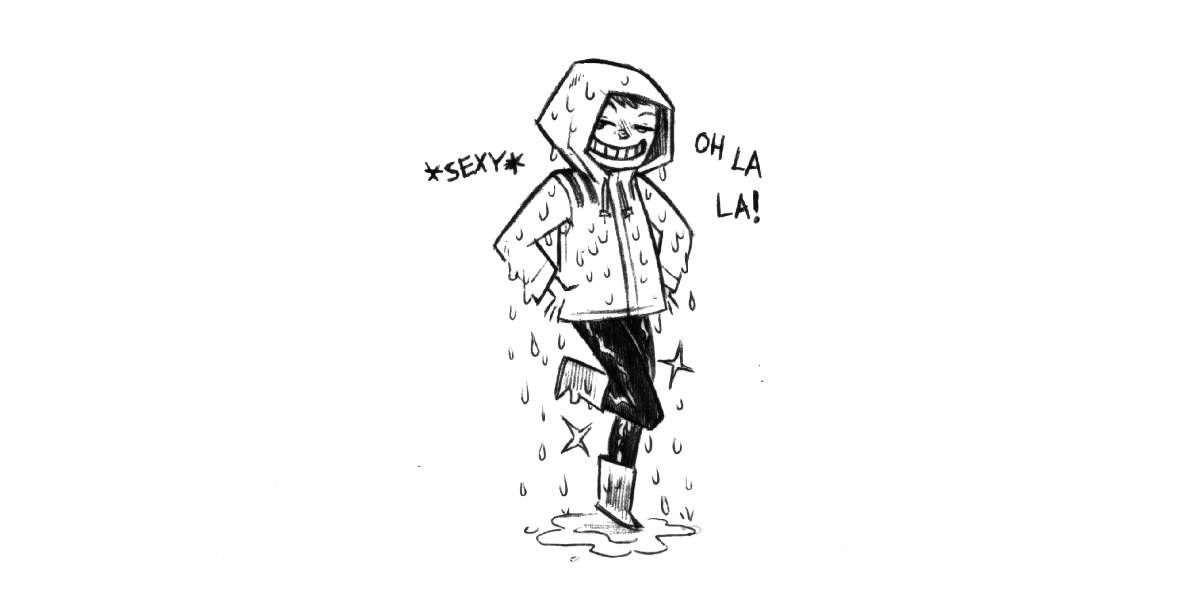 On the walk back home, my backside, that had so far been spared because of the orientation of the wind, now too got a thorough wettening. My wet look was now complete. On the walk back home, my backside, that had so far been spared because of the orientation of the wind, now too got a thorough wettening. My wet look was now complete. |
|
I was feeling low today, I blamed the wind and relentless heavy rain. It was June 4th, the start of warmer weather in the Salish Sea, but the gloom and cold had not left this part of the world yet. This was the sort of weather common in Victoria in late winter, "we won't have a proper summer this year," I had said to Devine when planning this trip in early winter, we knew then and we know now, but the gloom bug hit us hard all the same. The rain was too heavy, a walk outside would not be pleasant, even with rain gear on. I missed the sun, I missed solar cooking, too. This dip in mood was likely temporary, but the prospect of once again sailing in the rain tomorrow was not exciting. I missed the sun, I missed solar cooking, too. This dip in mood was likely temporary, but the prospect of once again sailing in the rain tomorrow was not exciting.An icon of Ketchikan is the rainbird, the rainbird stoically endures Ketchikan's prodigious rains. |
|
| June 5th | Ketchikan Guess what? We're still in Ketchikan! Yesterday's forecast puzzled me, the wind was still gusting in the upper 30's everywhere, but not in our weather area. "Suspicious," I said, and I was right to be. In the morning, the 20 kt winds had climbed to 25 kts with heavier gusts. It was raining heavily still, too. "Fuck it," we said, "we're staying put." The rainbird's moroseness was infectious. The weather was unstable everywhere, going out didn't seem like the best idea. 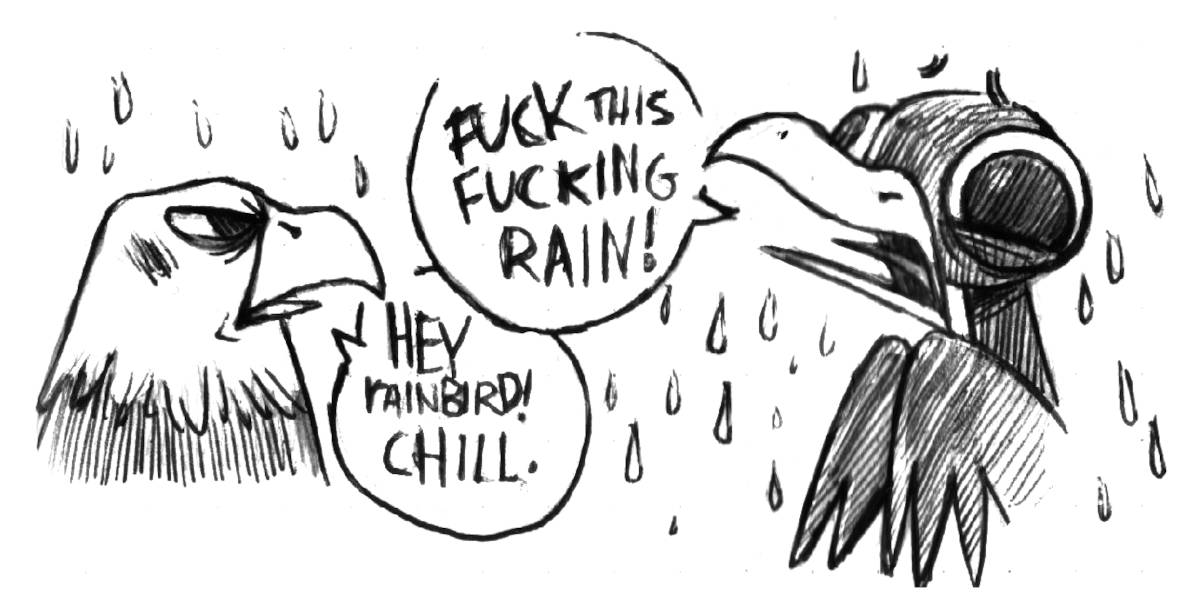 |
| We prepared cornpone for lunch, then we braved the rain to visit the hardware store to buy some compressed wood bricks for our woodstove. We purchased a box containing 8 large bricks. These won't fit into the belly of our tiny stove as is, we will have to split them. When splitting compressed wood bricks, the goal is to split them while simultaneously not allowing them to crumble to pieces. For now, we stashed them in our aft cockpit locker. We'll find a time and place to make cuts later. | |
| The rain continued all day, at around 0200 it fell so hard it woke us up. | |
| June 6th | Ketchikan to Snug Cove Departure day! The wind was 15 kts out of the southeast. There was a bit of current when backing out of our slip, but we were able to keep Pino centred and away from other boats. As we exited the Bar Harbor breakwater, we sailed at a pleasant 4 kts, then as we exited Tongass Narrows we installed the whisker pole to run wing-on-wing. As we passed the outermost island at the north exit, we spotted 2 cruise ships heading towards Ketchikan. Shit. We did our best to move out of their way, but the wind had chosen this terrible moment to abandon us — in truth, we were at fault, we had, by inattention, sailed into a wind shadow. Luckily, the two cruise ships soon turned their bow away from us. |
| As we glided deeper into Clarence Strait, the wind returned. The further we progressed, the more the waves rolling in from Dixon Strait lessened. We aimed to anchor in Snug Cove, a 35 NM sail away from Ketchikan, our cruising speed on this stretch ranged from 6.2-6.5 kts. As soon as we rounded Tolstoi Point, halfway up Prince of Wales Island's east coast, the wind vanished, and so we awoke Calcifer and motored to the entrance to Snug Cove — a place, that we hoped, would live up to its name. |
|
The narrow entrance to Snug Cove was bordered by a few reefs, but the charts appeared correct. We tucked in behind a small island and anchored in 9m (30 ft). We will likely stay here tomorrow, to wait for good wind to propel us northward to Exchange Cove.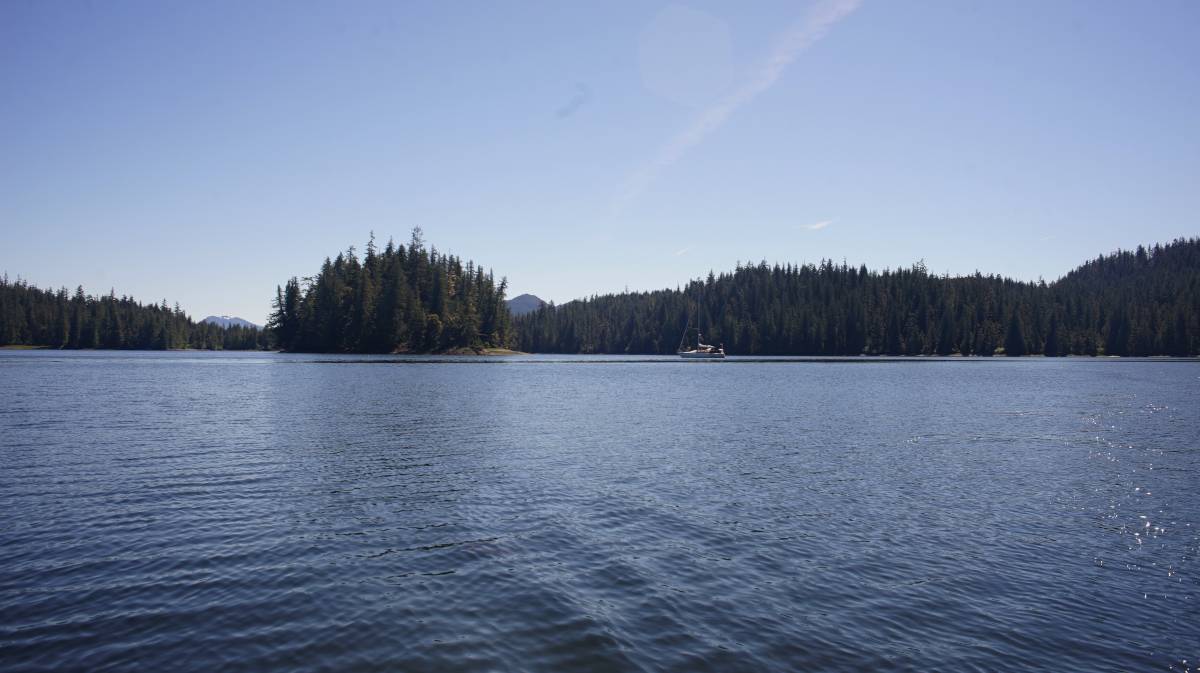 Calcifer II has performed well lately, the fuel-resistant teflon tape we applied to the threads of the bleed screw have stopped the fuel leak. I refilled the engine head with oil last night. Hopefully, our little engine will continue to do well. Calcifer II has performed well lately, the fuel-resistant teflon tape we applied to the threads of the bleed screw have stopped the fuel leak. I refilled the engine head with oil last night. Hopefully, our little engine will continue to do well. |
|
| We ate Japanese curry for dinner, topped off with some pickled turnips and beets — one of our favorite lacto-fermented vegetable combinations. We've only consumed 2 1L jars of pickled goods so far. | |
| June 7th | Snug Cove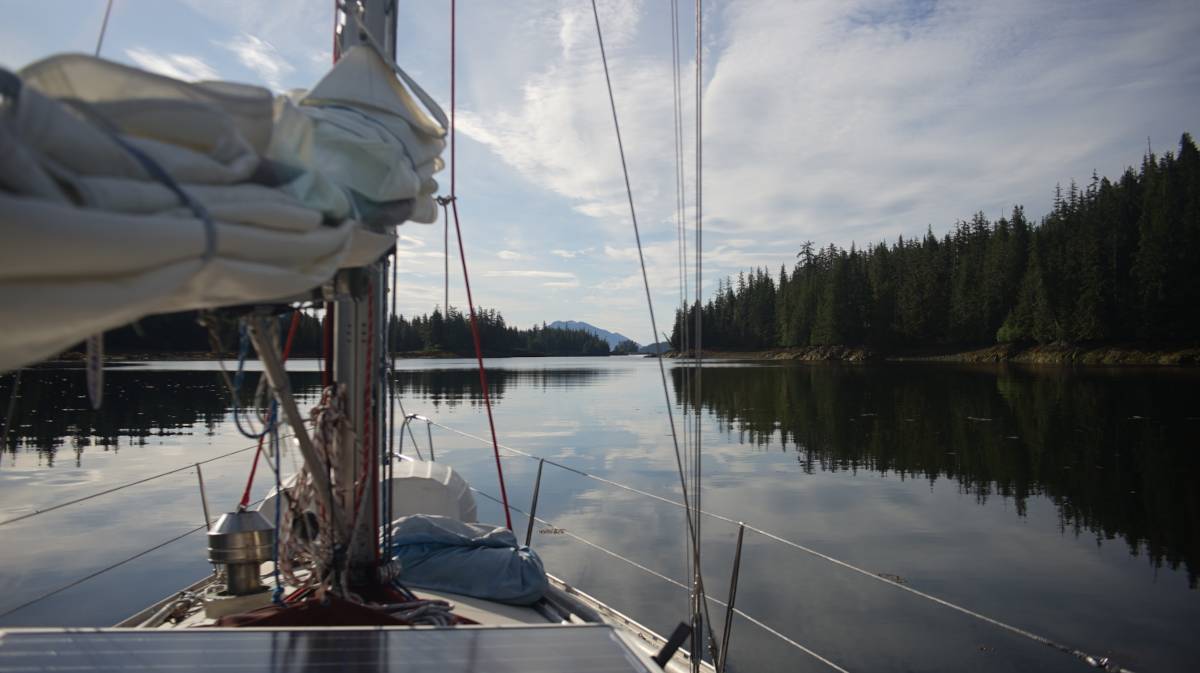 A peaceful night at anchor, Pino was snug, and so were we. The wind was down all night. A peaceful night at anchor, Pino was snug, and so were we. The wind was down all night.We often think about how much people have to pay to be allowed to just... exist. Money for shelter, for food, to spend time in nature, it never ends. On the water, we can choose to lay the anchor down almost anywhere, and that's it, we are tethered to the ocean floor with no bills to pay. We can stay as long as our supplies last, we can leave whenever, and that's a comforting thought. The well-being of a person ought not to depend on whether or not they have a full wallet, self-worth ought not to be measured by it, either. |
| We were alone in this bay, most of the bays we've stopped at have also been empty. We only had companions in Foggy Bay, Millbrook Cove and Fury Cove... and that was only ever 1 other boat. We shared anchorages with birds, mostly. | |
| I placed my cup of coffee on top of the woodstove to preserve its warmth. We were fine at night when sleeping, but the ambient temperature in the cabin was very cold. I thought that a north wind would bring some sun, but it hasn't. We think we have fixed the leak on deck, but we won't celebrate until after a good rain day confirms it. The deck iron looks awful with all of the caulking, but an ugly thing that doesn't let in water is better than a beautiful thing that does. |
|
| I spent time studying options for our path north, but all of the routes appeared difficult. This part of Southeast Alaska leads to a bottleneck with many possible routes north, each route has its particularities. One option requires backtracking and heading into Chatham Strait, another means going through Rocky Pass(a narrow, shallow, badly-charted, reef-encumbered pass with lots of current) and the last is going through Wrangell Narrows(an area with lots of traffic, current, shallows, etc). We didn't like the idea of back-tracking, and because we feared Rocky Pass was too shallow for our draft we chose Wrangell Narrows, even if it meant having to share the path with larger, faster boats. Cruise Ships are gigantic (nearly 300 m | 1000 ft long). There is really no land vehicle equivalent to a cruise ship. It is intimidating to encounter one on the water. Imagine for one second that you're driving on the road, then a giant thing on wheels suddenly arrives behind you, fast. Because it has the right of way, and that it has limited maneuverability, you have to make sure you're not in its path. 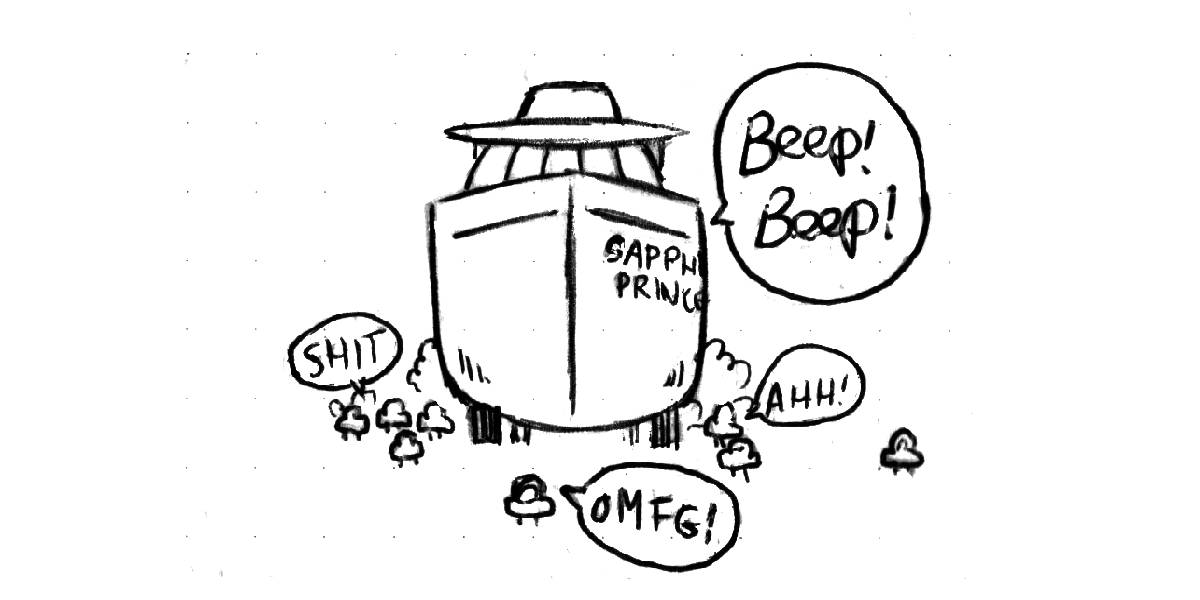 To make matters worse, these intimidating beasts always have very cutesy names, like Sapphire Princess. To make matters worse, these intimidating beasts always have very cutesy names, like Sapphire Princess.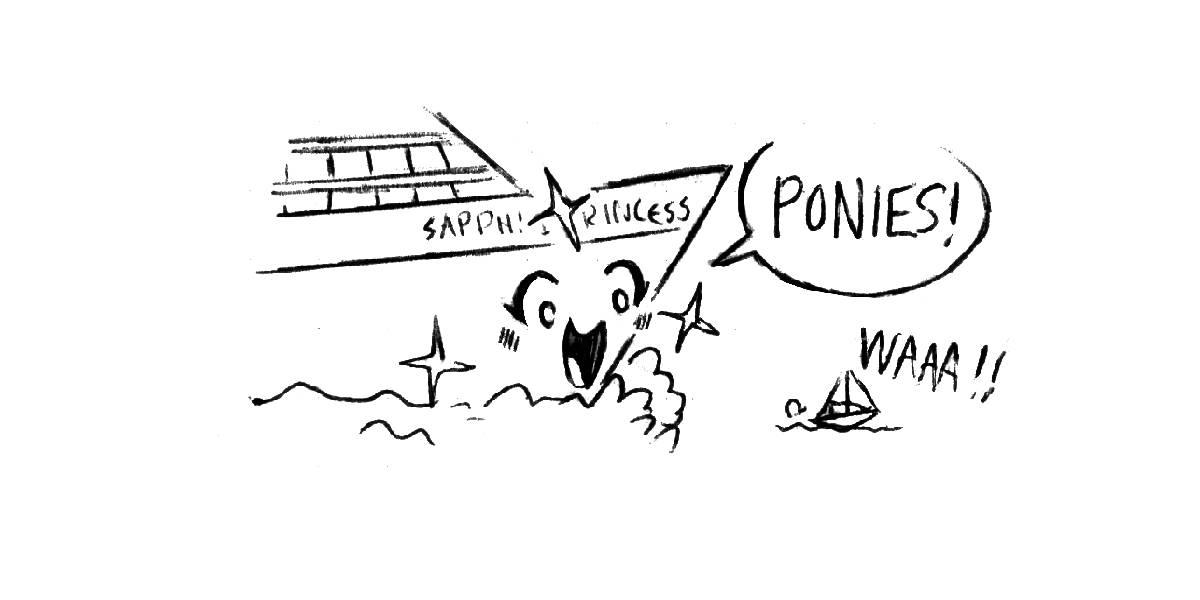 |
|
I cut one compressed wood brick into more digestible bite-sized bits for our woodstove. It took a while, we weren't meant to cut those things. I started by making shallow cuts with a handsaw, sized to the pieces that I wanted, then I used a hammer and chisel to break them off — some pieces required additional convincing. Good thing no one else was anchored with us, it was not a quiet affair.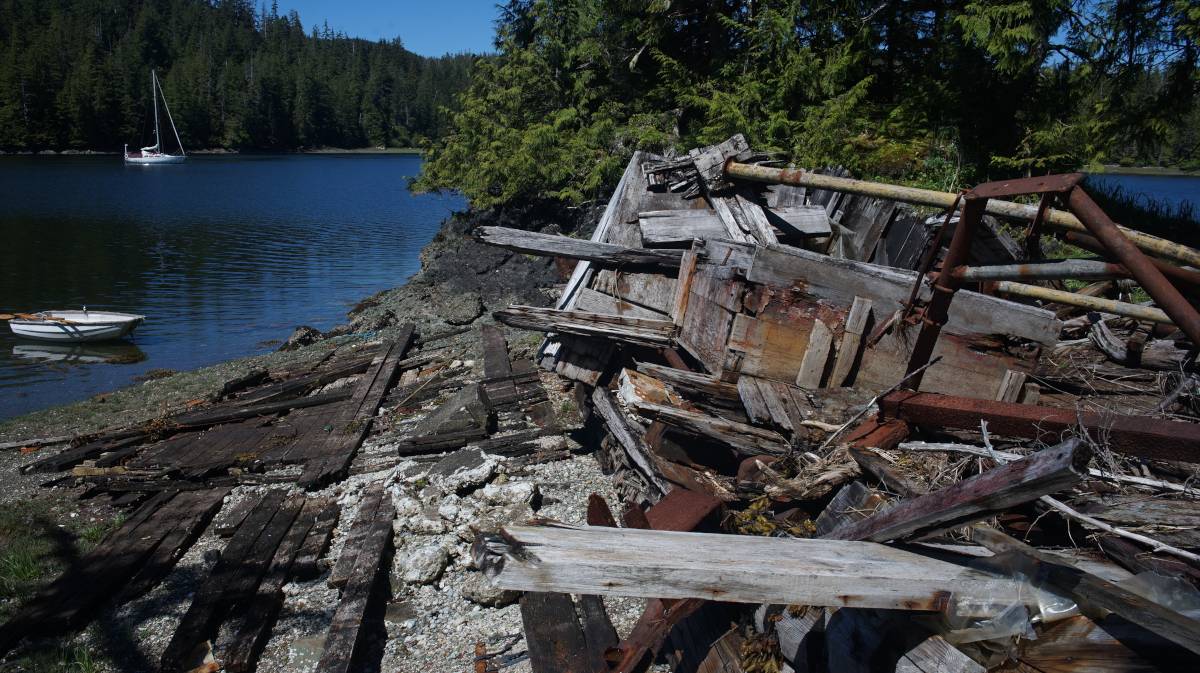 After splitting one whole block, I made mac and faux-cheese for lunch. After that, we put the dinghy into the water and Dev went for a row around the bay to explore it. Devine spotted a wreck on the small island occupying the middle of the bay, a very old wooden motor boat, split in two, with rusty innards. Devine sifted through the wreckage, they found an old breaker panel, a hammer, and a bullet casing. The engine was still whole, but it was so red and rusty that it appeared as if it had been battered and deep fried. After splitting one whole block, I made mac and faux-cheese for lunch. After that, we put the dinghy into the water and Dev went for a row around the bay to explore it. Devine spotted a wreck on the small island occupying the middle of the bay, a very old wooden motor boat, split in two, with rusty innards. Devine sifted through the wreckage, they found an old breaker panel, a hammer, and a bullet casing. The engine was still whole, but it was so red and rusty that it appeared as if it had been battered and deep fried.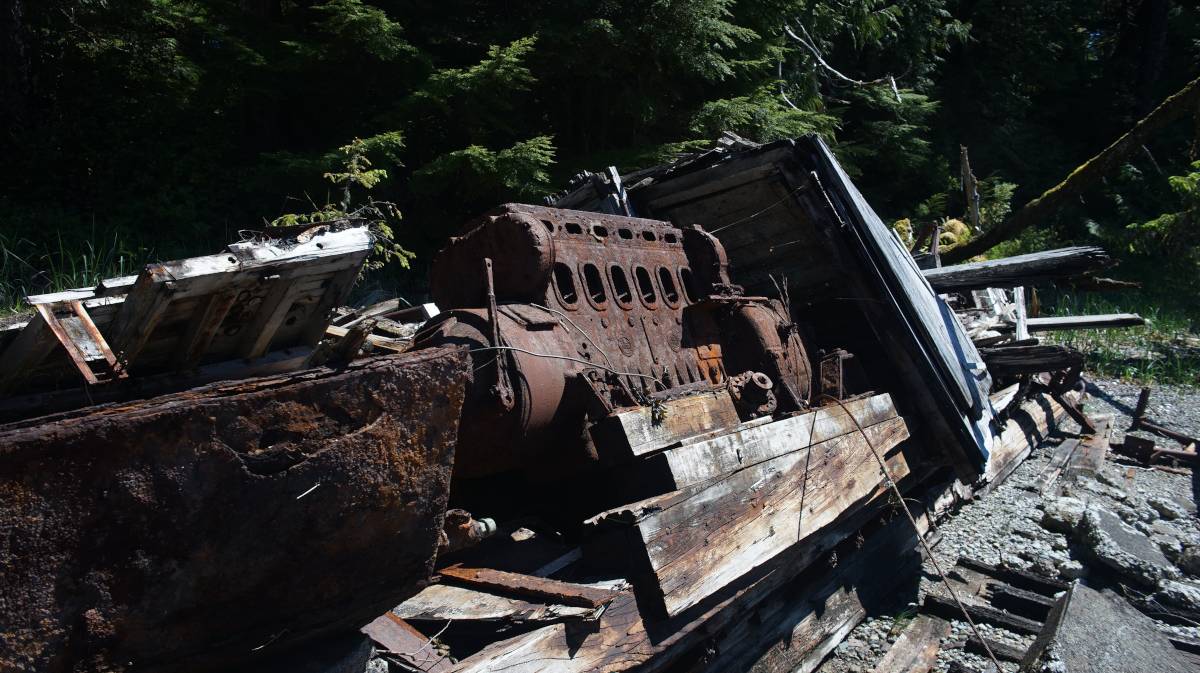 |
|
| The sun returned! I solar-cooked some chocolate chip cake. Later, I roasted some sunflower seeds to throw over the pad thai I would make for dinner. I missed solar cooking. I went for a row after dinner. The only wildlife I saw were clams spitting jets of water at low tide. On the way back, I noticed Pino had an algae beard, so I proceeded to trim it off — sorry Pino, no beard for you. A beard costs us speed, your bottom has to be smooth, smooth. We hoisted the dinghy back on deck at 2000, getting Pino back into sailing mode for tomorrow's transit. |
|
| June 7th | Snug Cove to Ratz Harbor to Snug Cove Another beautiful morning. We hoisted the anchor back aboard, and motored out of the anchorage at 0700. We left at low tide, the pass was much narrower, but fine for our draft (we had 5 m | 17 ft under the keel). Unfortunately, once into Clarence Strait, the wind was not there to greet us. The forecast had changed to a variable 10 kt wind, but the report assured us that it would settle back into the southeast in the early afternoon. We raised Pino's main anyway, ready to harness any passing breeze, but Calcifer II had to do most of the work. |
| There was a very strange optical phenomenon happening on the horizon all around us. We couldn't understand what was ahead or astern of us, "are you seeing this?" I said. It was a comfort to know that these strange visualizations weren't due to quirks of our vision. The land was distorted, mountains and trees were stretched and/or compressed together, on occasion some would appear inverted. We later learned that this was a type of mirage called a Fata Morgana. This type of mirage "occurs because rays of light bend when they pass through air layers of different temperatures in a steep thermal inversion where an atmospheric duct has formed."[Source]. |
|
The wind only rose out of the southeast at 1130, we were still 30 NM away from our planned anchorage. It was evident that we would not make it in time before the current switched direction at 1500. We thought that the increase in wind would permit us to make it to our backup anchorage, Coffman Cove, but even that seemed unlikely, so we aimed to stopped in Ratz Harbor.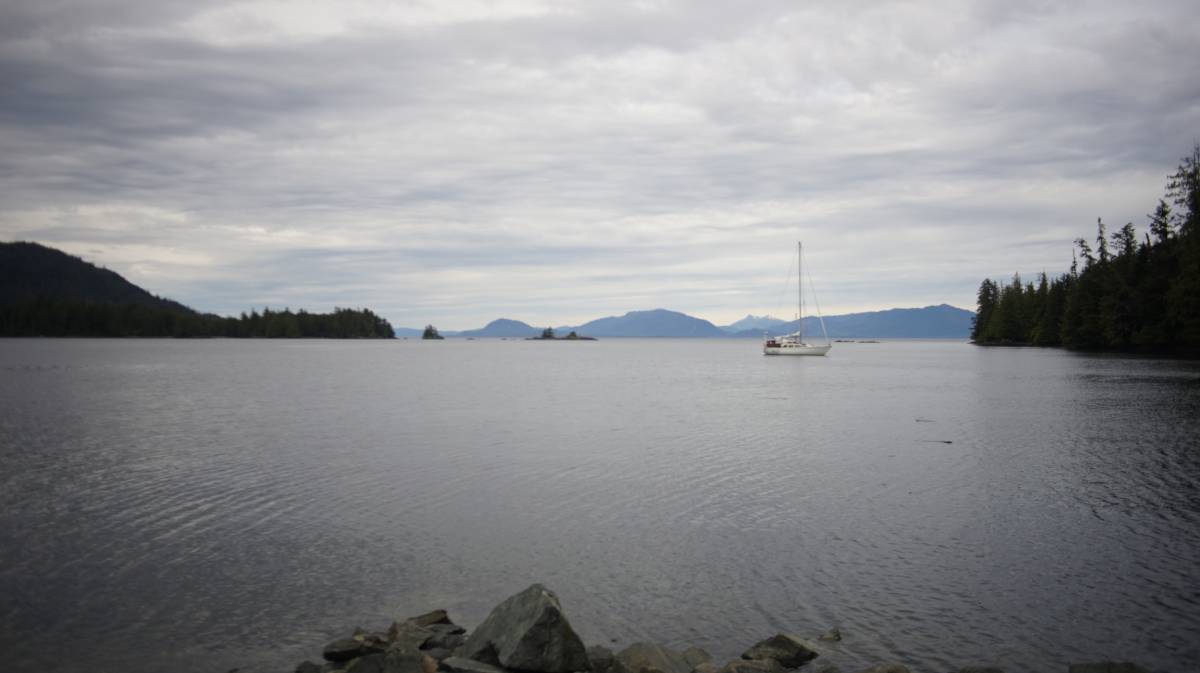 The southeast wind carried us all the way inside, we doused Pino's wings and went to anchor in the southern portion of the bay. The anchorage was deeper than we were used to, but we didn't have many options today, the depth would total 19 m (63 ft) at high tide. It was our first time having this much rode out(we put out 64 m | 210 ft). Unfortunately, after setting the anchor, I stepped on and destroyed my favorite pair of sunglasses. The frame cracked, and the left lens popped out and fell overboard, joining our anchor in the depths. I had often boasted about how even after 5 years, I had managed to not lose, or damage this particular pair, but now their time shielding my eyes had ended. So long sunglasses. The southeast wind carried us all the way inside, we doused Pino's wings and went to anchor in the southern portion of the bay. The anchorage was deeper than we were used to, but we didn't have many options today, the depth would total 19 m (63 ft) at high tide. It was our first time having this much rode out(we put out 64 m | 210 ft). Unfortunately, after setting the anchor, I stepped on and destroyed my favorite pair of sunglasses. The frame cracked, and the left lens popped out and fell overboard, joining our anchor in the depths. I had often boasted about how even after 5 years, I had managed to not lose, or damage this particular pair, but now their time shielding my eyes had ended. So long sunglasses. |
|
When we arrived, the wind was blowing from the head of the inlet, but the holding seemed good. We had a good view on Clarence Strait from here, it would be useful to gauge the state of the wind out there.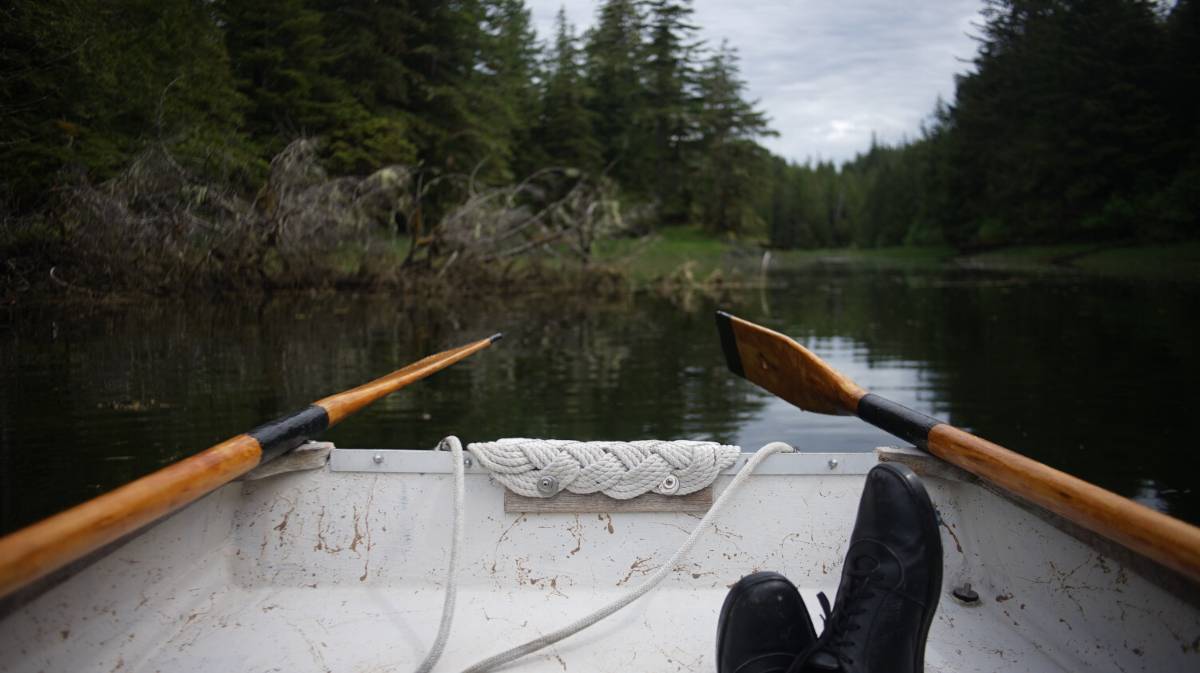 Devine hopped into the dinghy and went for a row around the bay. Their return home was always evident, marked by the sound of the dinghy oars cutting through the water. While ashore, Devine found old bullet casings(winchester .243), but was disappointed to find that a road lay nearby. Devine hopped into the dinghy and went for a row around the bay. Their return home was always evident, marked by the sound of the dinghy oars cutting through the water. While ashore, Devine found old bullet casings(winchester .243), but was disappointed to find that a road lay nearby.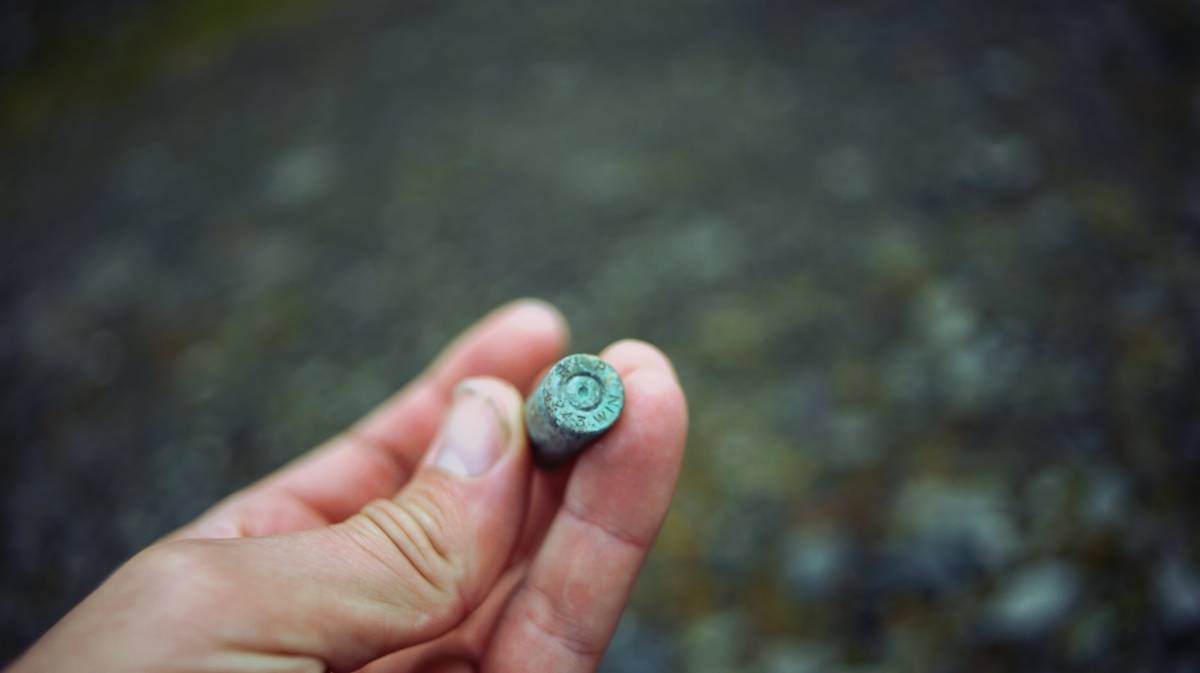 |
|
| We worked on our respective projects until we noticed that our position at anchor had changed. The anchor was still buried in the mud where we had dropped it, but we were now facing toward the opening of the bay. We went outside and saw that the wind had switched to the north. We hoisted the dinghy back on deck, as we did this the wind began to increase, putting us stern to shore. The head of the inlet was very narrow, and with 33 m (110 ft_ of rope rode out, Pino was swinging far, very near the shore. We had anchored here because we thought the wind was going to stay in the south, it hadn't. Our anchor was set well, but we were concerned that the weather would increase. We began lifting the anchor, with plans to leave this accursed bay, but our fears were realized because the weather did increase. Retrieving a 15 kg (33 lbs) anchor along with 30 m (100 ft) of chain and 30 m (100 ft) of rope rode, was not easy in conditions like this. Devine had difficulty keeping Pino pointing into the wind, making it harder for me to hoist in the rode. Devine motored ahead to try and ease the tension on the line, but then the line was pointing straight back, we couldn't understand why, and I couldn't do anything. Devine had stopped going forward but the rode was still running along the side of the boat, pointing backwards. After a few moments of hectic experimentation, the line was freed and Pino was swinging at the end of the rode again. Oof. Devine continued to motor forward, only giving little pushes at a time, permitting me to hoist in the rope rode. But when there was about 6 m (20 ft) of rope left to hoist, I had to stop. My arms were on fire. At that point I was hand-lifting a lot of weight. I wrapped the rode around a cleat, then rushed to the cockpit to grab my rope loop to make a prusik knot on the rode. I used the technique described in detail in no windlass to pull up most of the rode. When there was 15 m (50 ft) left to hoist, I did the rest by hand so Devine could focus on steering Pino away from the shore and its sharp rocks. I hoisted the anchor up, secured it, and we got the fuck out there. |
|
| We knew we could anchor in the northern portion of the bay, but we weren't sure if the wind was going to stay in that direction, we didn't want to have to do another emergency anchor rode hauling again... not so soon. Because the wind was coming out of the north, and that the tide was running south, we decided it best to return to Snug Cove, even if it meant losing 15 NM of progress. It was 1600 by then, we'd arrive late in Snug Cove... but at least we knew the anchorage well. It didn't feel good to lose progress, but this was the safest option. My arms were killing me, I had a hard time bending my fingers, they felt stiff, and achy. My right forearm appeared swollen. | |
Unfortunately, we had waves to contend with out there, especially in the area where Ernest Sound meets Clarence Strait. The waves were throwing us around, turning our ride south into a messy and uncomfortable affair. The water was erratic, we were tired, we didn't want this, we didn't need this. We felt trapped, with the world hellbent on making our lives more difficult. We knew this was just nature being nature, the sea was governed by a complex network of unseen hands, it wasn't malice, but we had to direct out anger somewhere.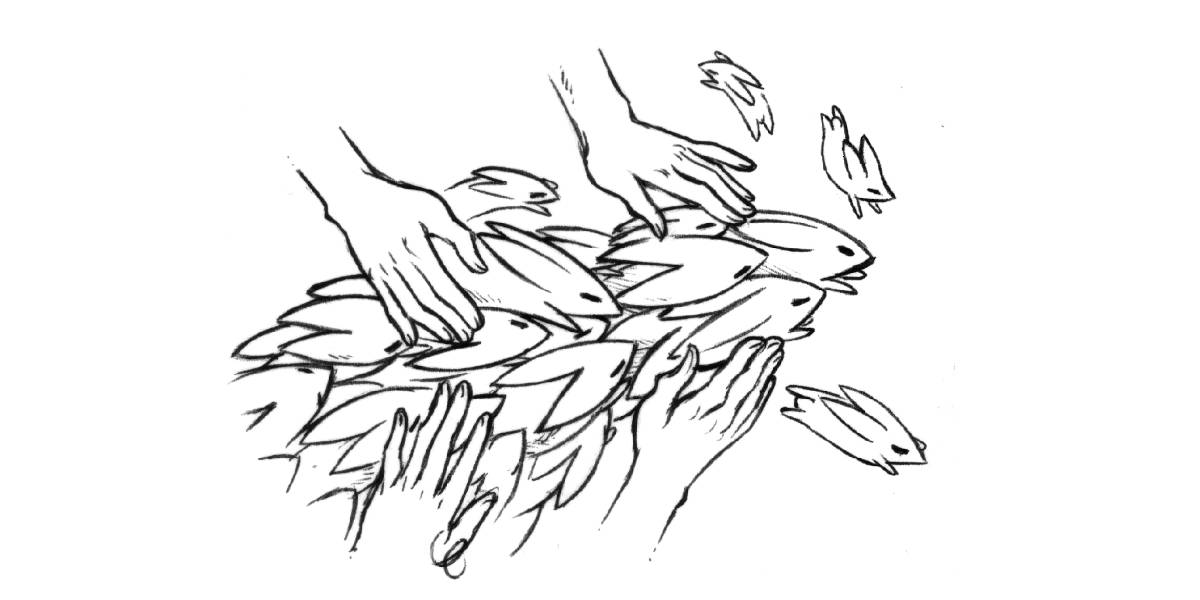 Devine raised the mainsail, I usually do this, but because of the state of my arm we thought it more prudent. Even with the mainsail up, the motion was awful, downright inelegant. "Is this how you boat?" Pino asked. "No," we'd say, "but whatever, just get us to Snug Cove Pino." We had to motor to make progress, the opposing waves reduced our sailing speed too much, then the wind lessened and we needed it all the more. Devine raised the mainsail, I usually do this, but because of the state of my arm we thought it more prudent. Even with the mainsail up, the motion was awful, downright inelegant. "Is this how you boat?" Pino asked. "No," we'd say, "but whatever, just get us to Snug Cove Pino." We had to motor to make progress, the opposing waves reduced our sailing speed too much, then the wind lessened and we needed it all the more.I felt terrible. When sailing in new waters, we usually make a point of never anchoring in exposed locations, especially in deeper waters... but this hadn't been a planned stop. We knew we'd have to break our rules sometime. We got the anchor up, yes, but it was hard, I got hurt and Devine couldn't operate the winch full time to help me raise the anchor while steering the boat. I wish we hadn't experienced this event, but it also taught us that we could get ourselves out of a lee shore in deep waters without a windlass. We didn't enjoy it, it was stressful as fuck, but it was possible. |
|
| Devine made the bed as I steered us near Tolstoi Island. Then, we switched roles, I went to pull the main down while Devine took the helm. We motored towards the entrance to Snug Cove, "back so soon?" it seemed to say. At 1940, we dropped anchor in the same spot we were at this morning. Devine made a lovely fire, we ate ramen, had beer, watched a film and went to bed. Fuck you world, lights out... | |
| June 8th | Snug Cove We got up at 0830 today, we were both very tired. My fingers were still sore, Devine's arms were sore too. Both of us needed a day of rest. |
| Snug Cove was calm as always, the wind never came from a stable direction, Pino has pointed everywhere today, spinning on their anchor, restless, annoyed to be bound to the earth yet again. Our Pino knows though that we only have so much energy to expend in a day, if we spend it all continuing is foolhardy, dangerous. Rest days ensures that Pino sails sooner. | |
| We will take a break from Clarence Strait tomorrow, we think, and head into Ernest Sound to anchor in Frosty Bay. My mind has been cluttered of late, filled with names of future anchorages, their upsides and downsides, all the possible routes we could take, the tides, the current, the wind directions and how they can turn a perfectly calm anchorage into a hellscape. Hopelessly cluttered. Sometimes, just taking another path, one I had not yet considered, removes the clutter instantly, because I haven't had time to hoard information yet. |
|
| We had small periods of sun today. Our lives remain bear-free. We had popcorn in the evening, a good way to end our day of rest. | |
| June 9th | Snug Cove to Frosty Bay The sky was grey today, southeast winds always bring rain. We left at 0900, the tide turned later today, permitting us to sleep in. We left Snug Cove at low tide again, but it was lower than last time, we had 4 m (12 ft) under our keel(there was 5 m | 17 ft last time). The rocks bordering the channel hugged the passing water, reaching for our little vessel. The forecast had called for 10 kts in the morning, increasing to 20 kts in the afternoon, but we had a solid 20 kts. We made our way through the reefs and raised our mainsail in the lee of Tolstoi Island, then, we hopped into Clarence Strait, yet again. The waves were not small, but despite them we made good progress. We crossed over to Ernest Sound in 45 minutes, going at 7 kts the whole way. It wasn't a relaxing ride, but it got us into tamer waters faster. The wind lessened, but did not stop, we were still sailing, aided by a few passing squalls. We ate warm soup for lunch, it helped us endure the growing cold. |
| The wind and rain were in our faces now. The wind was rolling over the hills from Behm Canal, it only lessened once past Eaton Pt. Once past Change Island, we had help from the wind again, not enough for good sailing, but it added 1/2 a knot to our motoring speed. We saw other boats on AIS, but they weren't aiming for the same anchorage. A boat behind us turned into Santa Ana inlet, while we headed to Frosty Bay, alone. We'd read that seals enjoyed laying on the rocks near the entrance to the bay, but we saw none, how sad... we had hoped for a ruckus. We dropped anchor in 18 m (60 ft) of water at high tide(highest tide), making sure to stay far from shore to avoid another Ratz Harbor incident. 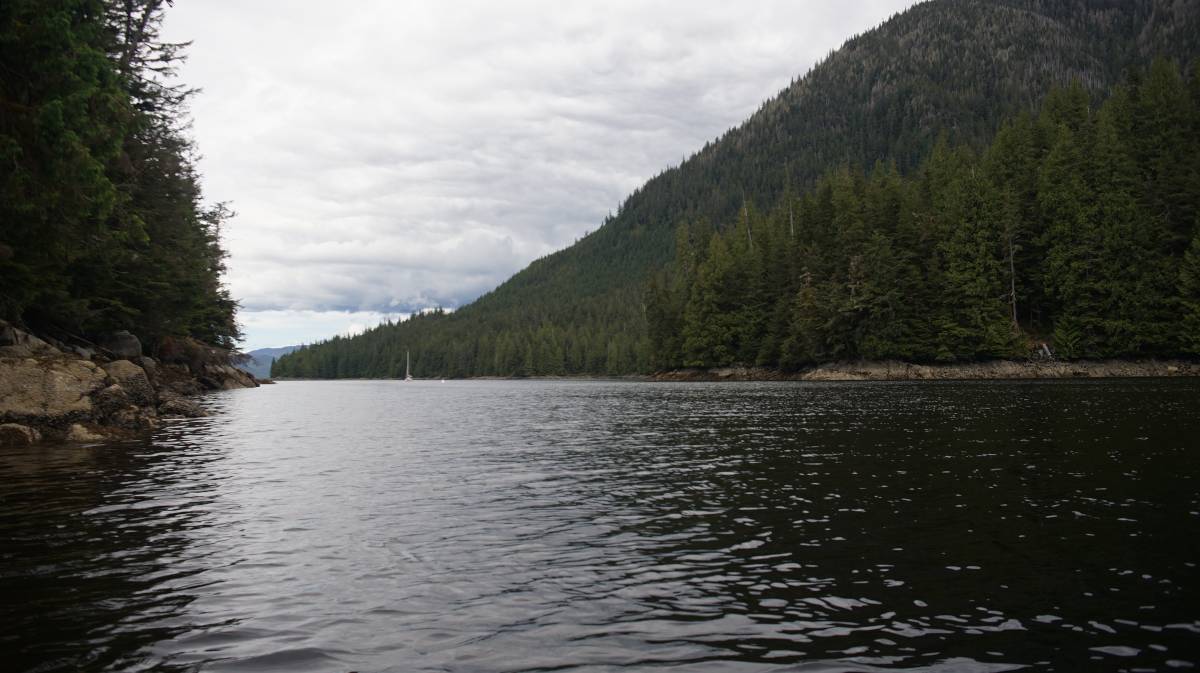 |
|
| Devine prepared coconut curry for dinner, a hearty, comforting dish. | |
| Week 7 | |
| June 11th | Frosty Bay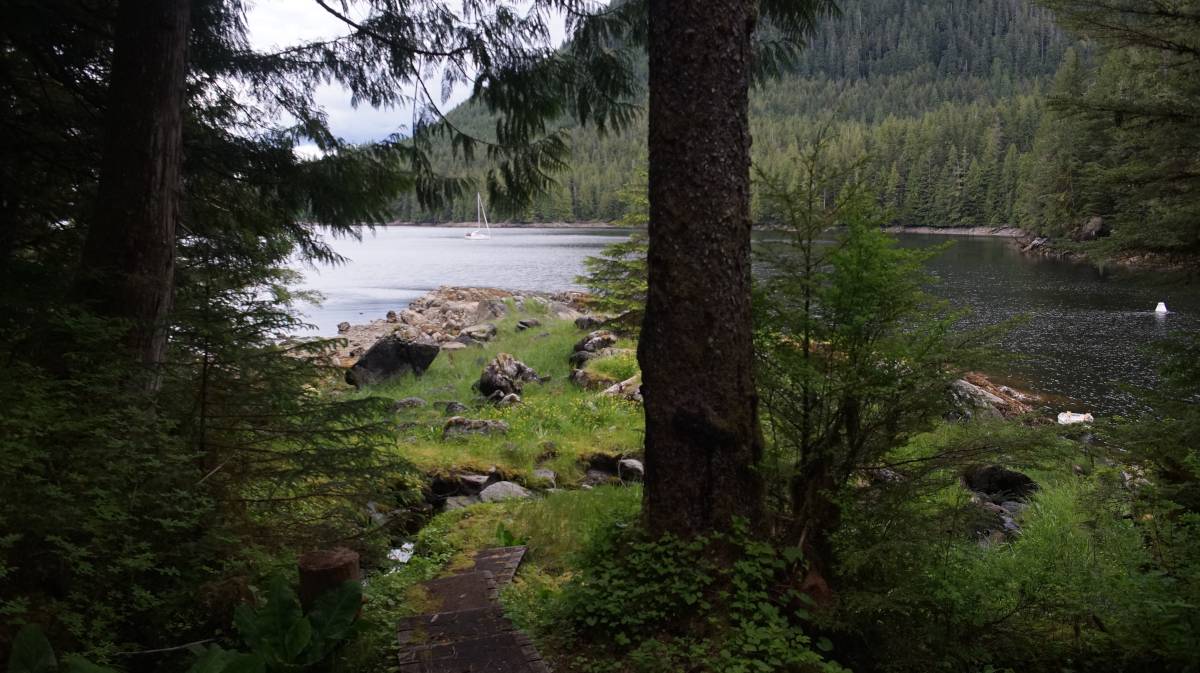 The forecast called for a northwest wind, we wondered if the wind would make it in here. For now, the bay was calm, devoid of wind... and seals(still). The forecast called for a northwest wind, we wondered if the wind would make it in here. For now, the bay was calm, devoid of wind... and seals(still).The scenery was lovely, we were tucked between mountains, a mooring ball guarded the shallow end of the bay. We had to anchor in deep waters yet again, the shallower areas were too close to shore. We will spend the day here. |
| The southern part of Southeast Alaska resembles British Columbia, but with more distance between anchorages, and more difficult sailing and navigating. It is less wild than I expected, with marinas tucked into many bays, even in remote places, with cruise ships going through the area all day. They moor in Wrangell, Hoonah, Sitka and Juneau. Restocking is easy, we haven't had to dip into our extra water bins yet, we still have plenty of fresh vegetables with many opportunities to replenish our stores. | |
The wind here appeared to be a bit fickle, it changed direction and strength often during our 2-day stay. The sun came out after lunch, so I went outside to cut up some more kindling. While at the dock in Port McNeill, Devine split 5 logs into smaller lengths for our woodstove, but we always have to cut them down again so that they fit inside the firebox of our stove. The logs were all split, but we had a bag-full of uncut kindling. The days have been cold, so we've been running the woodstove often. Our woodbox in the aft locker was half empty, so I went to work cutting the kindling in half with a hacksaw, while Devine went out for a row around the bay.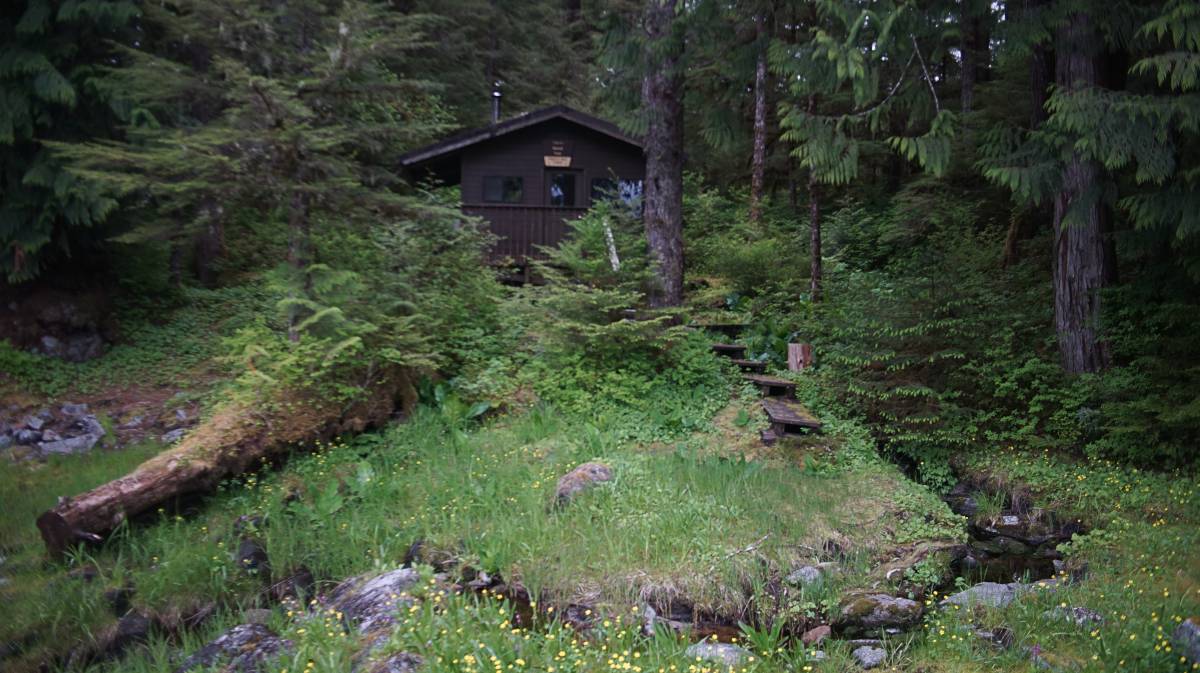 They went to visit a lonesome cabin which hosts guests in the summer(people can book time in the cabin). Inside was a heater, bear repellant, beds, an outhouse, and other necessities. Devine signed the guestbook; only one other boat had signed it this year. Some of the entries were dated back to the late 90's. They went to visit a lonesome cabin which hosts guests in the summer(people can book time in the cabin). Inside was a heater, bear repellant, beds, an outhouse, and other necessities. Devine signed the guestbook; only one other boat had signed it this year. Some of the entries were dated back to the late 90's. |
|
| June 12th | Frosty Bay to Berg Bay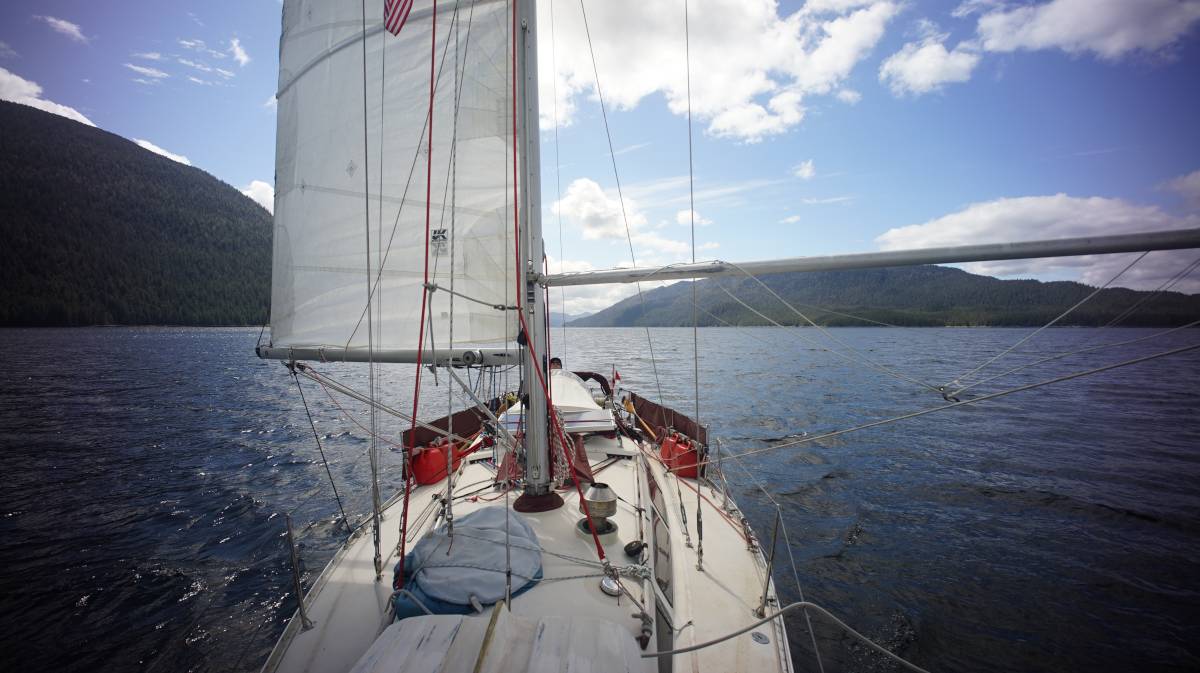 It rained all night, we learned that we had not resolved the leaky deck iron issue. Fuck fuck fuck. We went outside and squirted more Life-Calk into visible crevices, hoping that it would help. The rain dripping inside is wetting the woodstove, it could cause it to rust... It rained all night, we learned that we had not resolved the leaky deck iron issue. Fuck fuck fuck. We went outside and squirted more Life-Calk into visible crevices, hoping that it would help. The rain dripping inside is wetting the woodstove, it could cause it to rust... |
| We bailed rain water out of the dinghy and hoisted it back on deck. We had 2 hours to wait before we could leave because of the tides, the tides... the tides. We have to be patient with the tides. It was cold out today, Berg Bay, our planned anchorage, would probably be colder. "Do you remember the Shire Mr. Frodo?" Devine asked me. There are times when moroseness takes hold, it is not possible to find beauty in the world, even when surrounded by wonders. Anxiety obliterates beauty, it buries joy. Both of us were aching for quiet, warm water. "Eat your lembas bread Mr. Frodo, we've got miles to go yet." 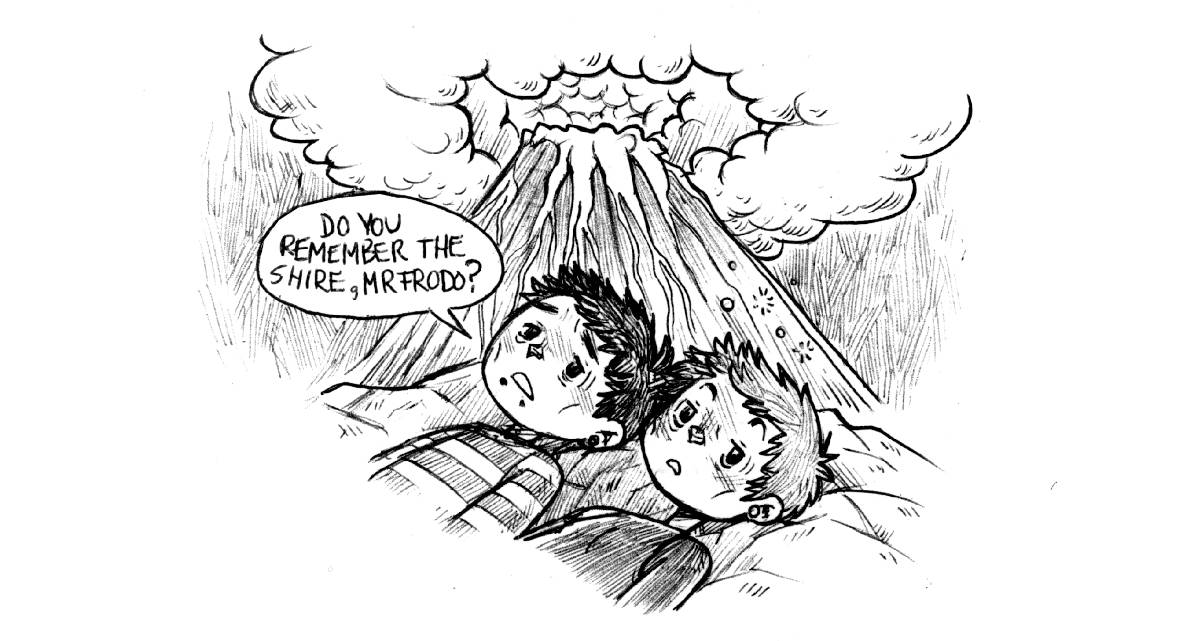 |
|
| At 1100, we pushed off and headed towards Berg Bay, 15 NM away. South winds helped push us to Point Warde, permitting for some lovely wing-on-wing sailing. After the point, the wind became too erratic to sail with, coming from too many different directions. We had to motor past Anan Bay, and then past Blake Island. When in the last stretch south of Berg Bay, we noticed the water had turned a jade color. Some current was fighting us, we attributed this to snowmelt. The change in color happened suddenly. | |
We could see our anchorage ahead, with its small islets guarding the entrance. As we got nearer, beautiful snowy mountains lined the horizon. We saw that one motor boat was already anchored in Berg Bay, at the head of the anchorage. Motor boats often like to cruise in groups, and when they arrive somewhere they take up most of the room. We were glad to find only one other occupant today. A light wind was blowing from the head of the inlet, we anchored behind them in 19 m (65 ft).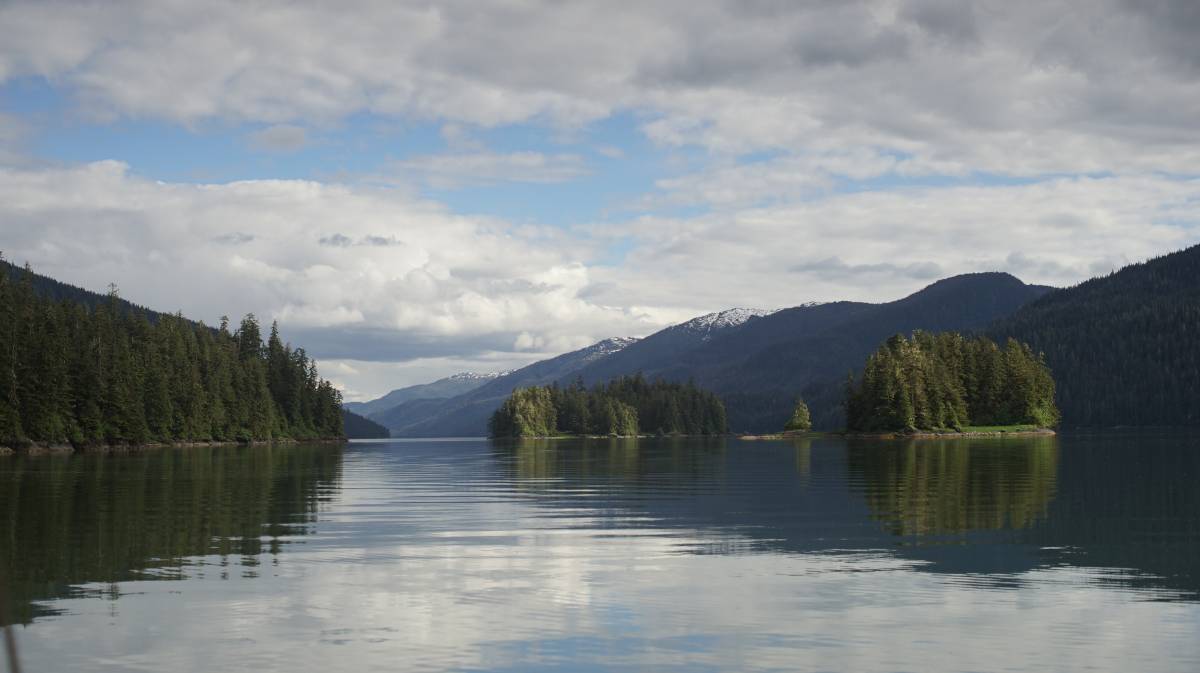 |
|
| The wind turned later, blowing from the entrance. I hate when the wind switches shortly after we've arrived — Chill Frodo, chill. I mended a few holes in a wool sweater. All of my quality sweaters were fragile, trying to keep up with the deterioration was like trying to shovel while it was snowing. I also fixed my fleece sweater, the zipper had parted from the material. We continue to layer on many clothes when sailing, but less than when we started this trip. We had to shed a few layers when sailing today when the sun made an appearance. |
|
| We are not sure if we're going to stay tomorrow, or not. We'd have to get up at 0530 if we hoped to make it to Wrangell. In the upcoming part of Blake Channel, the flood tide from the south meets with the flood from the north, meaning that we have to leave with the slowing flood in time to catch the other as it switches. | |
| June 13th | Frosty Bay to Wrangell The alarm rang at 0530, we snoozed for 15 minutes, then our bodies slid out of the sheets before our minds had time to realize what had happened. We had decided to leave today after all. On came the clothes, the chartplotter's screen dazed us with its brightness, the depth sounder let out its usual two beeps to let us know that it too was ready to face the day. I walked to the bow, foggy-brained, and began to pull up 64 m(210 ft) of rode. Berg Bay's bottom had not had much time to get acquainted with our anchor. At 33 m (110 ft), I attached a prusik knot, and we proceeded to haul in the rest with the help of a cockpit winch. It was tricky to pull up the anchor by hand in deep waters, when holding all of that weight the pull was monstrous, it was like the seafloor wanted to come up to meet us. |
We left Berg Bay under a clear sunny sky — the sun rises early in this part of the world. We motored towards the narrows, aiming to arrive at slack. It was interesting to be in a place where the current reverses like this, it permits a sort of hack where we cheat time. The flood ought to have ended at 0645, but because of the reversal we could ride a double flood and arrive to Wrangell early(instead of at noon, with a regular flood).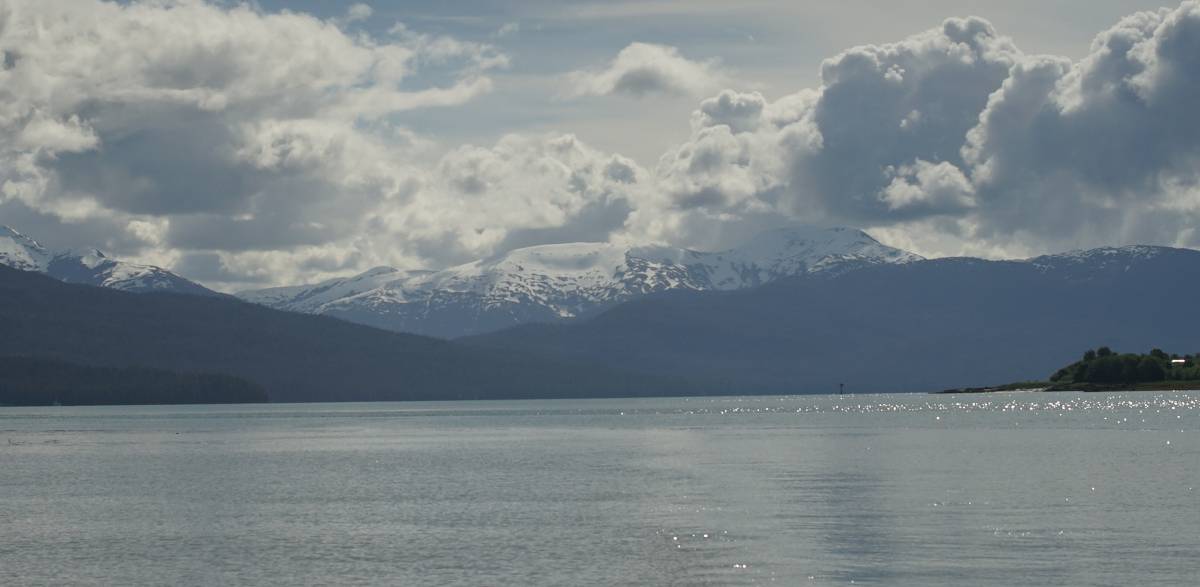 We made it to the narrows on time, then the north-going ebb pulled us in and carried us further north. The scenery on the way to Wrangell was very beautiful, we got to see many more snowed-in mountains. Because the skies were clear, we could see their summits, at times the sun reflecting off the snow burned my eyes. We made it to the narrows on time, then the north-going ebb pulled us in and carried us further north. The scenery on the way to Wrangell was very beautiful, we got to see many more snowed-in mountains. Because the skies were clear, we could see their summits, at times the sun reflecting off the snow burned my eyes. |
|
| We saw the color of the water change yet again, as the Stikine River water met with Sumner Strait. We could see the tideline clearly, the difference in color made the divide evident. We crossed into lighter-tinted water again, and began to see boats, many boats! A cruise ship was near the terminal but was not docked, it appeared to be idling on the spot, unmoving. We made sure it wasn't moving because we had to cross its bow to get to the marinas. Tourists watched us from the deck as we moved past, others were boarding shuttles to get to shore and back. | |
When nearing Etolin Harbour, I looked with binoculars to see if there was room on their transient float. It was full. We turned away and went to check out Heritage Harbour instead. There was plenty of room for us there, and for many more boats .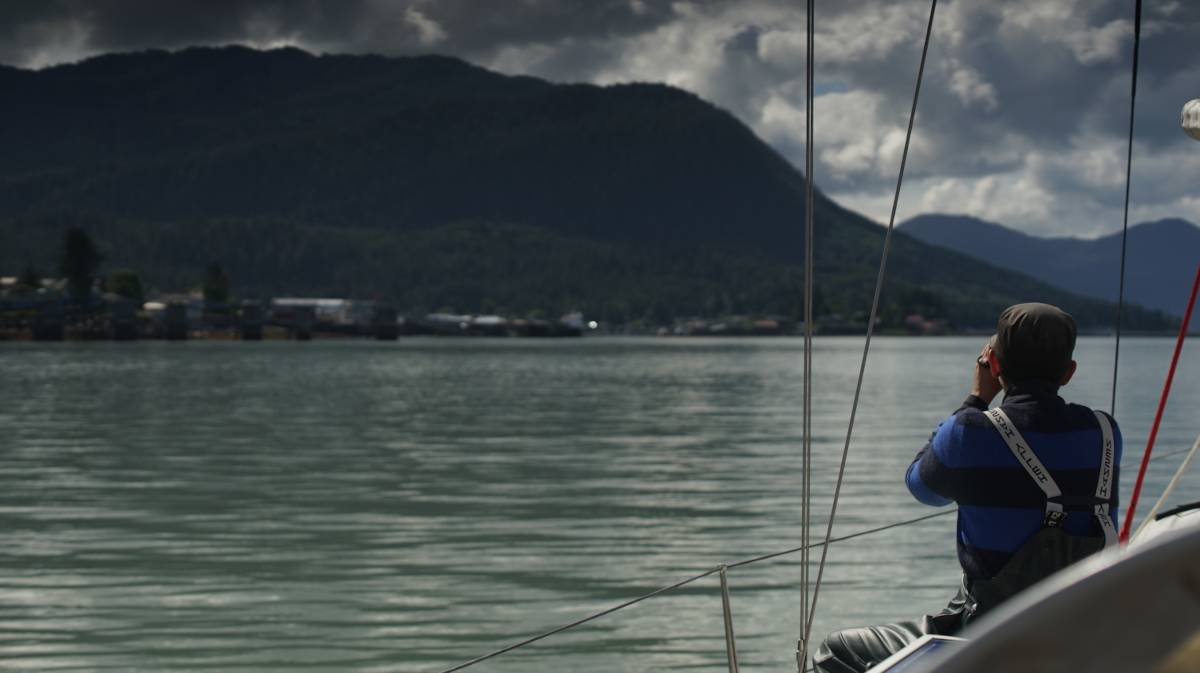 Much of the boats here were rugged, expedition-type boats, made to endure ice, and cold weather. Aside from us and another small fibreglass sailboat, we were surrounded by larger, heavier vessels. Much of the boats here were rugged, expedition-type boats, made to endure ice, and cold weather. Aside from us and another small fibreglass sailboat, we were surrounded by larger, heavier vessels.Both of us were starving, we planned to make lunch before visiting the harbour master's office in Etolin Harbour to check in. We were meant to report our arrival to the CBP right away, but like in Ketchikan, our phone would not permit it. My plan was to, yet again, ask to use the phone at the harbour master's office. We suddenly heard a knock on the hull, a CBP officer was there, they had likely spotted us on AIS. We explained that we had not yet reported our arrival because of our phone situation, he was cool about it, and even offered to check us in early for our arrival in Petersburg, since apparently he was responsible for the reporting requirements in both cities. We filled our stomachs with corn pone and chipotle peppers before going out. We ought to have looked at the map better, so we took the long route to the harbour master's office. After paying for our moorage, we stopped by the grocery to stock up on fresh foods. The selection was very poor, and the produce on the shelves was pallid, and soft. This produce would provide nutrients to no one ever. |
|
We got lost on the way back home, it extended our walk by a few miles, which was unfortunate because our backpacks were very heavy with supplies. We spent the rest of the day aboard, resting, mending more holes in our clothes and checking messages. Joy to the world! The crotch integrity of my favorite pair of jeans was restored! We watched the 3rd installment of Pirates of the Caribbean, a film, like with the produce from earlier, that is enjoyable, but that does not offer much nourishment.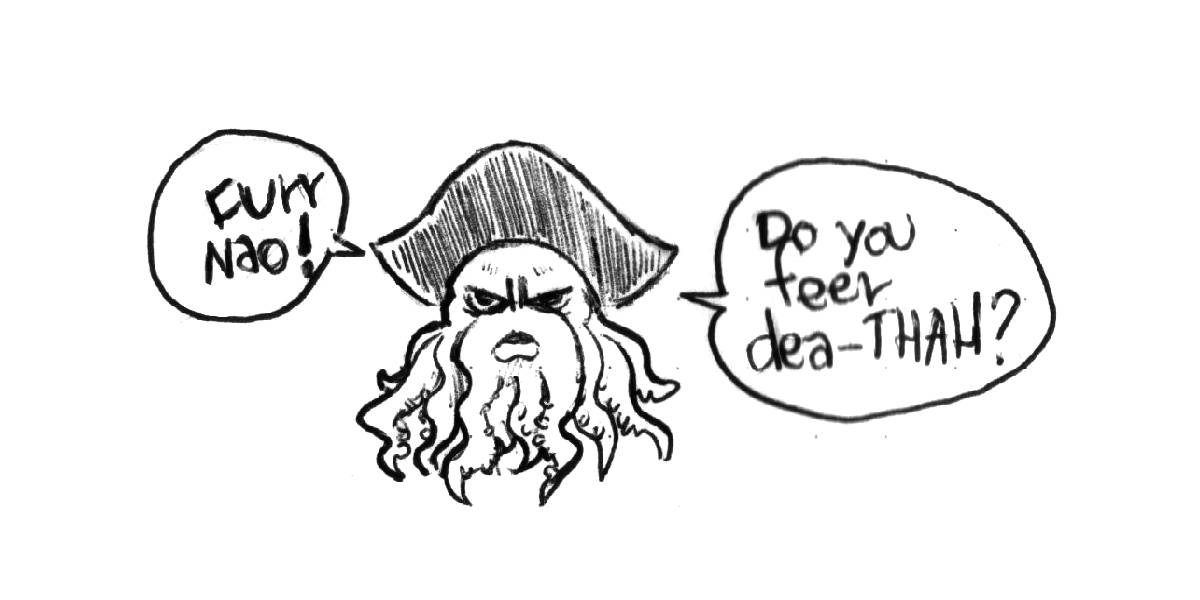 |
|
| June 14th | Wrangell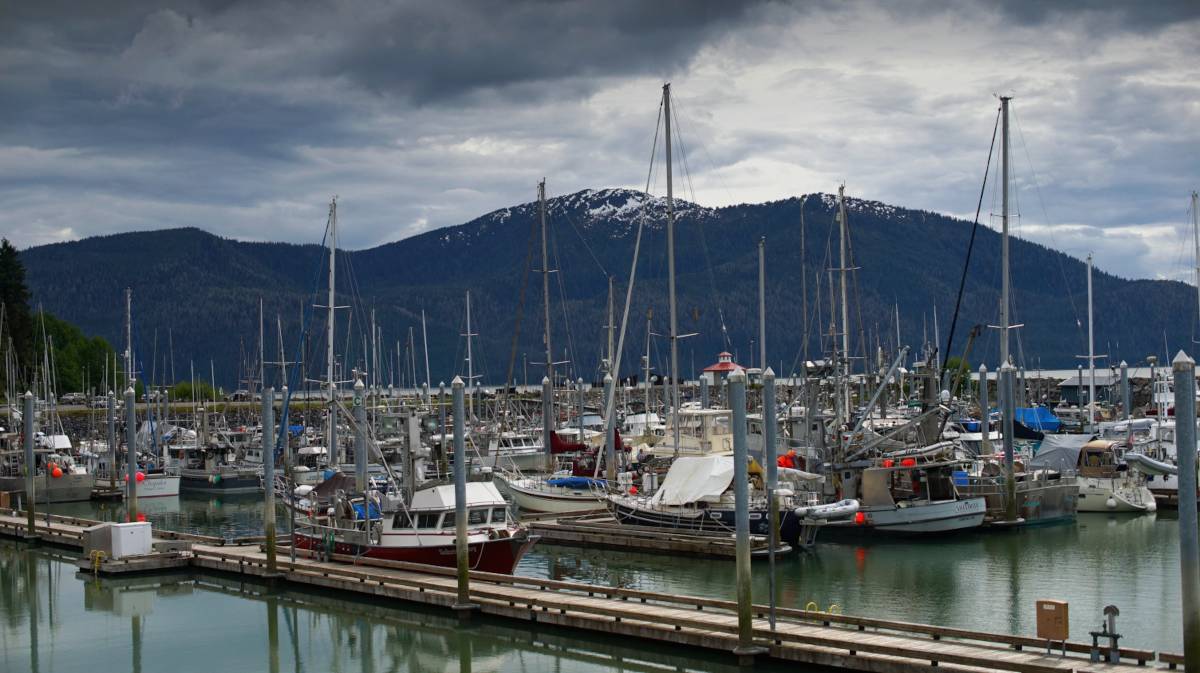 A quiet day in Wrangell. We woke up to another windless day, with full sun. It is almost like being in the Southern Gulf Islands during the summer. I repaired the end of our whisker pole today, the snap mechanism was broken, the spring inside was corroded and the fix I had attempted a few years ago did not last. We have since run the jib sheet line through an attachment point at the end meant for the topping lift halyard, but it was a tight, tight fit. Today, I made a rope loop using a double fisherman's knot and ran it through that same attachment point. The rope loop line is thin, so it doesn't interfere with the halyard snap shackle. When we want to set up the whisker pole, we put a carabiner through the rope loop and snap it onto the jib sheet. A good fix. A quiet day in Wrangell. We woke up to another windless day, with full sun. It is almost like being in the Southern Gulf Islands during the summer. I repaired the end of our whisker pole today, the snap mechanism was broken, the spring inside was corroded and the fix I had attempted a few years ago did not last. We have since run the jib sheet line through an attachment point at the end meant for the topping lift halyard, but it was a tight, tight fit. Today, I made a rope loop using a double fisherman's knot and ran it through that same attachment point. The rope loop line is thin, so it doesn't interfere with the halyard snap shackle. When we want to set up the whisker pole, we put a carabiner through the rope loop and snap it onto the jib sheet. A good fix.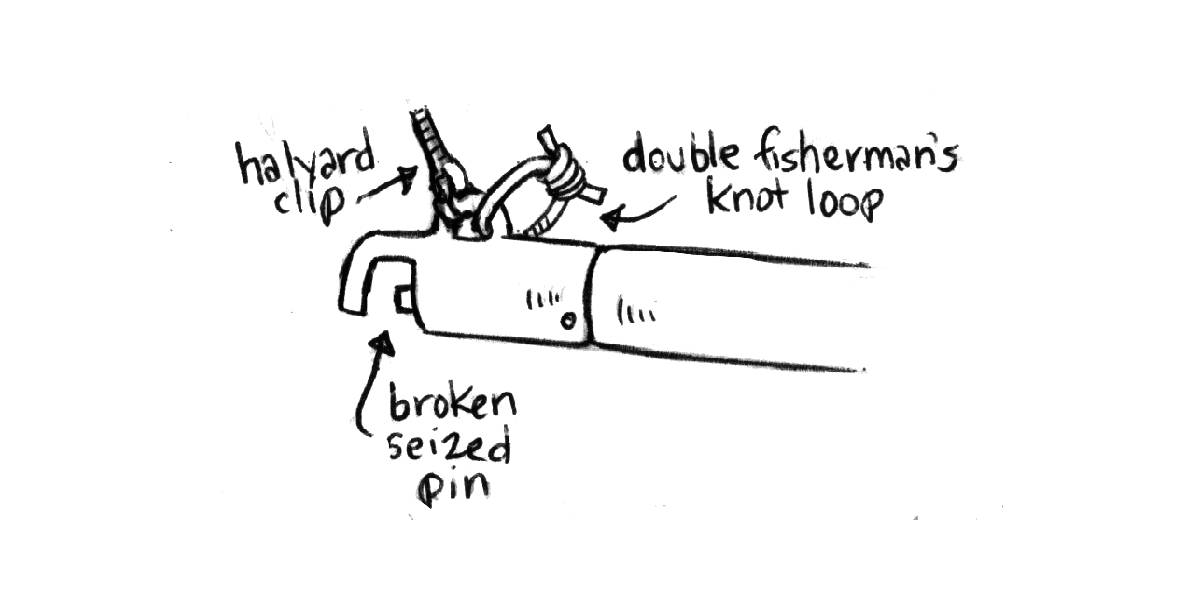 |
| We returned to the grocery store to pick up a few extra much-needed items, and to try and dispose of our aluminum cans responsibly. Ah, Southeast Alaskan ports, with oil disposal facilities near every exit, but disposal of cans requires walking for 20 minutes, finding the hidden bin near the grocery store at the far end of the parking lot(had there been any cars, it would have been impossible to see it) — really though, I was glad that oil was disposed of responsibly, not providing those collection sites would result in careless acts. The city was well-equipped for getting repairs done, there was a boatyard, plenty of hardware stores, fabrication shops, etc. Speaking of fabrication, while in a public restroom, Devine & I both fixated on the design of the toilet paper roll holder. The design was simple, strong, and effective. In most public restrooms, the holders are made of cheap plastic, we loved that they had fabricated their own. If someone were to ask us what we think about Wrangell... "LOVE their toilet paper roll holders!" |
|
| Around 1600, we sat in the cockpit and enjoyed watching the eagles hound the fisherman just returning with the day's catch, they would find a perch near them and keep watch, waiting for scraps. One eagle tried to land on the masthead of a sailboat, we cringed a little when we saw its talons bite at the instruments mounted there, trying to find a comfortable foothold. In the end, it grew tired of trying and found a spot on a fishing boat rig. We've had plenty of time lately to observe eagles from up close, they're such beautiful birds, although they seem to rely on local fishermen a lot for food. | |
| Once the sun was lower in the sky, I went to work trimming Pino's algae beard again. On our last haulout, we picked a different type of bottom paint. We regretted it, because it was not as good at discouraging growth. When I finished, Pino wasn't clean shaven, but there weren't as many visible strands. We leave tomorrow for Deception Point Cove to stage our passage through Wrangell Narrows to get to Petersburg. |
|
| June 15th | Wrangell to Deception Point Cove Up at 0600, gone at 0730. On the way out we stopped at the Etolin Harbour fuel dock to fill 3 x 20 L bins. The waters were calm when we left the dock, we motored over smooth, jade-colored seas until we reached Neal Point on Vank Island, the west wind was curling into the pass between it and Zarembo Island. We raised the mainsail and let Calcifer go back to bed. The forecast today had called for 10 kts out of the west, but we had about 15 instead. We tacked into the wind all the way to Point Alexander, at the southwest end of Mitkof Island. The mixture of American and Russian names, we thought, was very amusing. |
| The sun was with us, we didn't have to wear many layers today, but the wind was still cold. We arrived at Deception Point Cove at 1600, it was a long day on the water. Sailing to weather always means a long day on the water. 21.8 NM ballooned to 40 NM. |
|
| The wind curled around the corner and into the anchorage from the south, but a reef helped to diminish some of the wavelets. This bay was shallow with a mud bottom, we anchored in 3 m (10 ft) of water — how lovely. Space in the bay was restricted by two large logs tethered to the ocean floor, left there for securing log booms. A fishing boat joined us at anchor a few hours later. | |
| June 16th | Deception Point Cove to Petersburg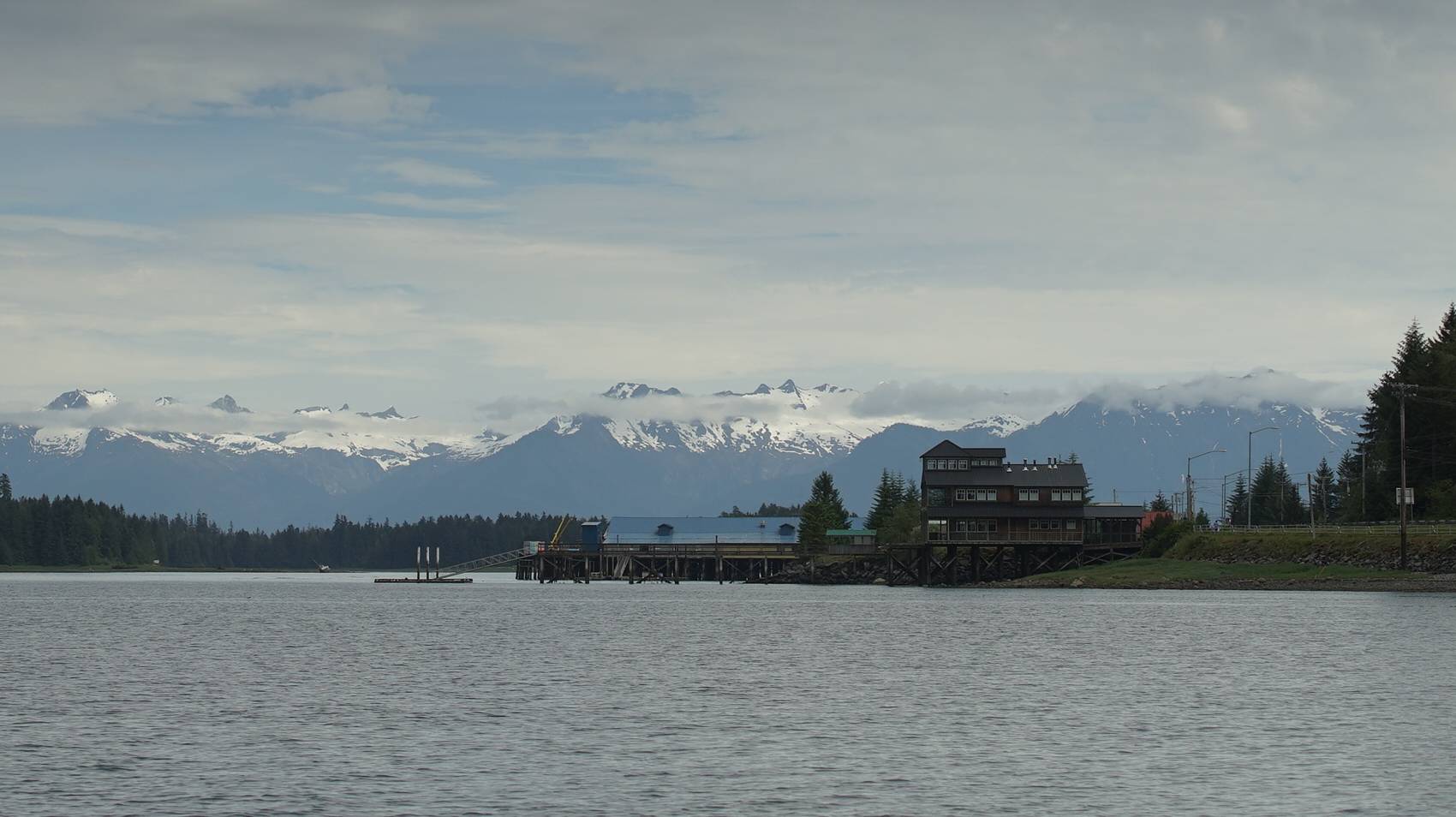 We left Deception Point Cove at 0700, the fishing boat was already gone. Lifting the anchor in this kind of depth was very easy! We pulled a chunk of sticky grey mud, as well as some algae. The mud was so sticky that I had to clean it off the fluke so I could secure the anchor properly, the accumulation was keeping the anchor too far forward on the bow. We left Deception Point Cove at 0700, the fishing boat was already gone. Lifting the anchor in this kind of depth was very easy! We pulled a chunk of sticky grey mud, as well as some algae. The mud was so sticky that I had to clean it off the fluke so I could secure the anchor properly, the accumulation was keeping the anchor too far forward on the bow. |
A lot of tug boats towing large barges, commercial fishing boats and large passenger ships(like the Alaska ferry) use Wrangell Narrows. Some parts of the narrows were very constricted, and if a large ship was coming through we would have to get out of its way. The goal of the game was to constantly look behind, or ahead, and if a big vessel was coming, it was time to find a place to duck out of the channel to let them by. As soon as we left the anchorage, we saw a tug boat on AIS, a big one, pulling a very big load. We kept an eye on it as we proceeded through the narrows. It caught up to us near Green Rocks, we moved out of the channel and into the bight just east of Christmas Tree Rock to let it pass. We knew that this area was ahead, it wasn't too shallow, it had few rocks, a very good place to idle. It was powering north at 10 kts, pulling a heavy barge carrying containers, and construction vehicles. The tug pulling it was gargantuan.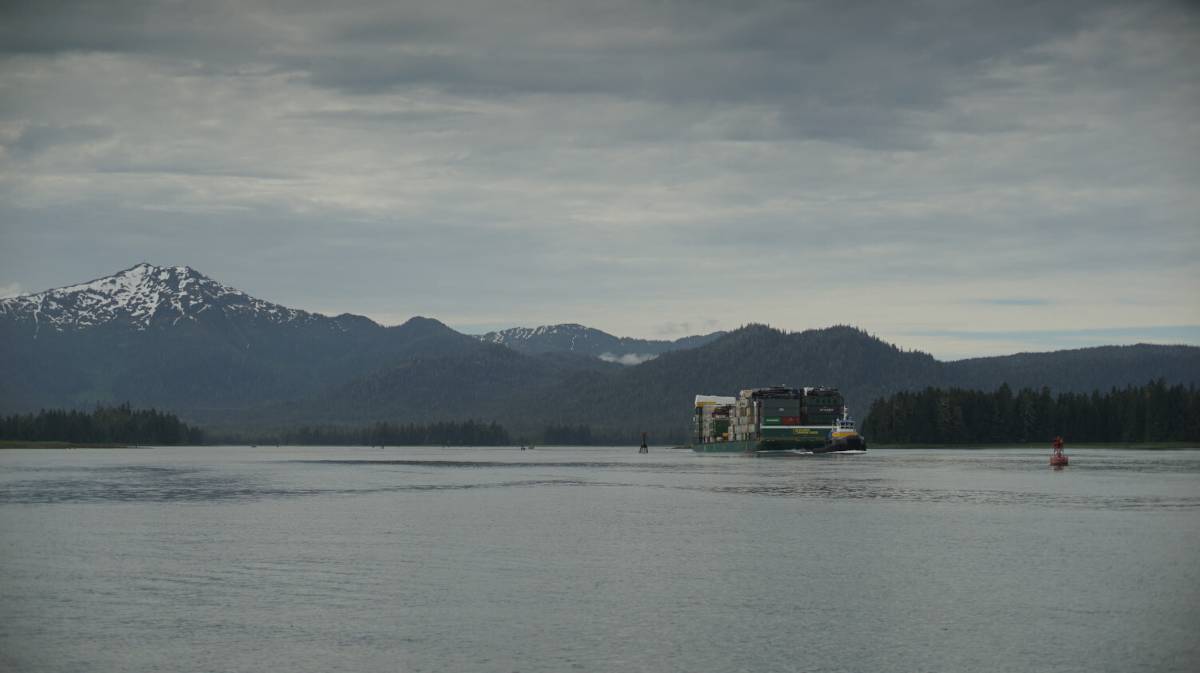 We encountered many more boats in Wrangell Narrows, mostly small run-abouts, or medium-sized cruising or fishing boats. All of these were easy to deal with, as long as we kept to our side of the channel. |
|
| Like Blake Channel, this was the kind of channel where the current meets from the north and south between channel markers 44 and 50(what we refer to as the pinch, one of the narrowest points). To not have to suffer an opposing current, it was a good idea to time the northbound transit on the last of a flood. As the flood(south current) lessens to zero, if the boat is positioned where the north and south currents meet, the north current will start to ebb and carry us north. We knew we had to get to the pinch at 0940, we arrived at 0930. When you know your boat well, timing arrivals with precision is not too difficult, we always give ourselves a bit of extra time to make speed adjustments... because there is always something that happens that slows us down(like letting that tug pass). | |
| Once past Turn Point, as the land drew away, emerged a beautiful snowy mountain range just behind the city of Petersburg. With the port in sight, it was also time to call the harbormaster on the radio to get a slip assignment. It was possible to anchor at various points along the narrows, but we decided to push on. Slips in this harbor were not expensive. Like in Ketchikan, transient boats were assigned to slips that the owners had temporarily vacated. The harbormaster assigned us a spot on the south side of the south finger in North Harbor. We were glad that they had assigned us to the north docks, that way we were closer to the harbour master's office, where the showers are. We were dying for a hot shower, our last one was in Prince Rupert. Because we arrived at the start of a rising flood, some current ran through the channel leading to the docks, and affected our steering. We could feel a slight current pushing us sideways as we went down the row of docks, but it wasn't strong enough, not yet, on large tidal exchanges it would likely be very difficult to get to a slip. |
|
| After signing in, we took a short walk around town to take in our neighborhood of the moment. It was a really lovely place. We didn't get to see much because we had arrived on a sunday, many shops and restaurants were shut, the only business that was open was a small, very wholesome, road-side lemonade stand operated by two enterprising kids, a thing we thought only existed in Archie comics. The town has Norwegian roots, which explains some of the street names, Norway flags, and decorations around town, despite the fact that prior to their arrival, the land was already long occupied by Tlingit people. It was warm and sunny all day, but this may be the last that we see of this kind of weather, the greyness will return tomorrow. |
|
| June 17th | Petersburg to Ruth Island Cove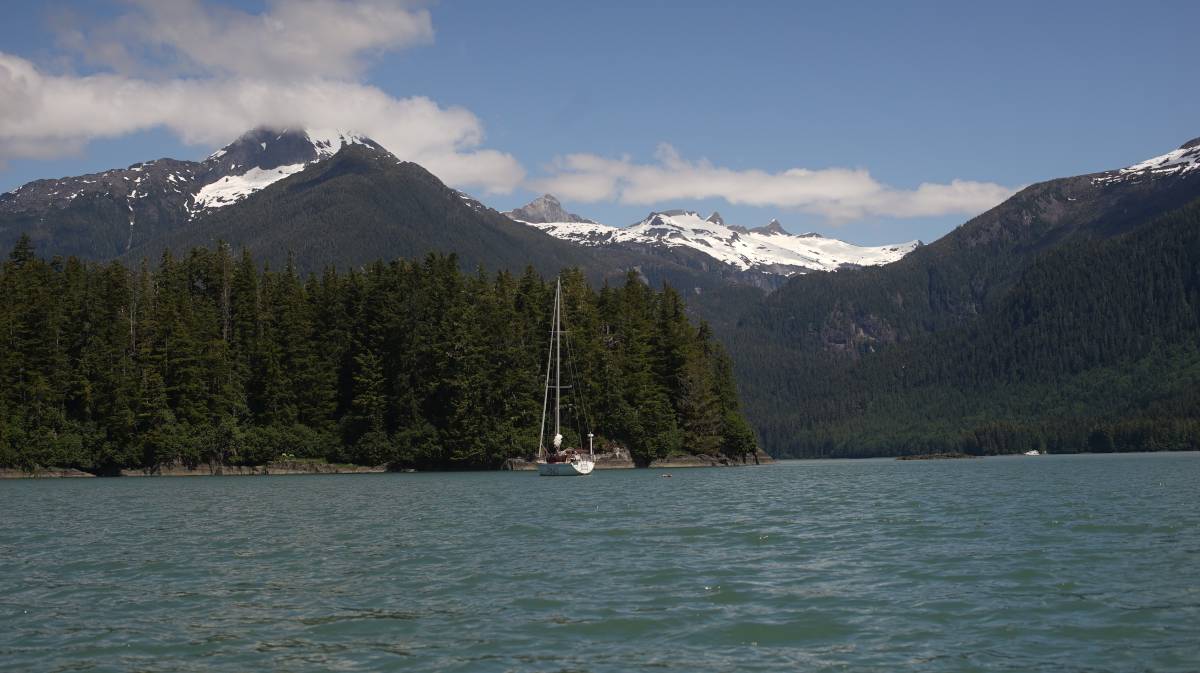 The current today was turning at 1100. We had breakfast, then dug out the Pennyboard to use as a rolling carrier to ferry a 20 L bin of diesel from the gas station and back to the boat. The skateboard could only accommodate 1 bin, but it worked quite well. We tied a bungee around the bin and board to secure it, and used a sail tie to pull the bin along. It was like taking a very toxic pet out for a walk. Everyone that walked past smiled at us — at our ingenuity no doubt(we hope). The current today was turning at 1100. We had breakfast, then dug out the Pennyboard to use as a rolling carrier to ferry a 20 L bin of diesel from the gas station and back to the boat. The skateboard could only accommodate 1 bin, but it worked quite well. We tied a bungee around the bin and board to secure it, and used a sail tie to pull the bin along. It was like taking a very toxic pet out for a walk. Everyone that walked past smiled at us — at our ingenuity no doubt(we hope). |
| We prepared lunch early, because we thought it nicer to eat in port than underway. When we set off, we raised the main while in the channel, but the forecast called for light winds for today, and for tomorrow. Light light light. The Race to Alaska participants were feeling this lack of wind too, it had been the most windless year to date. Many had to forfeit the race, their pedaling devices were not designed for continuous use. Even Dixon Entrance was asleep. We passed 2 tugs boats with heavy loads, and we saw another sailboat on the water for the first time since arriving in Southeast Alaska. The sailboat could motor faster than us, we trailed behind, but could observe their movements on AIS. They too were aiming for the entrance to Thomas Bay. |
|
| Before we reached the Sukoi Islets, we caught a glimpse of our very first glacier, tucked between two mountains and rising high above the water-side hills. It was too far to photograph well, but we could observe it well enough with binoculars. There was something deeply hypnotic about glaciers, a reminder of a time now past. Many glaciers were now receding, leaving beautiful formations behind, but few in the area lay on the water. With augmented eyes, we saw spikes in the glacier. This wondrous sight disappeared once we passed the islets. | |
| The sailboat we had been tracking on AIS got to the Thomas Bay entrance 1 hour before we did. The pass to Thomas Bay was restricted, a lot of water had to exit through this point. We noticed that their motoring speed of 7 kts had been reduced to a painful 2.1 kts. "Hmmm..." we both said aloud, "not sure we'll be able to get through." We figured we'd go see for ourselves, it was possible that the boat had slowed for other reasons. Our main and headsail were up, some light winds added 1 kt to our speed and stayed with us through the pass. Our speed initially was 5 kts, it only decreased to 3.4 kts — not too bad. The sailboat continued into the north arm, bound for Scenery Cove, while we turned east and then south towards Ruth Island Cove. The current stopped messing with our speed once we were clear of the pass. When entering, it felt like we were in the South Pacific again, entering an atoll. There were sand beaches on one side, hidden reefs everywhere, sunny skies... the coniferous trees and snow on the mountains quickly dispelled that reverie. |
|
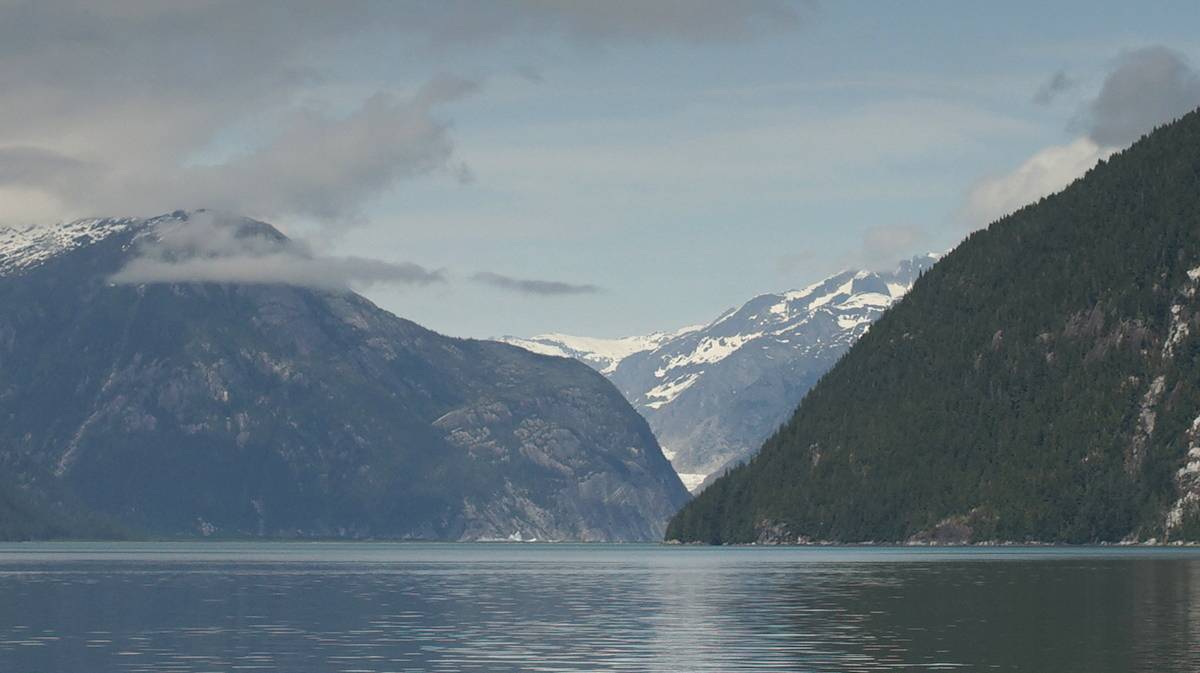 It was a long way around Ruth island, the pass to the south could have brought us there quicker, if it wasn't for the strong likelihood of a grounding — a grounding would slow our progress to the anchorage. The long way though, was beautiful. Even if we hadn't entered the north arm towards what remained of Baird Glacier, we could see some ice stranded on land, as well as part of the receding glacier up high in the mountains. The water here was, again, a striking jade color, so opaque, so clouded, that there was zero visibility. The mountains here were very tall, and the ones behind the ones bordering the water, even more so. The tall mountains all had snow on their peaks, we could see many from the water. It was a long way around Ruth island, the pass to the south could have brought us there quicker, if it wasn't for the strong likelihood of a grounding — a grounding would slow our progress to the anchorage. The long way though, was beautiful. Even if we hadn't entered the north arm towards what remained of Baird Glacier, we could see some ice stranded on land, as well as part of the receding glacier up high in the mountains. The water here was, again, a striking jade color, so opaque, so clouded, that there was zero visibility. The mountains here were very tall, and the ones behind the ones bordering the water, even more so. The tall mountains all had snow on their peaks, we could see many from the water. |
|
| When nearing Ruth Island Cove, we noticed many crab traps had been set in the water. Many, close to 50. The water was flat, it was easy to see them, but we couldn't believe how many traps there were... it was like the bay was full of floating garbage. Crabbing season in southeast Alaska began after June 15th, we had heard this, but hadn't realized that this bay was a hotspot. We made our way through the traps, hoping to find a spot amongst them... we laid our anchor down, but depending on the direction of our swing, some of the traps were quite close. | |
| Week 8 | |
| June 18th | Ruth Island Cove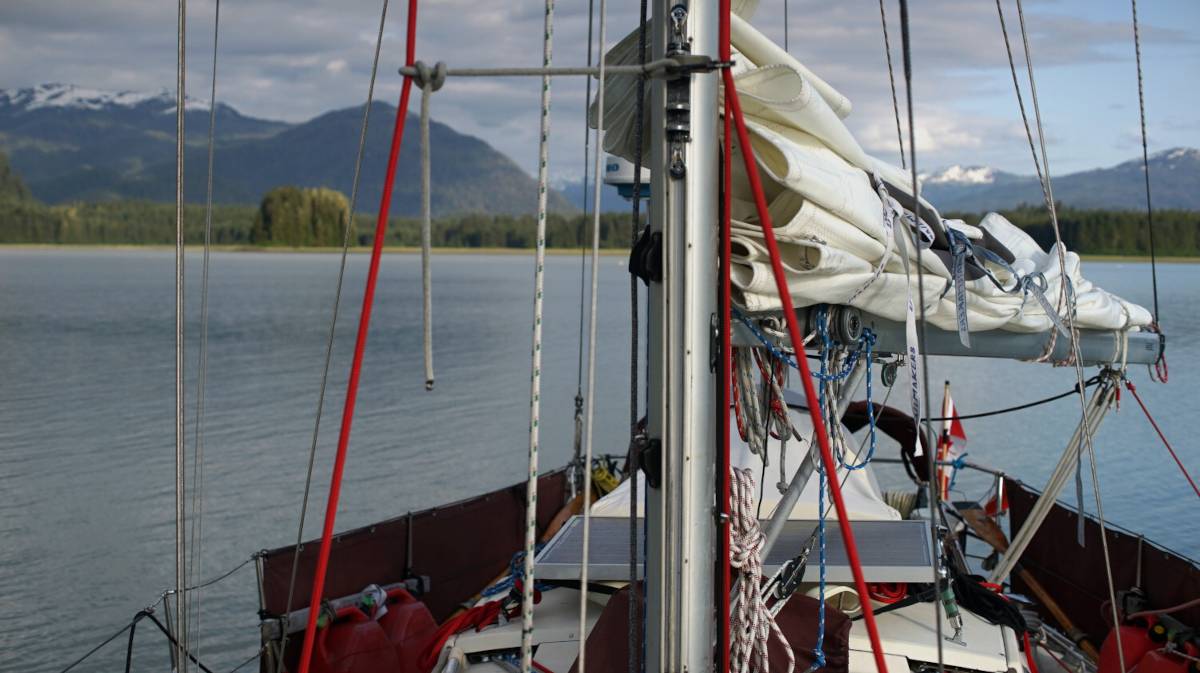 A quiet day at anchor. Some small runabouts came by to either take, or add, more crab traps, it was difficult to say what was changed, we weren't paying close attention, although the 2 traps nearest to us were untouched. A quiet day at anchor. Some small runabouts came by to either take, or add, more crab traps, it was difficult to say what was changed, we weren't paying close attention, although the 2 traps nearest to us were untouched.The sun was with us again today, I was able to solar cook some seitan, potatoes, brown rice and some split green peas. Unfortunately, the split green peas got mushy because I left there in the cooker for too long after falling asleep in Devine's arms. We ended up making a sort of weird-but-delicious green pasta sauce with the peas. |
| Another sailboat joined us in the bay, the same one that had gone to Scenery Cove yesterday. They found a spot free of crab pots. A big fishing boat came into the cove in the afternoon to pull up a few traps, many which were encircling our neighbor. As the fishermen picked up their traps, we could hear them conversing with the sailors. The fishermen offered them crab, tossing it over to them. We smiled at this, people on working boats here are really very sweet, and generous. We didn't spend too much time outside today because the air was thick with horseflies. There were always 3 of them hovering near us. Whenever we killed one, another came to bring the number back up to 3. We are not sure why there weren't ever more aboard at once, having more around was certainly not what we wanted, but it was strange, as if that they too agreed that more than 3 would be unreasonable. When one fell, a replacement was never far, we had little respite between killings. |
|
| The wind tomorrow will be too light to sail, it looks like we'll be sticking around a little longer. | |
| June 19th | Ruth Island Cove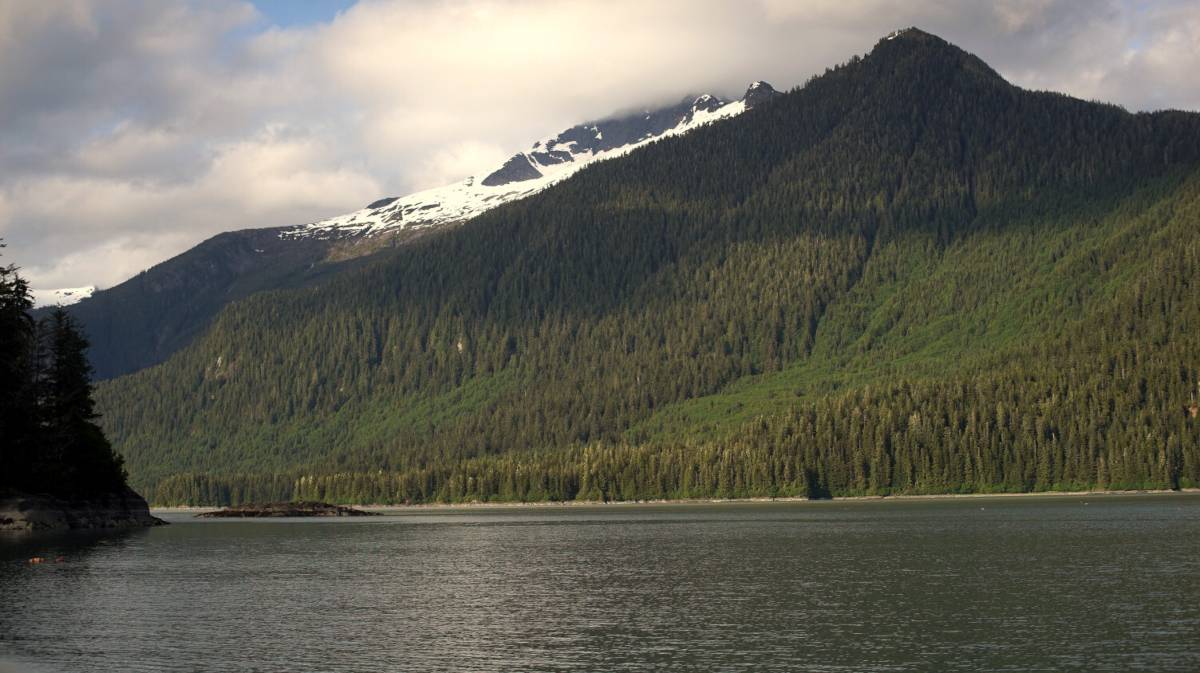 During the ice age, a glacier covered the entirety of Thomas Basin — that is crazy to think about. When we entered yesterday, we sailed over where its outermost face used to be. Now that it has receded, the only proof of its advancement was a boulder and gravel bank. A look at satellite photos revealed what was left of Baird Glacier; it was still there, perched between mountains, following the valleys, thick and frosted. Wild. During the ice age, a glacier covered the entirety of Thomas Basin — that is crazy to think about. When we entered yesterday, we sailed over where its outermost face used to be. Now that it has receded, the only proof of its advancement was a boulder and gravel bank. A look at satellite photos revealed what was left of Baird Glacier; it was still there, perched between mountains, following the valleys, thick and frosted. Wild. |
| Today, I solar-cooked some scrambled okonomiyaki(pancakes form doesn't fit in the cooker). It took approximately 90 minutes for the batter to cook. I prepared the okonomi sauce on our gas range, and tossed some chopped green onions over top. This recipe has a long cooking time, it uses a lot of gas when cooked indoors. For every meal we solar cook, we extend the use of our propane tank. | |
Devine went out for a row, doing their best to outrun the horseflies. They rowed past the southern point of Ruth Island, and went to see a house mounted on an anchored barge — a good setup in a very protected and scenic location, we wonder how they were able to do this. 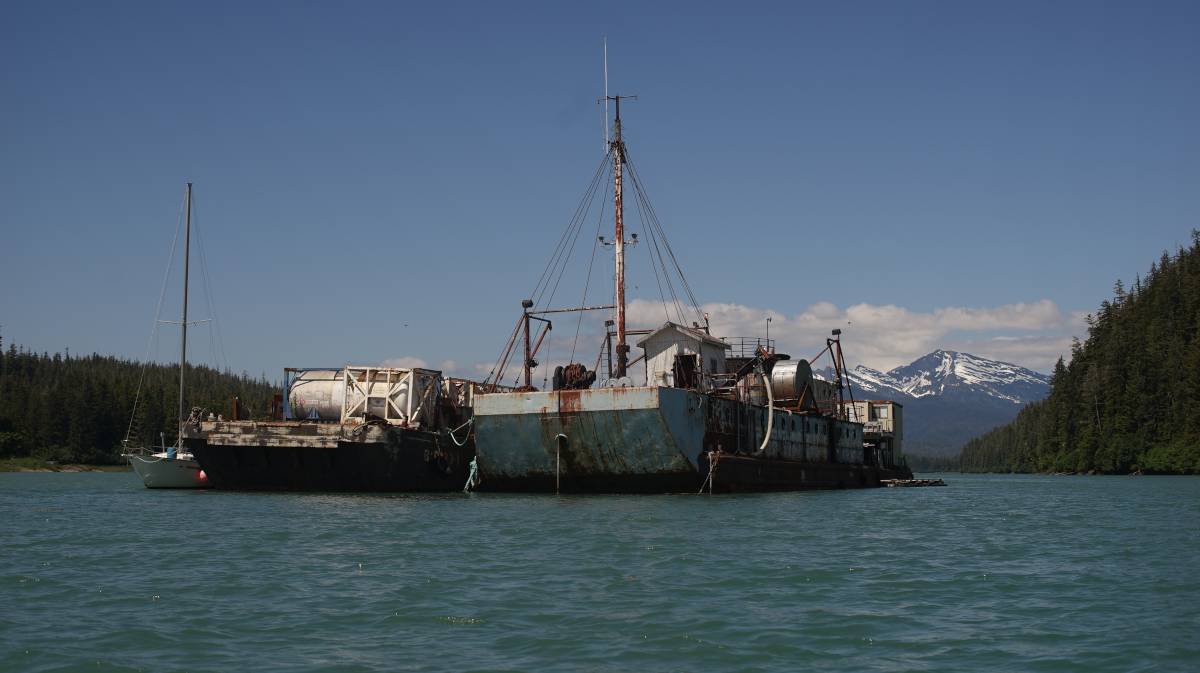 I went for a row too later that same day, by then the sailboat had left, but a motor boat took its place. I rowed around the cove, exploring all of the little shallow bights, trying to spot some birds. The flies were gone at this hour, I could relax and enjoy my time on the water without things trying to take chunks out of me. I returned aboard and found a cup of peppermint tea waiting on my desk — thank you Devine, my heart of hearts. I went for a row too later that same day, by then the sailboat had left, but a motor boat took its place. I rowed around the cove, exploring all of the little shallow bights, trying to spot some birds. The flies were gone at this hour, I could relax and enjoy my time on the water without things trying to take chunks out of me. I returned aboard and found a cup of peppermint tea waiting on my desk — thank you Devine, my heart of hearts. |
|
| June 20th | Ruth Island Cove to Portage Bay I woke up restless today, eager to move on. We stayed put until 1120, timing our exit with the ebb. The horseflies were around, ever-so-watchful, Devine was around too to keep them off my back while I raised the anchor. The forecast called for 10 knots out of the southwest, we thought this wind would help us get to Portage Bay, just a short hop away. When rounding Ruth Island, we spotted a gillnetter with its net in the water. This area was gorgeous, but it was also worked to death. |
| After rounding the top of Ruth Island, we took another look at Baird Glacier before the mountains swallowed up the scenery. The wind permitted for a bit of sailing, our mainsail was up, the jib was unfurled. Our angle was good for sailing out of the basin, but as soon as we passed the last pair of channel buoys, we had to start tacking into the wind, but 10 knots really isn't a lot of wind when sailing to weather. We had expected the wind to come from the back, but it was curling from over the top of Kupreanof Island — this is what happens when new to an area, our assumptions were often incorrect. | |
| We were only able to sail up to the Cape Strait light, then the wind went down but the waves were still up. We were very disappointed to have to motor the rest. We weren't going fast beating into those waves, this was annoying to us because we knew we had to get to the entrance to Portage Bay before the current turned. | |
| While motoring, we talked about Jean Cocteau's Les Enfants Terrible, a book I had just finished and that Devine had begun to read while underway. The ride was long, the book was short, Devine finished it before we arrived to Portage Bay. Two humpback whales were in our path, we weren't sure how to position ourselves to them, both were swimming ahead with the land laying very close to our port side, we slowed down and waited for them to make up their minds. |
|
| We arrived at the entrance at 1830, just in time to see another boat coming in... a sailboat! To our surprise, there were 2 other sailboats lying at anchor. So many sailboats! Aah! Of course, they had taken the more sheltered spots in the lee of East Pt, so we dropped anchor mid-channel in 12 m (40 ft). Our spot was slightly disturbed by small waves rolling in from the entrance, they soon diminished to ripples and then to nothing overnight. A brightly-lit fishing boat was anchored in the south anchorage, all by themself. | |
| June 21st | Portage Bay to Fanshaw Bay(duck point) The forecast changed to light northeast winds. Shit. "Whatever," we said, "we'll sail with whatever's out there." We were still restless, neither of us wanted to stay put today, and Portage Bay was not exactly noteworthy. When raising the anchor, we found many varieties of algae clinging onto the rope rode. The more rode I reeled in, the more kelp came up. The anchor had long lengths of algae tightly twisted around the fluke, like rope. I couldn't tear it with my hands so I focused on untangling it instead. Kelp is very, very strong, it's also not easy to untangle because of its slimy, slippery texture. We had seen a lot of kelp in the entrance channel coming in, it seems like the bottom here is also full of it. |
| The current wasn't in our favor when exiting, we knew it, but if we waited for the turn we'd be leaving the anchorage at 1400, too damn late to get anywhere. We worked against 1-1 1/2 knots of current, luckily, the entrance channel was short, we re-gained our regular cruising speed soon enough. The kelp that had bordered the channel the previous day was not as noticeable at low tide, they were all bunched up against the east shore. The wind was indeed light out there, but we kept the mainsail up... | |
| The ride to Fanshaw Bay was uneventful, we crossed many tide lines, all marked by amassments of algae and debris. Our speed varied a lot when crossing these lines, it would slow or increase depending on the direction of rotation of the various back eddies. I wished we'd had notes on back eddies for this area, knowing where they were would have saved us a lot of pain today. We turned our bow towards Duck Point in Fanshaw Bay. I didn't want to go there, it was a deep bay and was relatively open to weather, but supposedly protected from the southeast and northeast, but we had no other options, everything else was too far away. We knew we couldn't get to any other anchorage in the area without good wind. |
|
| When at Cape Fanshaw, the wind picked up for a moment, we thought we could make it further, to Henry's Arm, but as soon as we shut the engine and pointed our bow toward it, the wind went away. Pino turned back towards Duck Point, south east of Whitney Island, dissatisfied with today's wind. Another frustrating day on the water. Frederick Sound's eastern half was just too damn sheltered. | |
| We anchored near Duck Point in 20 m (67 ft) of water (HW), just as the rain started. We shared an NA drink inside and made plans for tomorrow. Devine lit a fire to lift some of the humidity, we hadn't used the woodstove in a while. A fishing boat joined us at anchor, even if the anchorage looked open on a chart, we had a calm night here. | |
| June 22nd | Fanshaw Bay to Chapin Bay We left Fanshaw Bay at 0700, persuading more kelp off our anchor chain. Some light rain accompanied us, the sky was grey, there was no break in it, no way for the sun to peek through. A light breeze propelled us on. We decided to head towards Chapin Bay today. Initially, our speed was good, but it then slowed as the current turned against us. The favorable current was at night, waiting until it eventually moved back into the day would cost us a lot of time, too much time. We had thought of heading towards Tracy Arm, but the forecasts for the area appeared too quiet and we didn't want to have to motor too much. We figured we'd have more wind if we moved towards Chatham Strait. We had our eyes on Sitka now, motoring would be necessary in that region because of Peril Strait, an area with rapids. |
| The sea had adopted the same coloring as the sky, making them indistinguishable from one another. Our eyes could find whales, fish and seabirds quickly in this calm, anything breaking the surface of the mirror beneath us was known to us. A bit of fog rolled in later, masking the land around us. I read Beryl Markham's West With the Night aloud to Devine as they steered in the rain and gloom. Reading about Nairobi, lions, and hot sands warmed our flesh. I read to Devine whenever it wasn't my time to steer, taking shelter from the light rain in the companionway. |
The sun peered out a few times, but was quickly blanketed with a thick cloud duvet. During one short warm moment, the sun hitting the mini-bini(what we call our small bimini) was evaporating lingering moisture off of the fabric. At first, I thought the steam was exhaust, a lot of exhaust, I was about to panic before my nose confirmed to my eyes that it wasn't, "no panic no smell, none!" my nose reassured me. |
| When our destination was finally in view, it was encouraging, but it also took an awfully long time before we got near enough to it to note any changes in scale or perspective. Because it appeared not to change, the way there felt unending, like we were standing still. I always wondered if maybe the current had suddenly risen against us, had immobilized us. Spending just 5 minutes inside the cabin was time enough to allow our eyes to register a change. No, this wasn't limbo, we weren't dead. Time sped up when we were away from the helm. | |
| Some belated, but welcome, wind pushed us into the entrance channel. We rounded the spit of land and anchored in its protected waters. This place was beautiful, like all places we'd visited so far, but not in the same way. No place was beautiful in the same way. All had a distinctive character, something that they alone possessed. This particular anchorage was bordered by tall mountains, one mountain was topped by a rock with a large hole in its middle. The eye of the mountain watches always. Unfortunately, like Fanshaw Bay, the water here was 20 m (67 ft) deep. After some miscommunication with Devine when setting the anchor, I pinched the index finger of my right hand between the chain and chain-stopper. The right side of my finger turned a dull, grey, rather dead color, the discoloration spread to the area under my nail bed. Yuk. |
|
| We kept hoping we wouldn't have to motor to every anchorage, but the wind in this area was too damn fickle. It was worrisome, we couldn't keep using the engine like this. Tomorrow, we'd wake up early to catch the tide out, and we'd sail as far as we could until it turned against us at 1530. | |
| June 23rd | Chapin Bay As planned, we got up at 0430, turned on the VHF radio to listen to the updated wind forecast for Chatham Strait. The wind was very light, and was meant to rise to 10 knots out of the south. This usually meant no wind, especially if it started from light... so, we returned to our warm bed. Pino and crew demanded more weather. |
| We saw many lion's mane jellyfish in this bay, their bright orange star-shaped dome and pink tentacles made them easy to spot in the water. They drifted past, content, unbothered by the absence of wind, the current was their highway. While trying to get weather data via our satellite phone as a test, I saw a small deer walking along the shore. There was a bit of wind in the early afternoon, but it didn't last. I tried solar-cooking some lentils, but I had to finish cooking them indoors because the cloud coverage got too thick. Sometimes, the solar cooker performs even with cloud cover, but it needs to be thin so that the dimmed sun can still shine through. |
|
| The forecast for the week looked bleak, wind-wise. Southeast Alaska was heaven for motor boats, hell for us. Calm weather was lovely when at anchor, but being forced to motor for hours on end was torture, it was a chore. This place was not a good playground for our vessel. | |
| Devine went out for a row around the bay while I continued fiddling with the SAT phone. I could not get it to receive data due to some confusion with the interface and account configuration. In the end, I was able to successfully download a GRIB file. GRIB files weren't useful in protected channels, but would be useful when sailing south down the west coast of Baranof Island. One of the wind models seemed to indicate wind for tomorrow, light in the morning and building to 10-15 knots out of the southwest throughout the day. Ideal. We needed some calm to round the southwest corner of Admiralty Island before sailing north into Chatham Strait. Frederick Sound was often devoid of wind anyway, we expected to have to motor to the corner to catch a worthwhile breeze. We hoped the wind would be there to meet us, otherwise we would have to find an anchorage to duck into, burning more diesel all the while... burn burn burn. | |
| That evening, we played a memory game, then went to bed at around 1000. The sky was still somewhat bright at that hour, we were past the summer solstice, the days were now getting shorter. | |
| June 24th | Chapin Bay to Eva Islands Up at 0600, gone at 0630. The water was calm, raising the anchor from the depths wasn't too difficult, although we were assaulted by our usual fan club of biting midges. We were at their mercy, our hands were all occupied. They liked wet and grey mornings, when the weather was hot they'd vanish and the horseflies would take their place. No weather in this region was safe from biting insects. A rain cloud followed us out of the anchorage, but never reached us. Fog began to form in southern Chatham Strait, snaking along the southern shore of Frederick Sound. For now, it was a distant concern for us. We passed the lighthouse on the southwest point of Admiralty Island, then switched off the engine, determined not to use it again until we reached our planned anchorage at the entrance to Peril Strait. The wind was light at first, but with the current in our favor we progressed northward at a good speed. |
| We kept an eye on the growing fog bank at our stern, it had begun to creep down nearby hills, ghostly fingers reaching for passing vessels, eager to swallow them up. It ate many southbound power boats, keeping them trapped in its veil. We escape the fog, staying ahead of it the whole way, or so we thought (the fog was waiting for us in Peril Strait). | |
| We sailed up to the latitude of Cut throat Creek, halfway up Catherine Island. The land diverted the wind from our port and over to our starboard stern quarter a few times. Downwind sails were always nice, the motion was calm, we could enjoy hot drinks without fear of spills, the pull on the tiller was weak. We missed wind like this. We kept our promise and sailed most of the way, but we arrived at the mouth of Peril Strait a bit later than we had planned, the current turned at 1600, just as we'd reached the south of Thatcher Point. By the time we motored through Thatcher Channel, we had 0.60 knots of current running against us, and it would continue to rise until 1800 if we didn't hurry. Calcifer did its very best, but in the end we decided to forego anchoring in Hanus Bay in favor of the Eva Islands. Motoring to our planned anchorage with an opposing current was not very appealing, and as I said earlier, fog was waiting for us in the strait up ahead. As well as being unplanned, this was place 22 m (72 ft) deep at high water, the deepest we had anchored in so far. Once at 60 m (200 ft) of rode, paying it out was difficult, the rope rode was too light and didn't want to leave the boat. It kept twisting, laying limp in the water. Paying out the chain was easier because of its weight, rope rode was ok too usually, but when the required length exceeded 53 m (175 ft), I had to force it off the boat. We set the anchor in less rode, then paid out the rest to meet the highest possible tide while aiming for a ratio of 3:1, like always. |
|
| No one else was anchored here. On ais we saw a National Geographic vessel anchored in Hanus Bay, we saw other targets anchored further in the pass. Devine made a fire to warm our space, and I prepared a hearty miso rice noodle soup for dinner to further amass warmth. We had sailed 44.7 NM today, making big leaps with a following wind was not difficult, it took less out of us than when sailing to weather. Although, it was difficult to relax because as soon as we arrived in the Eva Islands anchorage, Pino was under siege. Hundreds of biting midges were hovering outside, we couldn't get out of the cabin, and somehow, despite having insect screens on every hatch, they were finding their way inside. For a while we had at least 50 hovering indoors. We stuffed rags in all of the possible openings, and Devine taped over tiny cracks while I crossed swords with the soldiers already inside our space. We were battleworn, tape was our last ditch effort to secure our fort against these fiends. "I don't know how we're going to raise the anchor in the morning tomorrow," I said, exasperated, "if their numbers hold..." We usually had 10-20 to contend with at once, but tonight the air outside was thick with them. Fly-induced nighttime. We didn't usually have to contend with such enormous swarms. Keeping mosquitoes and horseflies out was never an issue, but these things could walk through tiny cracks. In the end, our desperate, but aggressive fortifications were sufficient, the insect world and Pino's cabin were separate again. We scraped many tiny bodies off the walls, and went to bed. |
|
More coming soon...